Craftsman Yt 4500 Operators Manual
CRAFTSMAN Lawn, Tractor Manual L0901666 CRAFTSMAN Lawn, Tractor Owner's Manual, CRAFTSMAN Lawn, Tractor installation guides
2015-01-05
: Craftsman Craftsman-Yt-4500-Operators-Manual-160481 craftsman-yt-4500-operators-manual-160481 craftsman pdf
Open the PDF directly: View PDF ![]() .
.
Page Count: 68
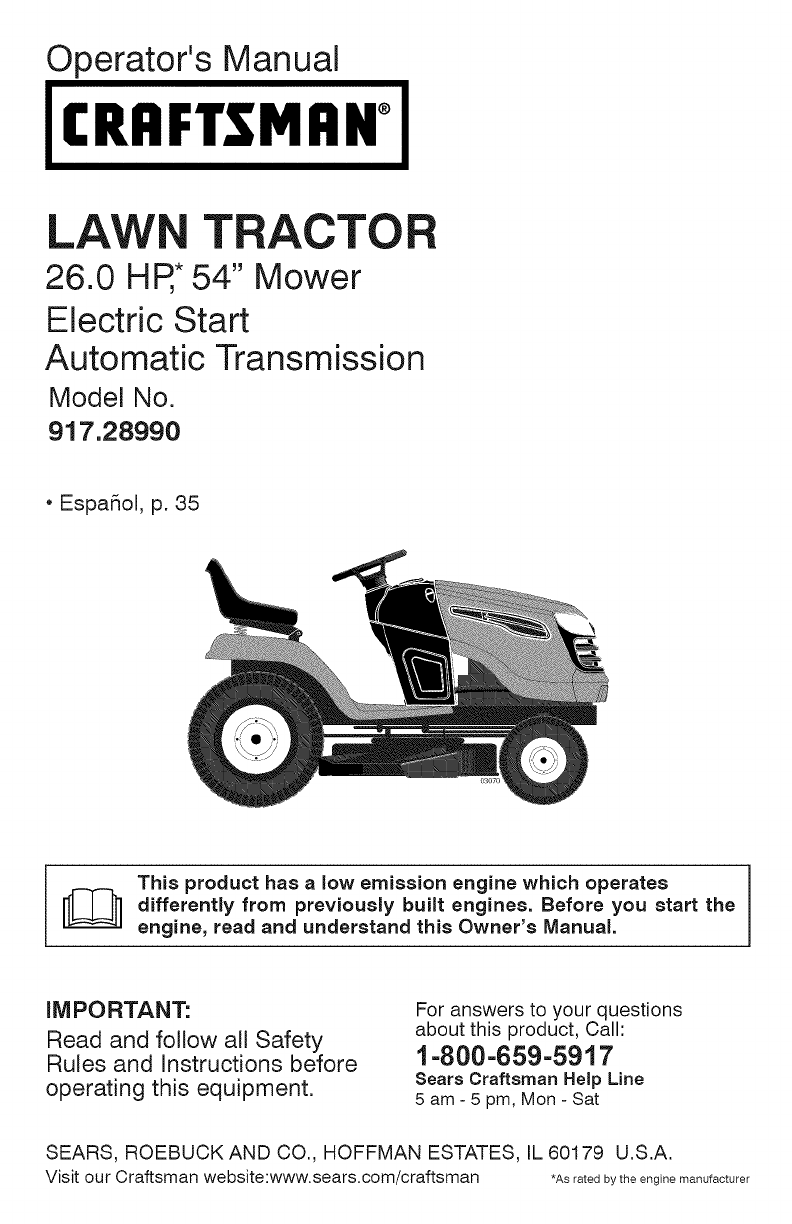
Operator's Manual
CRAFTSMAN°
LAW TRACTOR
26.0 HR* 54" Mower
Electric Start
Automatic Transmission
Model No.
917.28990
,EspaSol, p. 35
I
This product has a low emission engine which operates I
differently from previously built engines. Before you start the Iengine, read and understand this Owner's Manual.
iMPORTANT:
Read and follow all Safety
Rules and instructions before
operating this equipment.
For answers to your questions
about this product, Call:
1-800 -659-5917
Sears Craftsman Help Line
5 am- 5 pm, Mon - Sat
SEARS, ROEBUCK AND CO., HOFFMAN ESTATES, IL 60179 U.S.A.
Visit our Craftsman website:www.sears.com/craftsman *Asratedbytheenginemanufacturer
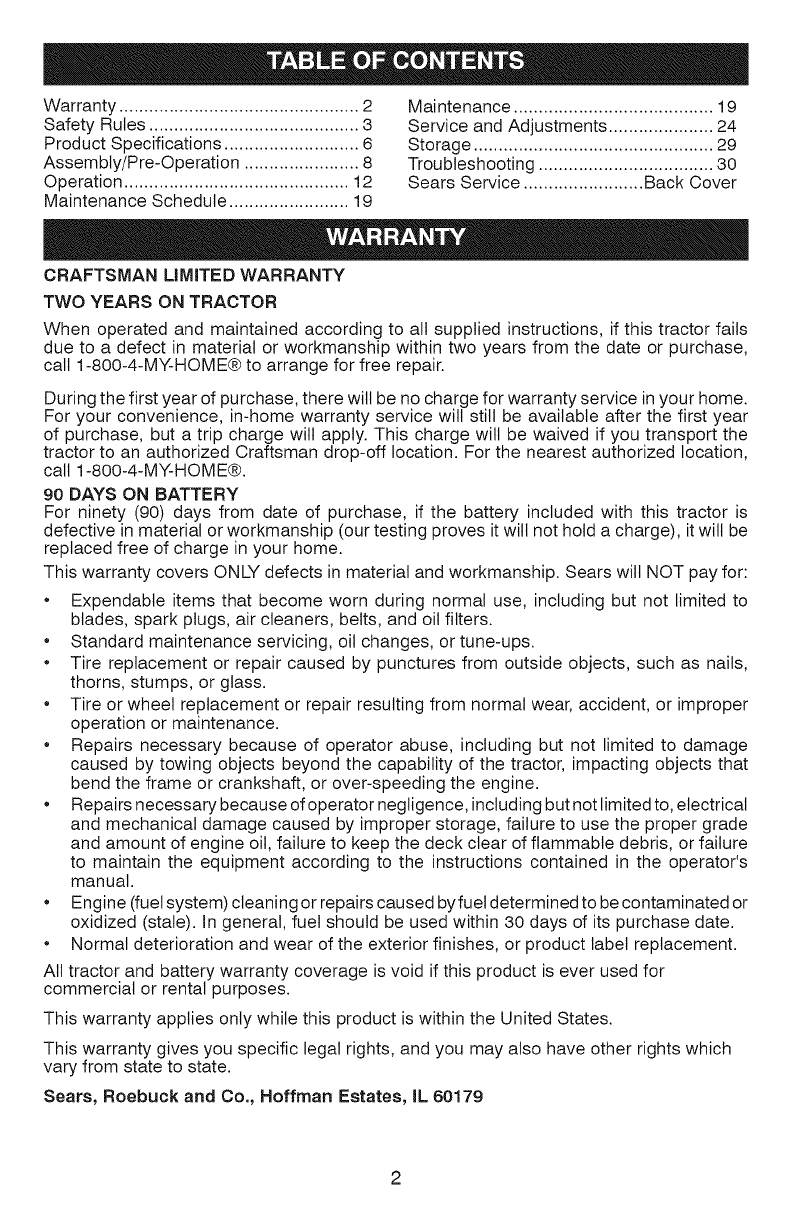
Warranty ................................................ 2
Safety Rules .......................................... 3
Product Specifications ........................... 6
Assembty/Pre-Operation ....................... 8
Operation ............................................. 12
Maintenance Schedule ........................ 19
Maintenance ........................................ 19
Service and Adjustments ..................... 24
Storage ................................................ 29
Troubleshooting ................................... 30
Sears Service ........................ Back Cover
CRAFTSMAN LIMITED WARRANTY
TWO YEARS ON TRACTOR
When operated and maintained according to all supplied instructions, if this tractor fails
due to a defect in material or workmanship within two years from the date or purchase,
call 1-800-4-MY-HOME® to arrange for free repair.
During the first year of purchase, there will be no charge for warranty service in your home.
For your convenience, in-home warranty service will still be available after the first year
of purchase, but a trip charge wilt apply. This charge will be waived if you transport the
tractor to an authorized Craftsman drop-off location. For the nearest authorized location,
call 1-800-4-MY-HOME®.
90 DAYS ON BATTERY
For ninety (90) days from date of purchase, if the battery included with this tractor is
defective in material or workmanship (our testing proves it will not hold a charge), it will be
replaced free of charge in your home.
This warranty covers ONLY defects in material and workmanship. Sears will NOT pay for:
Expendable items that become worn during normal use, including but not limited to
blades, spark plugs, air cleaners, belts, and oil filters.
Standard maintenance servicing, oil changes, or tune-ups.
Tire replacement or repair caused by punctures from outside objects, such as nails,
thorns, stumps, or glass.
Tire or wheel replacement or repair resulting from normal wear, accident, or improper
operation or maintenance.
Repairs necessary because of operator abuse, including but not limited to damage
caused by towing objects beyond the capability of the tractor, impacting objects that
bend the frame or crankshaft, or over-speeding the engine.
Repairs necessary because of operator negligence, including but not limited to, electrical
and mechanical damage caused by improper storage, failure to use the proper grade
and amount of engine oil, failure to keep the deck clear of flammable debris, or failure
to maintain the equipment according to the instructions contained in the operator's
manual.
Engine (fuel system) cleaning or repairs caused by fuel determined to be contaminated or
oxidized (stale). In general, fuel should be used within 30 days of its purchase date.
Normal deterioration and wear of the exterior finishes, or product label replacement.
All tractor and battery warranty coverage is void if this product is ever used for
commercial or rental purposes.
This warranty applies only while this product is within the United States.
This warranty gives you specific legal rights, and you may also have other rights which
vary from state to state.
Sears, Roebuck and Co,, Noffman Estates, IL 60179
2
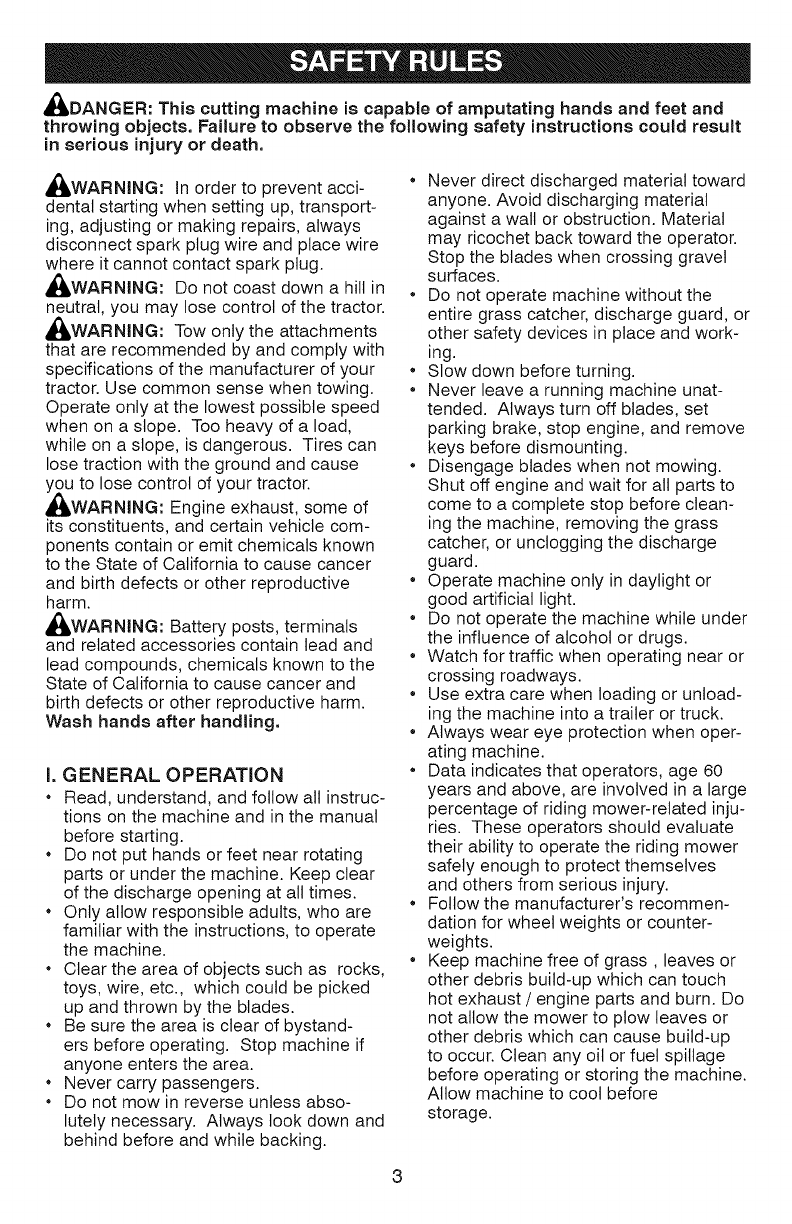
_DANGER: This cutting machine is capable of amputating hands and feet and
throwing objects. Failure to observe the following safety instructions could result
in serious injury or death.
_WARNING: In order to prevent acci-
dental starting when setting up, transport-
ing, adjusting or making repairs, always
disconnect spark plug wire and place wire
where it cannot contact spark plug.
_,WARNING: Do not coast down a hill in
neutral, you may lose control of the tractor.
_,WARNING: Tow only the attachments
that are recommended by and comply with
specifications of the manufacturer of your
tractor. Use common sense when towing.
Operate only at the lowest possible speed
when on a slope. Too heavy of a load,
while on a slope, is dangerous. Tires can
lose traction with the ground and cause
you to lose control of your tractor.
_kWARNING: Engine exhaust, some of
its constituents, and certain vehicle com-
ponents contain or emit chemicals known
to the State of California to cause cancer
and birth defects or other reproductive
harm.
_,WARNING: Battery posts, terminals
and related accessories contain lead and
lead compounds, chemicals known to the
State of California to cause cancer and
birth defects or other reproductive harm.
Wash hands after handling.
I. GENERAL OPERATION
•Read, understand, and follow all instruc-
tions on the machine and in the manual
before starting.
Do not put hands or feet near rotating
parts or under the machine. Keep clear
of the discharge opening at all times.
Only allow responsible adults, who are
familiar with the instructions, to operate
the machine.
Clear the area of objects such as rocks,
toys, wire, etc., which could be picked
up and thrown by the blades.
Be sure the area is clear of bystand-
ers before operating. Stop machine if
anyone enters the area.
Never carry passengers.
Do not mow in reverse unless abso-
lutely necessary. Always look down and
behind before and while backing.
Never direct discharged material toward
anyone. Avoid discharging material
against a wall or obstruction. Material
may ricochet back toward the operator.
Stop the blades when crossing gravel
surfaces.
Do not operate machine without the
entire grass catcher, discharge guard, or
other safety devices in place and work-
ing.
Slow down before turning.
Never leave a running machine unat-
tended. Always turn off blades, set
parking brake, stop engine, and remove
keys before dismounting.
Disengage blades when not mowing.
Shut off engine and wait for all parts to
come to a complete stop before clean-
ing the machine, removing the grass
catcher, or unclogging the discharge
guard.
Operate machine only in daylight or
good artificial light.
Do not operate the machine while under
the influence of alcohol or drugs.
Watch for traffic when operating near or
crossing roadways.
Use extra care when loading or unload-
ing the machine into a trailer or truck.
Always wear eye protection when oper-
ating machine.
Data indicates that operators, age 60
years and above, are involved in a large
percentage of riding mower-related inju-
ries. These operators should evaluate
their ability to operate the riding mower
safely enough to protect themselves
and others from serious injury.
Follow the manufacturer's recommen-
dation for wheel weights or counter-
weights.
Keep machine free of grass, leaves or
other debris build-up which can touch
hot exhaust /engine parts and burn. Do
not allow the mower to plow leaves or
other debris which can cause build-up
to occur. Clean any oil or fuel spillage
before operating or storing the machine.
Allow machine to cool before
storage.
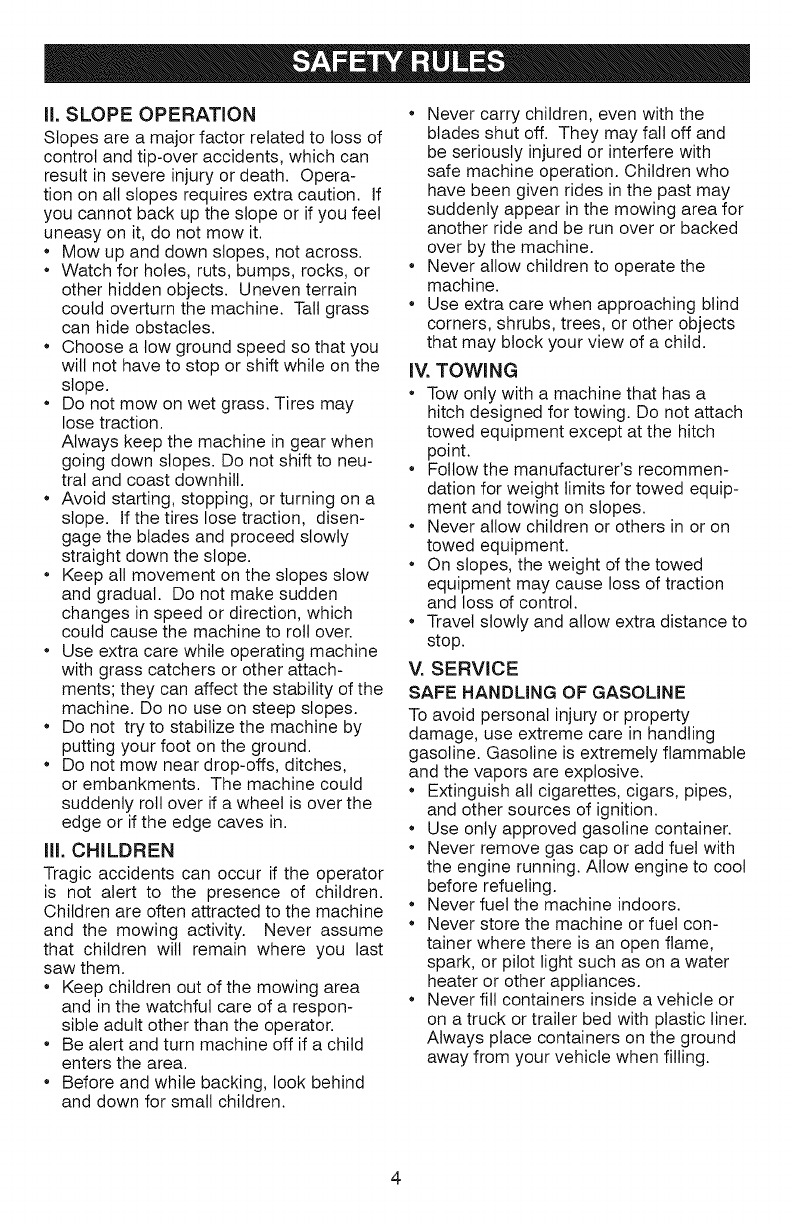
II.SLOPEOPERATION
Slopesareamajorfactorrelatedtotossof
controlandtip-overaccidents,whichcan
resultinsevereinjuryordeath.Opera-
tiononallslopesrequiresextra caution. If
you cannot back up the slope or if you feet
uneasy on it, do not mow it.
• Mow up and down slopes, not across.
• Watch for holes, ruts, bumps, rocks, or
other hidden objects. Uneven terrain
could overturn the machine. Tall grass
can hide obstacles.
• Choose a low ground speed so that you
will not have to stop or shift while on the
slope.
• Do not mow on wet grass. Tires may
lose traction.
Always keep the machine in gear when
going down slopes. Do not shift to neu-
tral and coast downhill.
• Avoid starting, stopping, or turning on a
slope. If the tires lose traction, disen-
gage the blades and proceed slowly
straight down the slope.
• Keep all movement on the slopes stow
and gradual. Do not make sudden
changes in speed or direction, which
could cause the machine to roll over.
• Use extra care while operating machine
with grass catchers or other attach-
ments; they can affect the stability of the
machine. Do no use on steep slopes.
• Do not try to stabilize the machine by
putting your foot on the ground.
• Do not mow near drop-offs, ditches,
or embankments. The machine could
suddenly roll over if a wheel is over the
edge or if the edge caves in.
Ill. CHILDREN
Tragic accidents can occur if the operator
is not alert to the presence of children.
Children are often attracted to the machine
and the mowing activity. Never assume
that children will remain where you last
saw them.
• Keep children out of the mowing area
and in the watchful care of a respon-
sible adult other than the operator.
• Be alert and turn machine off if a child
enters the area.
• Before and while backing, look behind
and down for small children.
• Never carry children, even with the
blades shut off. They may fall off and
be seriously injured or interfere with
safe machine operation. Children who
have been given rides in the past may
suddenly appear in the mowing area for
another ride and be run over or backed
over by the machine.
• Never allow children to operate the
machine.
• Use extra care when approaching blind
corners, shrubs, trees, or other objects
that may block your view of a child.
IV. TOWING
• Tow only with a machine that has a
hitch designed for towing. Do not attach
towed equipment except at the hitch
point.
• Follow the manufacturer's recommen-
dation for weight limits for towed equip-
ment and towing on slopes.
• Never allow children or others in or on
towed equipment.
• On slopes, the weight of the towed
equipment may cause loss of traction
and loss of control.
• Travel slowly and allow extra distance to
stop.
V. SERVICE
SAFE HANDLING OF GASOLINE
To avoid personal injury or property
damage, use extreme care in handling
gasoline. Gasoline is extremely flammable
and the vapors are explosive.
• Extinguish all cigarettes, cigars, pipes,
and other sources of ignition.
• Use only approved gasoline container.
• Never remove gas cap or add fuel with
the engine running. Allow engine to cool
before refueling.
• Never fuel the machine indoors.
• Never store the machine or fuel con-
tainer where there is an open flame,
spark, or pilot light such as on a water
heater or other appliances.
• Never fill containers inside a vehicle or
on a truck or trailer bed with plastic liner.
Always place containers on the ground
away from your vehicle when filling.
4
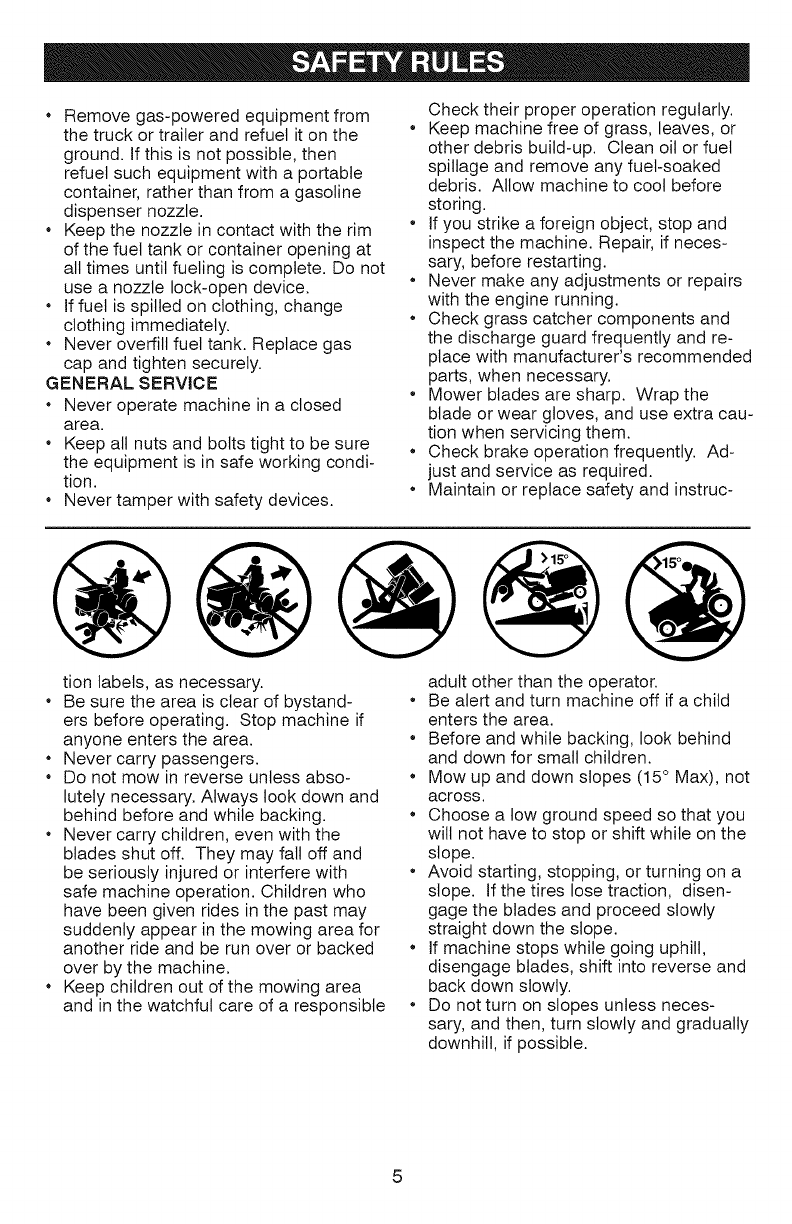
Removegas-poweredequipmentfrom
thetruckortrailerandrefuelitonthe
ground.Ifthisisnotpossible,then
refuelsuchequipmentwithaportable
container,ratherthanfromagasoline
dispensernozzle.
Keepthenozzleincontactwiththerim
ofthefueltankorcontaineropeningat
alltimesuntilfuelingiscomplete.Donot
useanozzlelock-opendevice.
Iffuelisspilledonclothing,change
clothingimmediately.
Neveroverfillfueltank.Replacegas
capandtightensecurely.
GENERALSERVICE
•Never operate machine in a closed
area.
• Keep all nuts and bolts tight to be sure
the equipment is in safe working condi-
tion.
• Never tamper with safety devices.
Check their proper operation regularly.
Keep machine free of grass, leaves, or
other debris build-up. Clean oil or fuel
spillage and remove any fuel-soaked
debris. Allow machine to cool before
storing.
If you strike a foreign object, stop and
inspect the machine. Repair, if neces-
sary, before restarting.
Never make any adjustments or repairs
with the engine running.
Check grass catcher components and
the discharge guard frequently and re-
place with manufacturer's recommended
parts, when necessary.
Mower blades are sharp. Wrap the
blade or wear gloves, and use extra cau-
tion when servicing them.
Check brake operation frequently. Ad-
just and service as required.
Maintain or replace safety and instruc-
tion labels, as necessary.
Be sure the area is clear of bystand-
ers before operating. Stop machine if
anyone enters the area.
Never carry passengers.
Do not mow in reverse unless abso-
lutely necessary. Always look down and
behind before and while backing.
Never carry children, even with the
blades shut off. They may fall off and
be seriously injured or interfere with
safe machine operation. Children who
have been given rides in the past may
suddenly appear in the mowing area for
another ride and be run over or backed
over by the machine.
Keep children out of the mowing area
and in the watchful care of a responsible
adult other than the operator.
Be alert and turn machine off if a child
enters the area.
Before and while backing, look behind
and down for small children.
Mow up and down slopes (15° Max), not
across.
Choose a low ground speed so that you
will not have to stop or shift while on the
slope.
Avoid starting, stopping, or turning on a
slope. If the tires lose traction, disen-
gage the blades and proceed slowly
straight down the slope.
If machine stops while going uphill,
disengage blades, shift into reverse and
back down slowly.
Do not turn on slopes unless neces-
sary, and then, turn slowly and gradually
downhill, if possible.
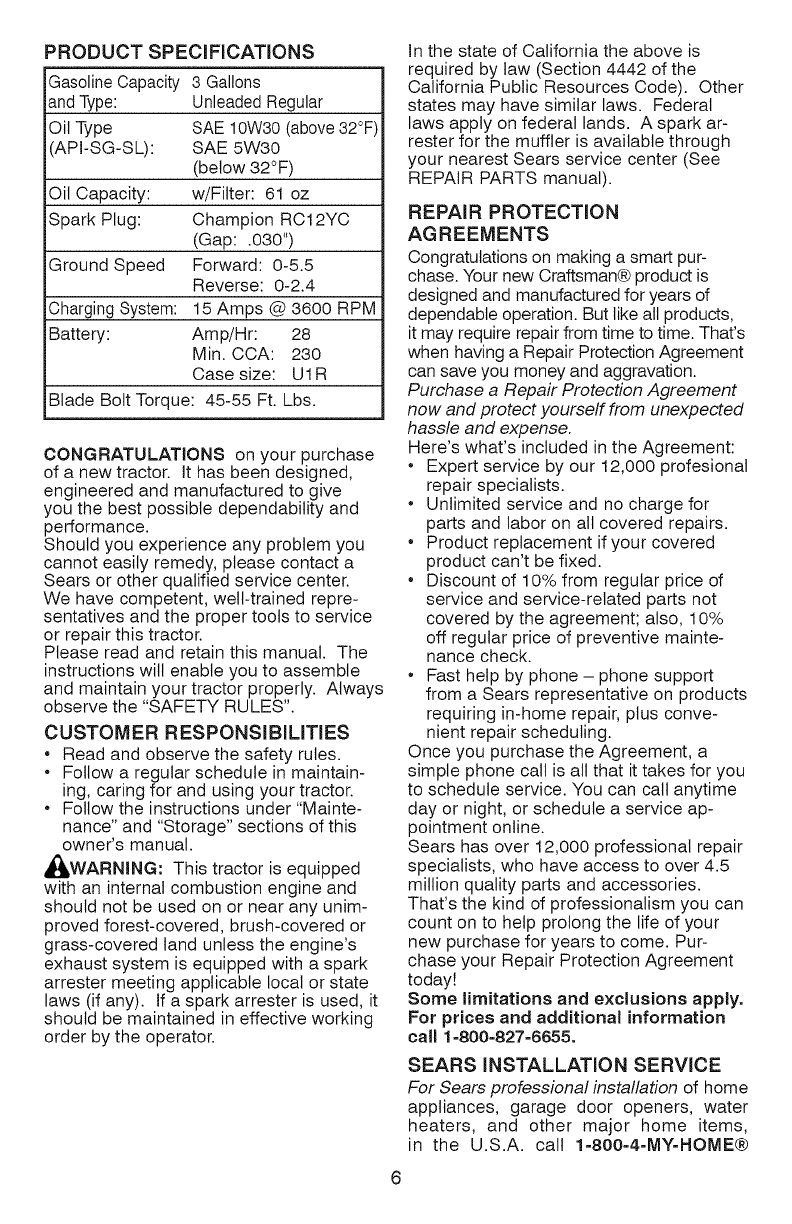
PRODUCTSPECIFiCATiONS
Gasoline Capacity 3 Gallons
and Type: Unleaded Regular
Oil Type SAE 10W30 (above 32°F)
API-SG-SL): SAE 5W30
(below 32°F)
Oil Capacity: w/Filter: 61 oz
Spark Plug: Champion RC12YC
(Gap: .030")
Ground Speed Forward: 0-5.5
Reverse: 0-2.4
Charging System: 15 Amps @ 3600 RPM
Battery: Amp/Hr: 28
Min. CCA: 230
Case size: U1R
Blade Bolt Torque: 45-55 Ft. Lbs.
CONGRATULATIONS on your purchase
of a new tractor. It has been designed,
engineered and manufactured to give
you the best possible dependability and
performance.
Should you experience any problem you
cannot easily remedy, please contact a
Sears or other qualified service center.
We have competent, well-trained repre-
sentatives and the proper tools to service
or repair this tractor.
Please read and retain this manual. The
instructions wilt enable you to assemble
and maintain your tractor properly. Always
observe the "SAFETY RULES".
CUSTOMER RESPONSIBILITIES
* Read and observe the safety rules.
* Follow a regular schedule in maintain-
ing, caring for and using your tractor.
* Follow the instructions under "Mainte-
nance" and "Storage" sections of this
owner's manual.
_bWARNING: This tractor is equipped
with an internal combustion engine and
should not be used on or near any unim-
proved forest-covered, brush-covered or
grass-covered land unless the engine's
exhaust system is equipped with a spark
arrester meeting applicable local or state
laws (if any). If a spark arrester is used, it
should be maintained in effective working
order by the operator.
6
In the state of California the above is
required by taw (Section 4442 of the
California Public Resources Code). Other
states may have similar laws. Federal
laws apply on federal lands. A spark ar-
rester for the muffler is available through
your nearest Sears service center (See
REPAIR PARTS manual).
REPAIR PROTECTION
AGREEMENTS
Congratulations on making a smart pur-
chase. Your new Craftsman® product is
designed and manufactured for years of
dependable operation. But like all products,
it may require repair from time to time. That's
when having a Repair Protection Agreement
can save you money and aggravation.
Purchase a Repair Protection Agreement
now and protect yourself from unexpected
hassle and expense.
Here's what's included in the Agreement:
Expert service by our 12,000 profesional
repair specialists.
Unlimited service and no charge for
parts and labor on all covered repairs.
Product replacement if your covered
product can't be fixed.
Discount of 10% from regular price of
service and service-related parts not
covered by the agreement; also, 10%
off regular price of preventive mainte-
nance check.
Fast help by phone - phone support
from a Sears representative on products
requiring in-home repair, plus conve-
nient repair scheduling.
Once you purchase the Agreement, a
simple phone call is all that it takes for you
to schedule service. You can call anytime
day or night, or schedule a service ap-
pointment online.
Sears has over 12,000 professional repair
specialists, who have access to over 4.5
million quality parts and accessories.
That's the kind of professionalism you can
count on to help prolong the life of your
new purchase for years to come. Pur-
chase your Repair Protection Agreement
today!
Some limitations and exclusions apply,
For prices and additional information
call 1-800-827-6655,
SEARS INSTALLATION SERVICE
For Sears professional installation of home
appliances, garage door openers, water
heaters, and other major home items,
in the U.S.A. call 1-800-4-MY-HOME®
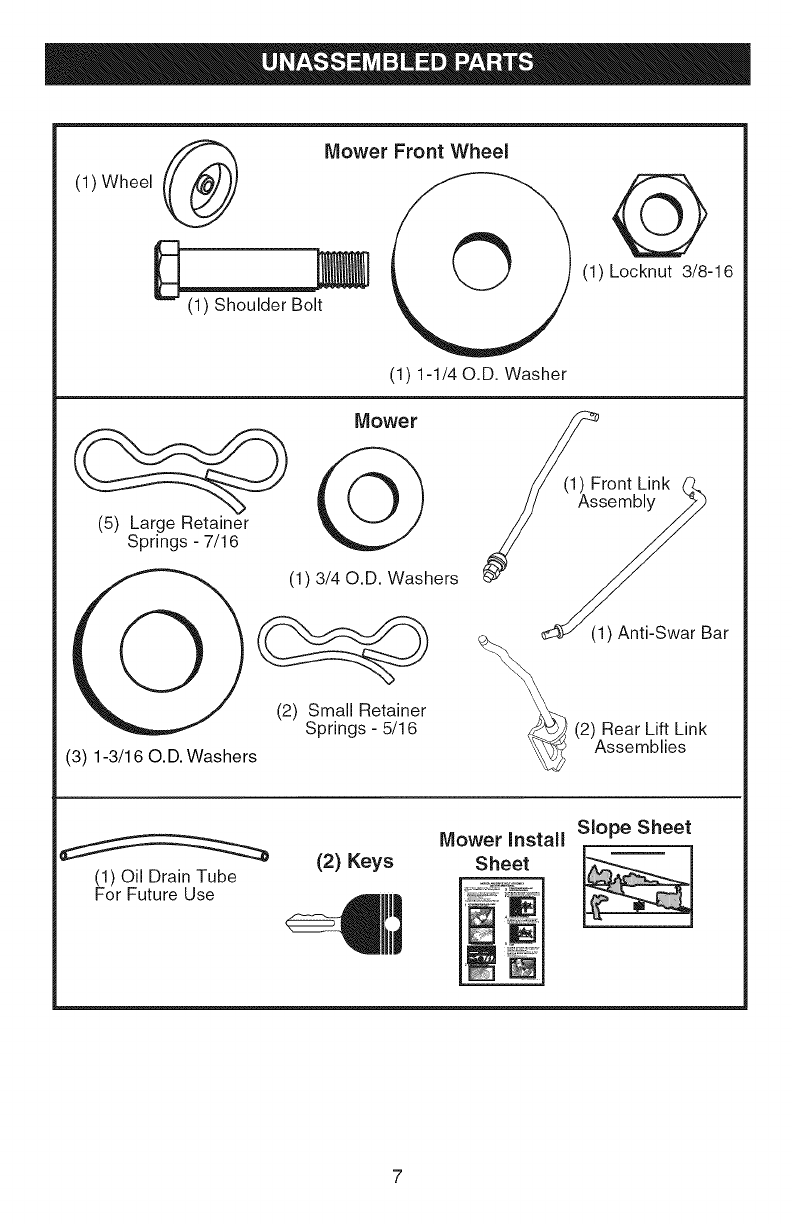
(1)Wheel@
Mower Front Wheel
(1) 1-1/40.D. Washer
@
(1) Locknut 3/8-16
Mower
(5) Large Retainer
Springs - 7/16
(1) 3/40.D. Washers
(2) Small Retainer
Springs - 5/16
(3) 1-3/16 O.D. Washers
(1) Front Link (_.
(1) Anti-Swar Bar
(2) Rear Lift Link
Assemblies
(1) Oil Drain Tube
For Future Use
(2) Keys
Mower Install Slope Sheet
Sheet
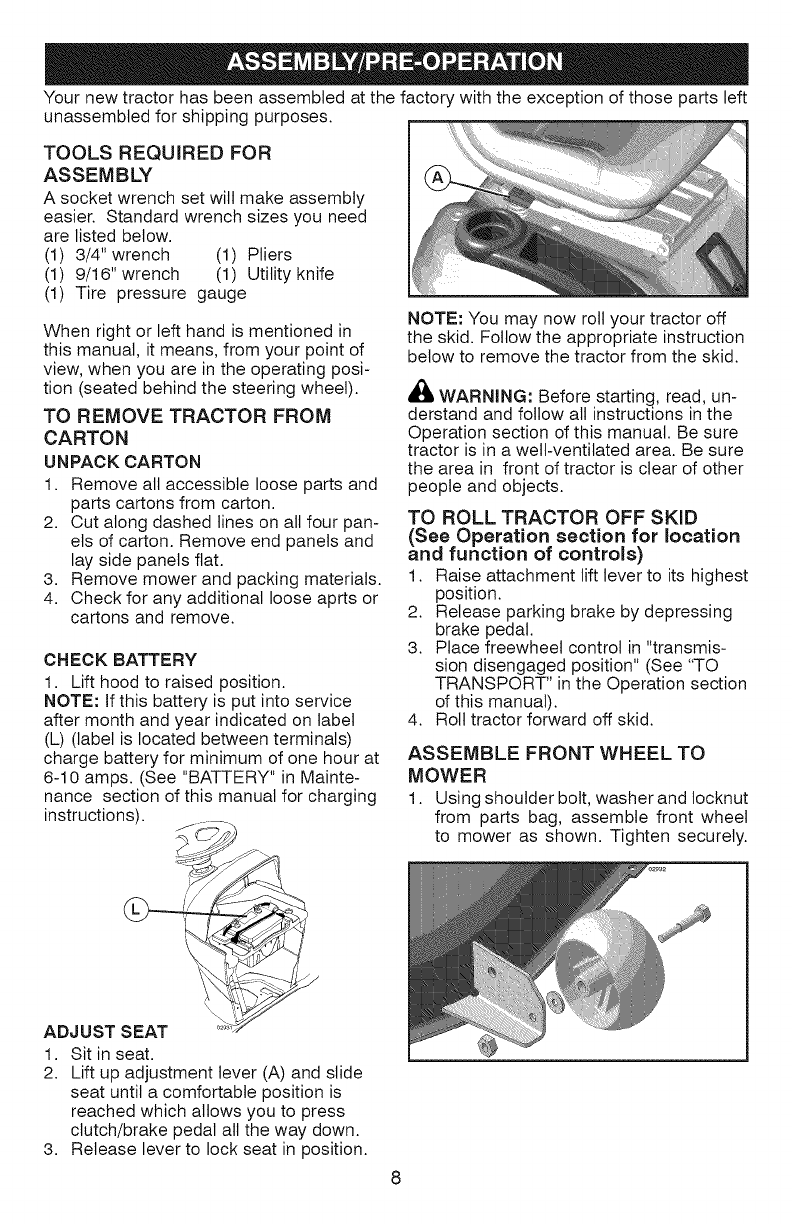
Your new tractor has been assembled at the factory with the exception of those parts left
unassembted for shipping purposes.
TOOLS REQUIRED FOR
ASSEMBLY
A socket wrench set will make assembly
easier. Standard wrench sizes you need
are listed below.
(1) 3/4" wrench (1) Pliers
(1) 9/16" wrench (1) Utility knife
(1) Tire pressure gauge
When right or left hand is mentioned in
this manual, it means, from your point of
view, when you are in the operating posi-
tion (seated behind the steering wheel).
TO REMOVE TRACTOR FROM
CARTON
UNPACK CARTON
1. Remove all accessible loose parts and
parts cartons from carton.
2. Cut along dashed lines on all four pan-
els of carton. Remove end panels and
lay side panels flat.
3. Remove mower and packing materials.
4. Check for any additional loose aprts or
cartons and remove.
CHECK BATTERY
1. Lift hood to raised position.
NOTE: If this battery is put into service
after month and year indicated on label
(L) (label is located between terminals)
charge battery for minimum of one hour at
6-10 amps. (See "BATTERY" in Mainte-
nance section of this manual for charging
instructions).
NOTE: You may now roll your tractor off
the skid. Follow the appropriate instruction
below to remove the tractor from the skid.
z_ WARNING: Before starting, read, un-
derstand and follow all instructions in the
Operation section of this manual. Be sure
tractor is in a welt-ventilated area. Be sure
the area in front of tractor is clear of other
people and objects.
TO ROLL TRACTOR OFF SKID
(See Operation section for location
and function of controls)
1. Raise attachment lift lever to its highest
position.
2. Release parking brake by depressing
brake pedal.
3. Place freewheel control in "transmis-
sion disengaged position" (See "TO
TRANSPORT" in the Operation section
of this manual).
4. Roll tractor forward off skid.
ASSEMBLE FRONT WHEEL TO
MOWER
1. Using shoulder bolt, washer and tocknut
from parts bag, assemble front wheel
to mower as shown. Tighten securely.
ADJUST SEAT
1. Sit in seat.
2. Lift up adjustment lever (A) and slide
seat until a comfortable position is
reached which allows you to press
clutch/brake pedal all the way down.
3. Release lever to lock seat in position.
8
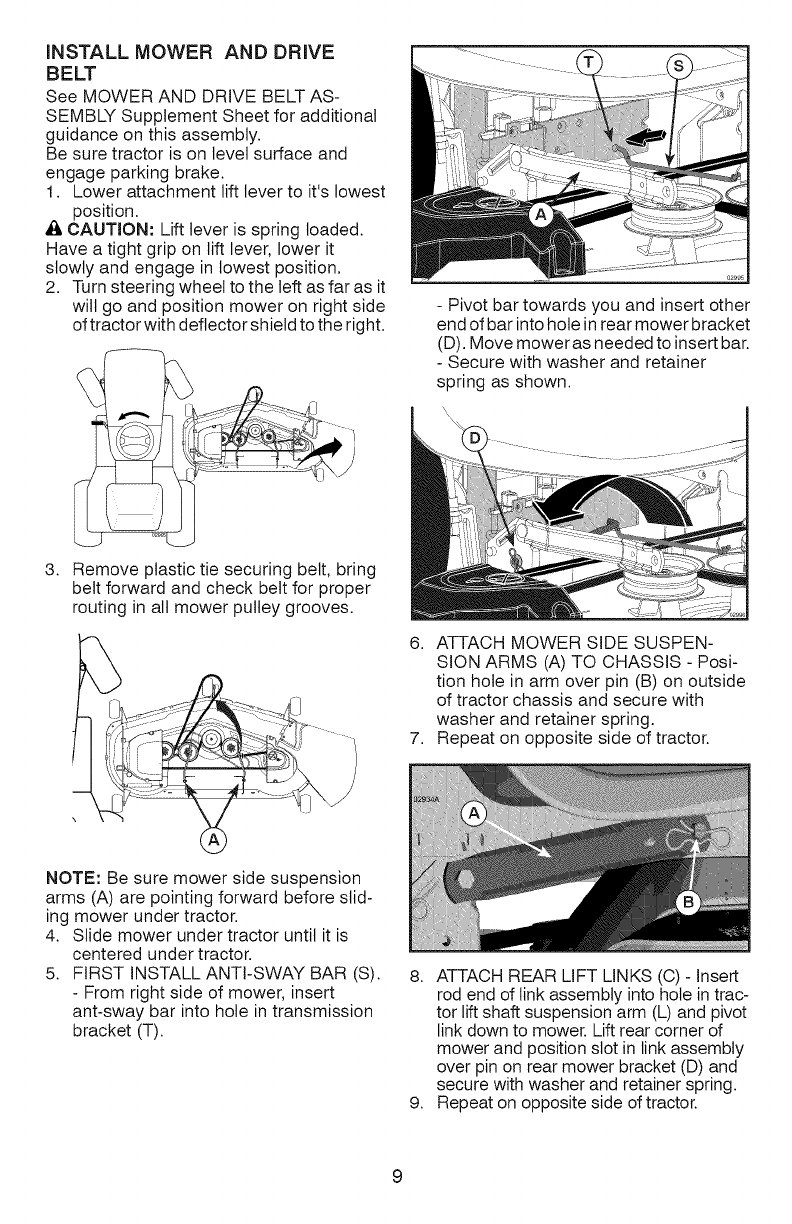
iNSTALL MOWER AND DRIVE
BELT
See MOWER AND DRIVE BELT AS-
SEMBLY Supplement Sheet for additional
guidance on this assembly.
Be sure tractor is on level surface and
engage parking brake.
1. Lower attachment lift lever to it's lowest
position.
_, CAUTION: Lift lever is spring loaded.
Have a tight grip on lift lever, lower it
slowly and engage in lowest position.
2. Turn steering wheel to the left as far as it
will go and position mower on right side
of tractor with deflector shield to the right.
3. Remove plastic tie securing belt, bring
belt forward and check belt for proper
routing in all mower pulley grooves.
- Pivot bar towards you and insert other
end of bar into hole in rear mower bracket
(D). Move mower as needed to insert bar.
- Secure with washer and retainer
spring as shown.
6. ATTACH MOWER SIDE SUSPEN-
SION ARMS (A) TO CHASSIS - Posi-
tion hole in arm over pin (B) on outside
of tractor chassis and secure with
washer and retainer spring.
7. Repeat on opposite side of tractor.
NOTE: Be sure mower side suspension
arms (A) are pointing forward before slid-
ing mower under tractor.
4. Slide mower under tractor until it is
centered under tractor.
5. FIRST INSTALL ANTI-SWAY BAR (S).
-From right side of mower, insert
ant-sway bar into hole in transmission
bracket (T).
8. ATTACH REAR LIFT LINKS (C) - Insert
rod end of link assembly into hole in trac-
tor lift shaft suspension arm (L) and pivot
link down to mower. Lift rear corner of
mower and position slot in link assembly
over pin on rear mower bracket (D) and
secure with washer and retainer spring.
9. Repeat on opposite side of tractor.
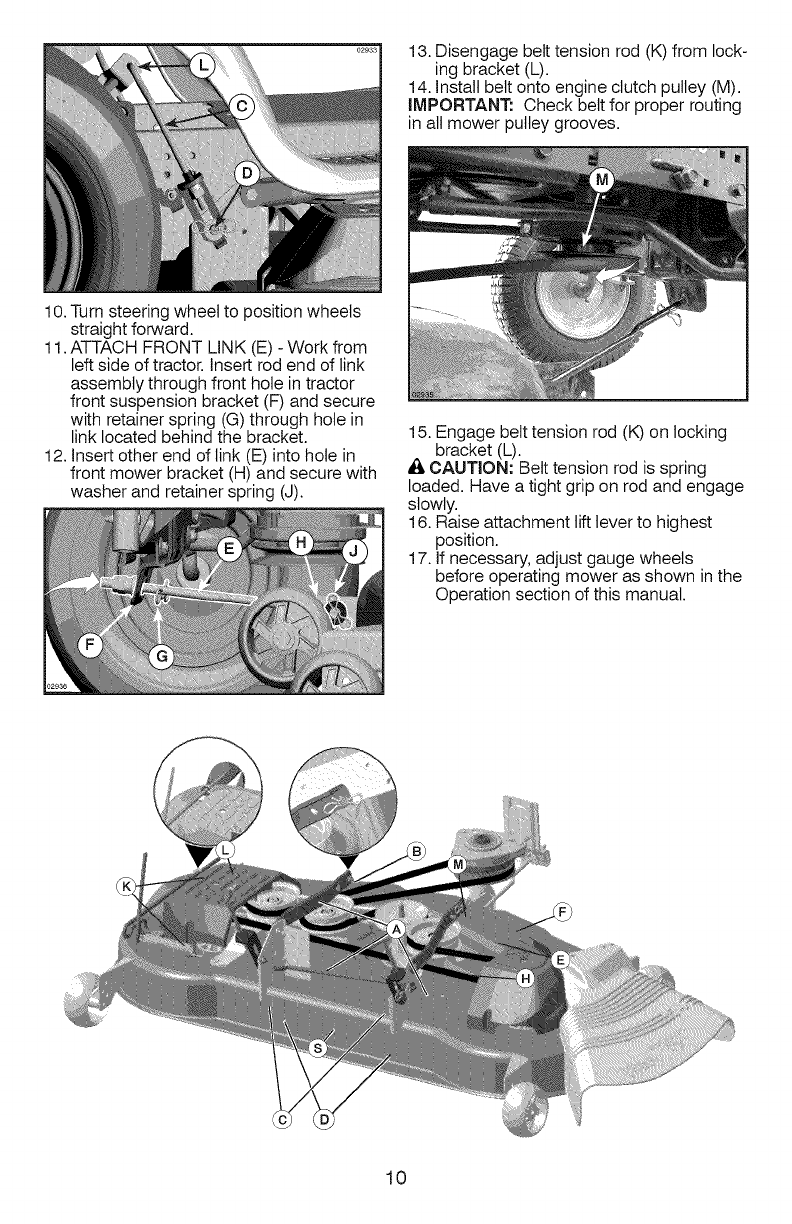
13.Disengagebelttensionrod(K)fromlock-
ingbracket(L).
14.Installbeltontoengineclutchpulley(M).
IMPORTANT:Checkbeltforproperrouting
inallmowerpulleygrooves.
10.Turnsteeringwheeltopositionwheels
straightforward.
11.ATTACHFRONTLINK(E)-Workfrom
leftsideoftractor.Insertrodendoflink
assemblythroughfrontholeintractor
frontsuspensionbracket(F)andsecure
withretainerspring(G)throughholein
linklocatedbehindthebracket.
12.Insertotherendoflink(E)intoholein
frontmowerbracket(H)andsecurewith
washerandretainerspring(J).
15.Engagebelttensionrod(K)onlocking
_ bracket(L).
CAUTION:Belttensionrodisspring
loaded.Haveatightgriponrodandengage
slowly.
16.Raiseattachmentliftlevertohighest
position.
17.Ifnecessary,adjustgaugewheels
beforeoperatingmowerasshowninthe
Operationsectionofthismanual.
10
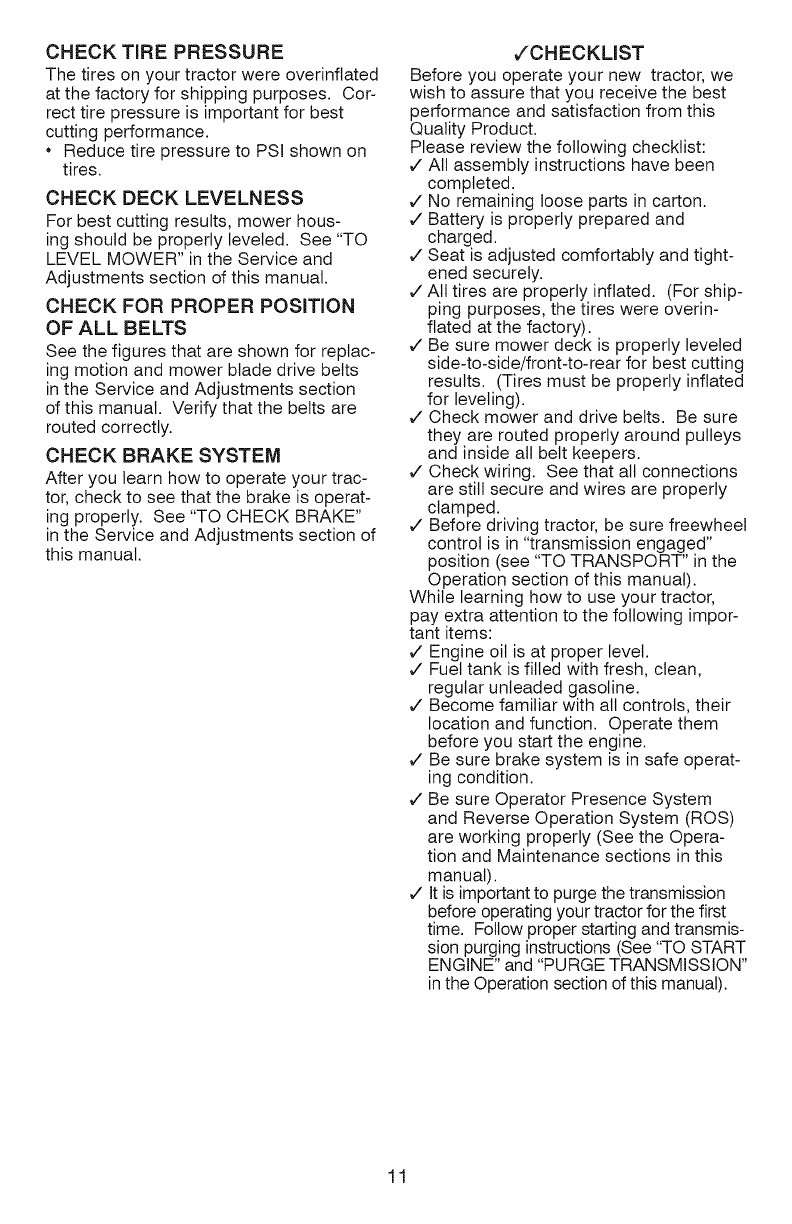
CHECK TIRE PRESSURE
The tires on your tractor were ovednflated
at the factory for shipping purposes. Cor-
rect tire pressure is important for best
cutting performance.
* Reduce tire pressure to PSI shown on
tires.
CHECK DECK LEVELNESS
For best cutting results, mower hous-
ing should be properly leveled. See "TO
LEVEL MOWER" in the Service and
Adjustments section of this manual.
CHECK FOR PROPER POSITION
OF ALL BELTS
See the figures that are shown for replac-
ing motion and mower blade drive belts
in the Service and Adjustments section
of this manual. Verify that the belts are
routed correctly.
CHECK BRAKE SYSTEM
After you learn how to operate your trac-
tor, check to see that the brake is operat-
ing properly. See "TO CHECK BRAKE"
in the Service and Adjustments section of
this manual.
,/'CHECKLIST
Before you operate your new tractor, we
wish to assure that you receive the best
performance and satisfaction from this
Quality Product.
Please review the following checklist:
J" All assembly instructions have been
completed.
J" No remaining loose parts in carton.
J" Battery is properly prepared and
charged.
J" Seat is adjusted comfortably and tight-
ened securely.
J" All tires are properly inflated. (For ship-
ping purposes, the tires were ovefin-
ftated at the factory).
J" Be sure mower deck is properly leveled
side-to-side/front-to-rear for best cutting
results. (Tires must be properly inflated
for leveling).
v" Check mower and drive belts. Be sure
they are routed properly around pulleys
and inside all belt keepers.
v" Check wiring. See that all connections
are still secure and wires are properly
clamped.
v" Before driving tractor, be sure freewheel
control is in "transmission engaged"
position (see "TO TRANSPORT" in the
Operation section of this manual).
While learning how to use your tractor,
pay extra attention to the following impor-
tant items:
v" Engine oil is at proper level.
v" Fuel tank is filled with fresh, clean,
regular unleaded gasoline.
v" Become familiar with all controls, their
location and function. Operate them
before you start the engine.
v" Be sure brake system is in safe operat-
ing condition.
v" Be sure Operator Presence System
and Reverse Operation System (ROS)
are working properly (See the Opera-
tion and Maintenance sections in this
manual).
v" It is important to purge the transmission
before operating your tractor for the first
time. Follow proper starting and transmis-
sion purging instructions (See "TO START
ENGINE" and "PURGE TRANSMISSION"
in the Operation section of this manual).
11
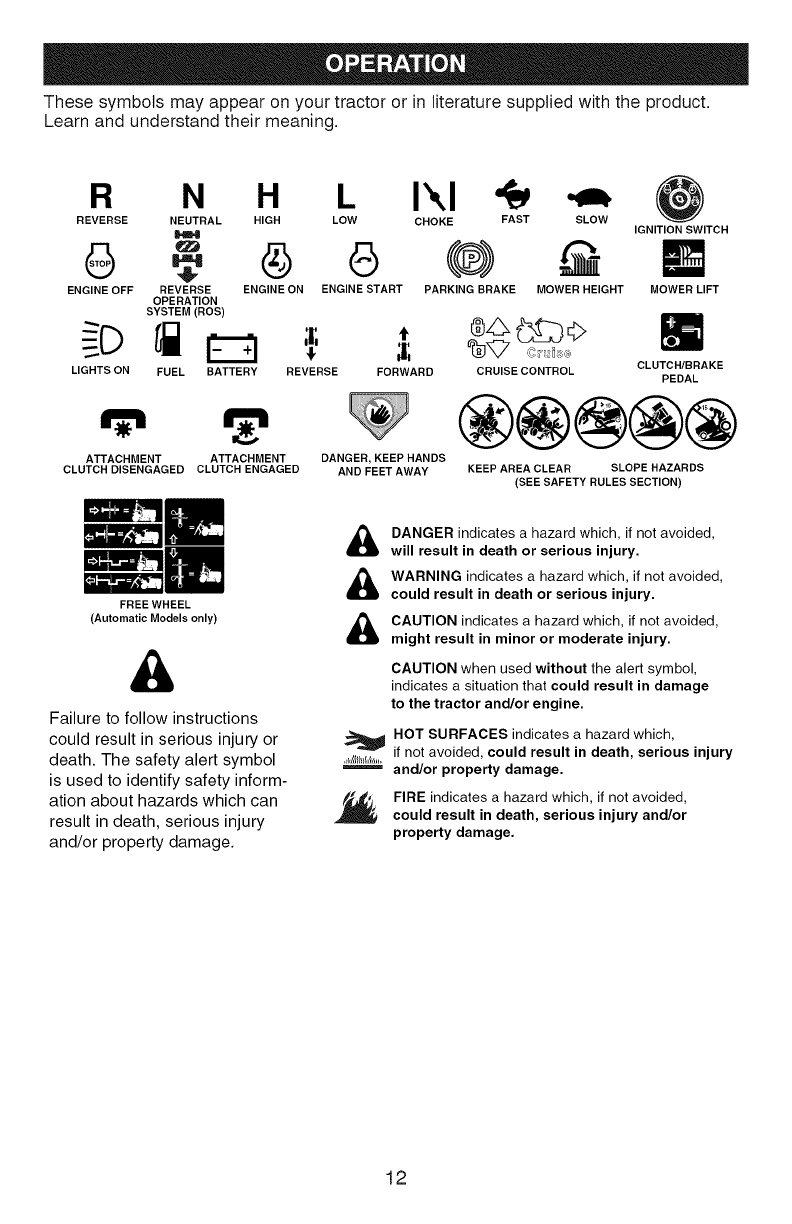
These symbols may appear on your tractor or in literature supplied with the product.
Learn and understand their meaning.
R N H I\1
REVERSE NEUTRAL HIGH LOW CHOKE FAST SLOW
ENGINE OFF REVERSE ENGINE ON ENGINE START PARKING BRAKE MOWER HEIGHT
OPERATION
SYSTEM(ROS) ,
CRUISECONTROL
IGNITION SWITCH
MOWER LIFT
CLUTCH/BRAKE
LIGHTS ON FUEL BATTERY REVERSE FORWARD PEDAL
ATTACHMENT ATTACHMENT
CLUTCH DISENGAGED CLUTCH ENGAGED
FREE WHEEL
(Automatic Models only)
DANGER, KEEP HANDS
AND FEET AWAY
@@@@@
KEEP AREA CLEAR SLOPE HAZARDS
(SEE SAFETY RULES SECTION)
Failure to follow instructions
could result in serious injury or
death. The safety alert symbol
is used to identify safety inform-
ation about hazards which can
result in death, serious injury
and/or property damage.
DANGER indicates a hazard which, if not avoided,
will result in death or serious injury.
WARNING indicates a hazard which, if not avoided,
could result in death or serious injury.
CAUTION indicates a hazard which, if not avoided,
might result in minor or moderate injury.
CAUTION when used without the alert symbol,
indicates a situation that could result in damage
to the tractor and/or engine.
HOT SURFACES indicates a hazard which,
if not avoided, could result in death, serious injury
and/or property damage.
FIRE indicates a hazard which, if not avoided,
could result in death, serious injury and/or
property damage.
12
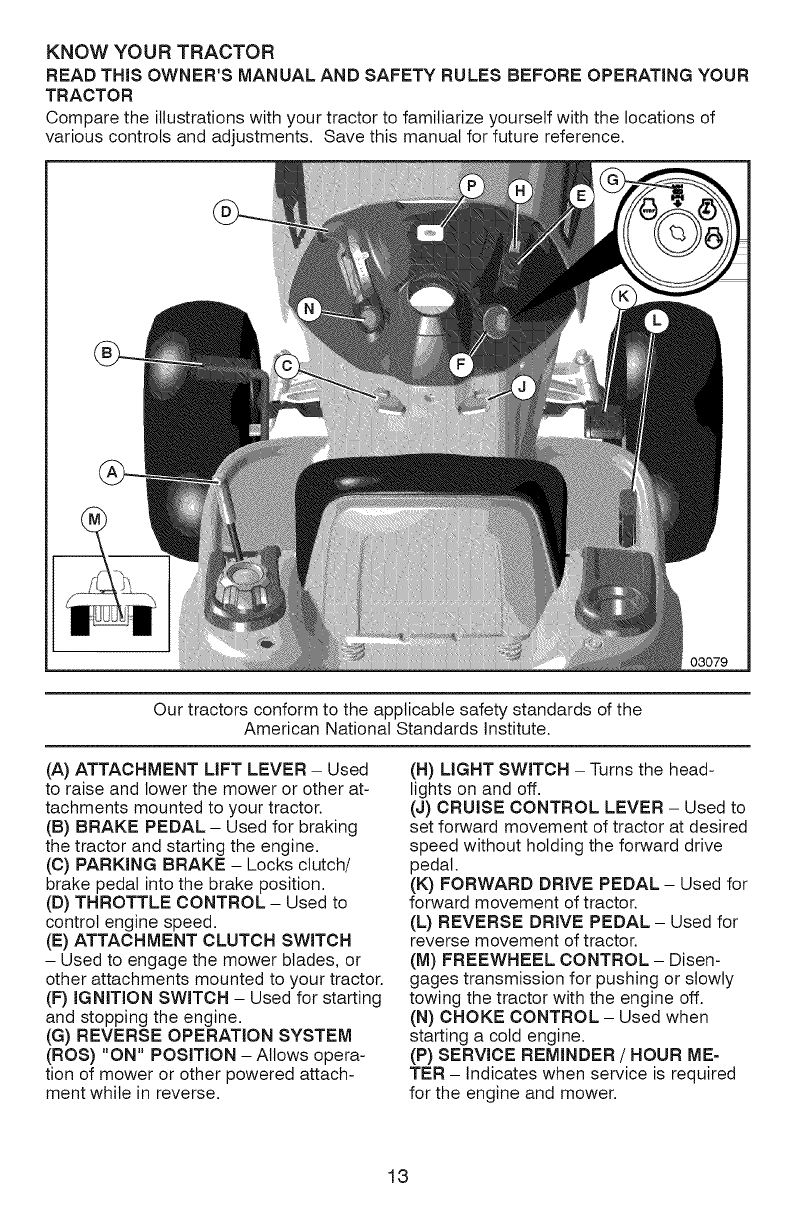
KNOW YOUR TRACTOR
READ THiS OWNER'S MANUAL AND SAFETY RULES BEFORE OPERATING YOUR
TRACTOR
Compare the illustrations with your tractor to familiarize yourself with the locations of
various controls and adjustments. Save this manual for future reference.
Our tractors conform to the applicable safety standards of the
American National Standards Institute.
(A) ATTACHMENT LIFT LEVER - Used
to raise and lower the mower or other at-
tachments mounted to your tractor.
(B) BRAKE PEDAL- Used for braking
the tractor and starting the engine.
(C) PARKING BRAKE - Locks clutch/
brake pedal into the brake position.
(D) THROTTLE CONTROL- Used to
control engine speed.
(E) ATTACHMENT CLUTCH SWITCH
- Used to engage the mower blades, or
other attachments mounted to your tractor.
(F) iGNITiON SWITCH - Used for starting
and stopping the engine.
(G) REVERSE OPERATION SYSTEM
(ROS) "ON" POSiTiON - Allows opera-
tion of mower or other powered attach-
ment while in reverse.
(H) LIGHT SWITCH - Turns the head-
lights on and off.
(J) CRUISE CONTROL LEVER - Used to
set forward movement of tractor at desired
speed without holding the forward drive
pedal.
(K) FORWARD DRIVE PEDAL- Used for
forward movement of tractor.
(L) REVERSE DRIVE PEDAL- Used for
reverse movement of tractor.
(M) FREEWHEEL CONTROL - Disen-
gages transmission for pushing or slowly
towing the tractor with the engine off.
(N) CHOKE CONTROL- Used when
starting a cold engine.
(P) SERVICE REMINDER /HOUR ME=
TER - Indicates when service is required
for the engine and mower.
13
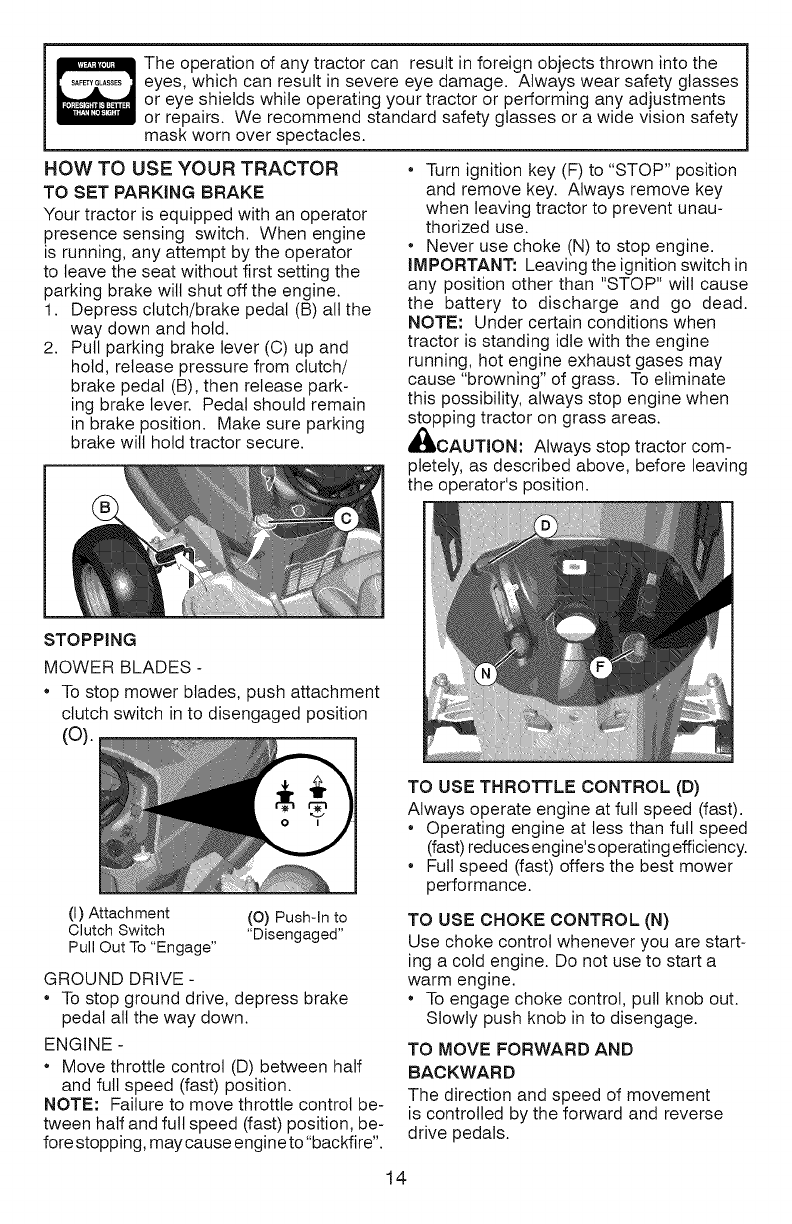
The operation of any tractor can result in foreign objects thrown into the
eyes, which can result in severe eye damage. Always wear safety glasses
or eye shields while operating your tractor or performing any adjustments
or repairs. We recommend standard safety glasses or a wide vision safety
mask worn over spectacles.
HOW TO USE YOUR TRACTOR
TO SET PARKING BRAKE
Your tractor is equipped with an operator
presence sensing switch. When engine
_srunning, any attempt by the operator
to leave the seat without first setting the
parking brake will shut off the engine.
1. Depress clutch/brake pedal (B) all the
way down and hold.
2. Pull parking brake lever (C) up and
hold, release pressure from clutch/
brake pedal (B), then release park-
ing brake lever. Pedal should remain
in brake position. Make sure parking
brake will hold tractor secure.
Turn ignition key (F) to "STOP" position
and remove key. Always remove key
when leaving tractor to prevent unau-
thorized use.
Never use choke (N) to stop engine.
IMPORTANT: Leaving the ignition switch in
any position other than "STOP" will cause
the battery to discharge and go dead.
NOTE: Under certain conditions when
tractor is standing idle with the engine
running, hot engine exhaust gases may
cause "browning" of grass. To eliminate
this possibility, always stop engine when
stopping tractor on grass areas.
_CAUTION: Always stop tractor com-
pletely, as described above, before leaving
the operator's position.
STOPPING
MOWER BLADES -
To stop mower blades, push attachment
clutch switch in to disengaged position
(o).
(I) Attachment (O) Push-In to
Clutch Switch "Disengaged"
Pull Out To "Engage"
GROUND DRIVE -
•To stop ground drive, depress brake
pedal all the way down.
ENGINE -
•Move throttle control (D) between half
and full speed (fast) position.
NOTE: Failure to move throttle control be-
tween half and full speed (fast) position, be-
fore stopping, may cause engine to "backfire".
TO USE THROTTLE CONTROL (D)
Always operate engine at full speed (fast).
•Operating engine at tess than full speed
(fast) reduces engine's operating efficiency.
•Full speed (fast) offers the best mower
performance.
TO USE CHOKE CONTROL (N)
Use choke control whenever you are start-
ing a cold engine. Do not use to start a
warm engine.
•To engage choke control, pull knob out.
Slowly push knob in to disengage.
TO MOVE FORWARD AND
BACKWARD
The direction and speed of movement
is controlled by the forward and reverse
drive pedals.
14
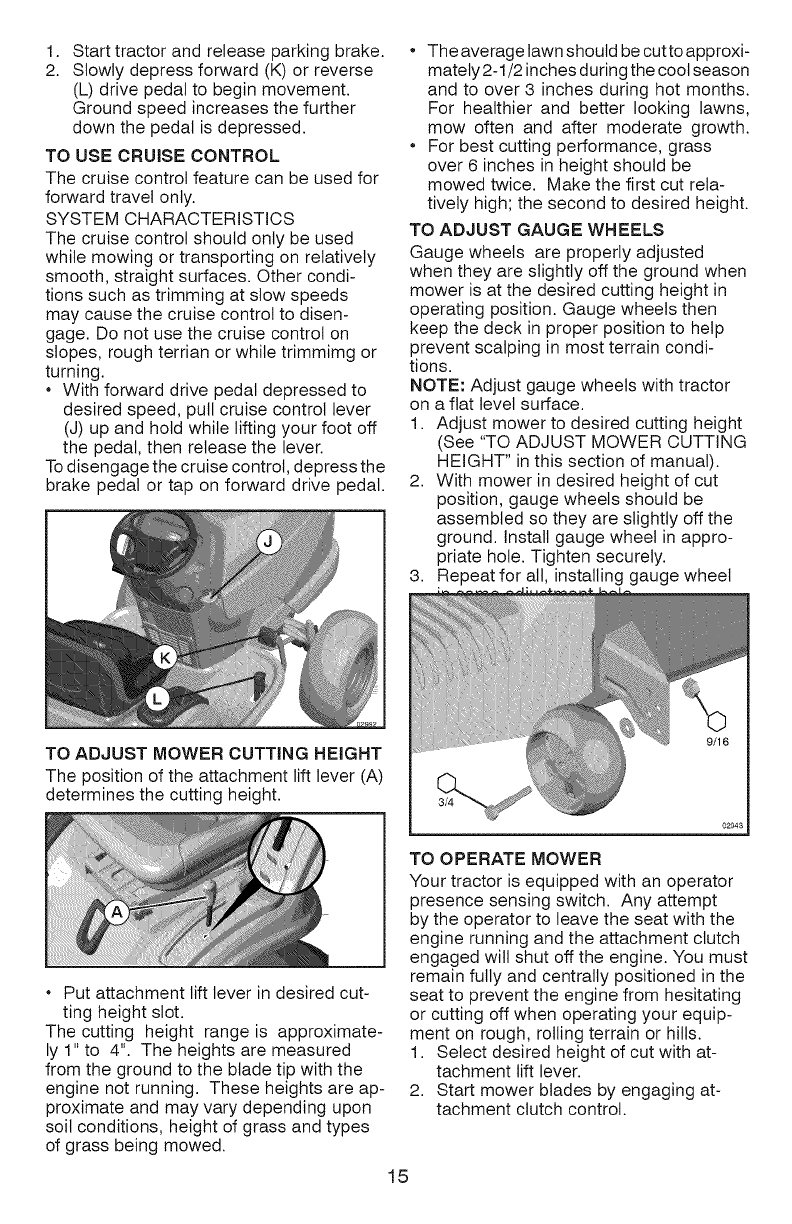
1.
2. Start tractor and release parking brake.
Slowly depress forward (K) or reverse
(L) drive pedal to begin movement.
Ground speed increases the further
down the pedal is depressed.
TO USE CRUISE CONTROL
The cruise control feature can be used for
forward travel only.
SYSTEM CHARACTERISTICS
The cruise control should only be used
while mowing or transporting on relatively
smooth, straight surfaces. Other condi-
tions such as trimming at slow speeds
may cause the cruise control to disen-
gage. Do not use the cruise control on
slopes, rough terrian or while trimmimg or
turning.
With forward drive pedal depressed to
desired speed, pull cruise control lever
(J) up and hold while lifting your foot off
the pedal, then release the lever.
To disengage the cruise control, depress the
brake pedal or tap on forward drive pedal.
The average lawn should be cutto approxi-
mately 2-1/2 inches during the cool season
and to over 3 inches during hot months.
For healthier and better looking lawns,
mow often and after moderate growth.
For best cutting performance, grass
over 6 inches in height should be
mowed twice. Make the first cut rela-
tively high; the second to desired height.
TO ADJUST GAUGE WHEELS
Gauge wheels are properly adjusted
when they are slightly off the ground when
mower is at the desired cutting height in
operating position. Gauge wheels then
keep the deck in proper position to help
prevent scalping in most terrain condi-
tions.
NOTE: Adjust gauge wheels with tractor
on a flat level surface.
1. Adjust mower to desired cutting height
(See "TO ADJUST MOWER CUTTING
HEIGHT" in this section of manual).
2. With mower in desired height of cut
position, gauge wheels should be
assembled so they are slightly off the
ground. Install gauge wheel in appro-
priate hole. Tighten securely.
3. Repeat for all, installing gauge wheel
TO ADJUST MOWER CUTTING HEIGHT
The position of the attachment lift lever (A)
determines the cutting height.
Put attachment lift lever in desired cut-
ting height slot.
The cutting height range is approximate-
ly 1" to 4". The heights are measured
from the ground to the blade tip with the
engine not running. These heights are ap-
proximate and may vary depending upon
soil conditions, height of grass and types
of grass being mowed.
TO OPERATE MOWER
Your tractor is equipped with an operator
presence sensing switch. Any attempt
by the operator to leave the seat with the
engine running and the attachment clutch
engaged will shut off the engine. You must
remain fully and centrally positioned in the
seat to prevent the engine from hesitating
or cutting off when operating your equip-
ment on rough, rolling terrain or hills.
1. Select desired height of cut with at-
tachment lift lever.
2. Start mower blades by engaging at-
tachment clutch control.
15
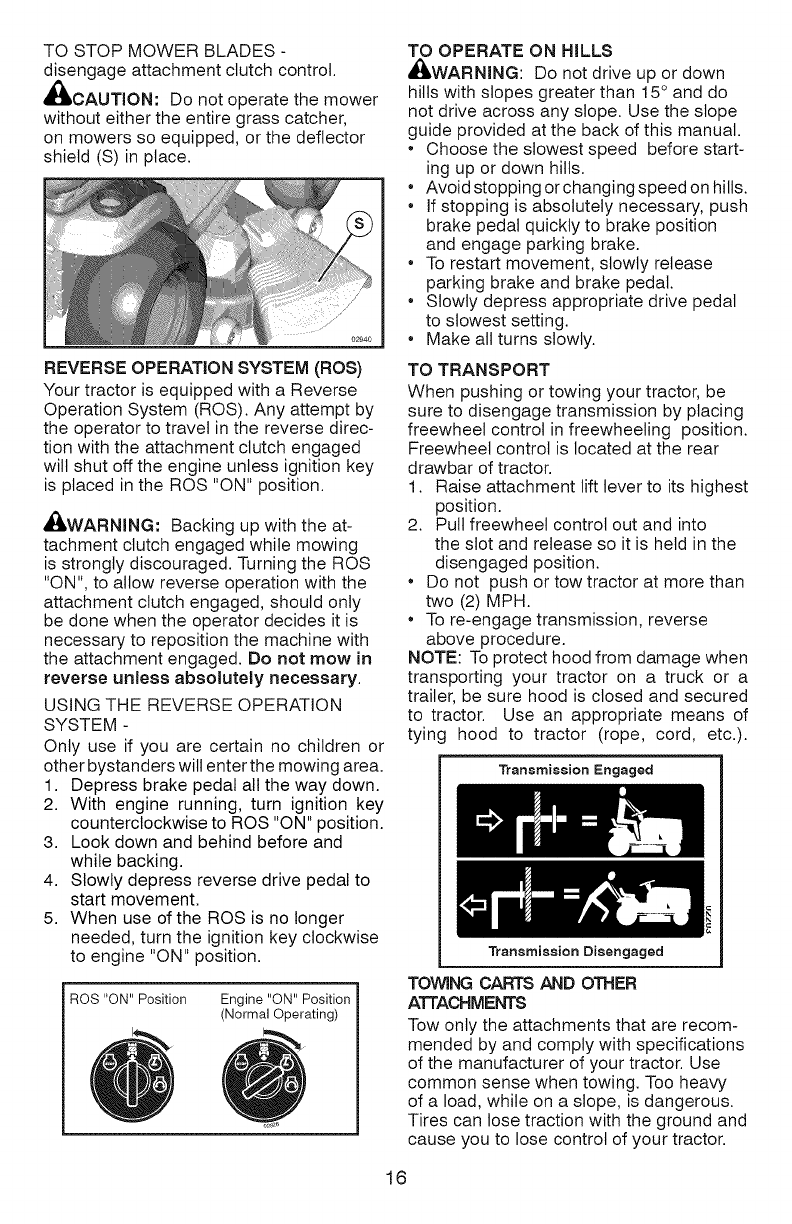
TOSTOPMOWERBLADES-
disengageattachmentclutchcontrol.
CAUTION:Donotoperatethemower
withouteithertheentiregrasscatcher,
onmowerssoequipped,orthedeflector
shield(S)inplace.
REVERSEOPERATIONSYSTEM(ROS)
YourtractorisequippedwithaReverse
OperationSystem(ROS).Anyattemptby
theoperatortotravelinthereversedirec-
tionwiththeattachmentclutchengaged
wiltshutofftheengineunlessignitionkey
isplacedintheROS"ON"position.
_I_,WARNING: Backing up with the at-
tachment clutch engaged while mowing
is strongly discouraged. Turning the ROS
"ON", to allow reverse operation with the
attachment clutch engaged, should onty
be done when the operator decides it is
necessary to reposition the machine with
the attachment engaged. Do not mow in
reverse unless absolutely necessary.
USING THE REVERSE OPERATION
SYSTEM -
Only use if you are certain no children or
other bystanders will enter the mowing area.
1. Depress brake pedal all the way down.
2. With engine running, turn ignition key
counterclockwise to ROS "ON" position.
3. Look down and behind before and
while backing.
4. Slowly depress reverse drive pedal to
start movement.
5. When use of the ROS is no longer
needed, turn the ignition key clockwise
to engine "ON" position.
ROS "ON" Position Engine "ON" Position
(Normal Operating)
TO OPERATE ON HILLS
_WARNING: Do not drive up or down
hills with slopes greater than 15° and do
not drive across any slope. Use the slope
guide provided at the back of this manual.
* Choose the slowest speed before start-
ing up or down hills.
Avoid stopping or changing speed on hills.
If stopping is absolutely necessary, push
brake pedal quickly to brake position
and engage parking brake.
To restart movement, slowly release
parking brake and brake pedal.
Slowly depress appropriate drive pedal
to slowest setting.
Make all turns slowly.
TO TRANSPORT
When pushing or towing your tractor, be
sure to disengage transmission by placing
freewheel control in freewheeling position.
Freewheel control is located at the rear
drawbar of tractor.
1. Raise attachment lift lever to its highest
position.
2. Pull freewheel control out and into
the slot and release so it is held in the
disengaged position.
* Do not push or tow tractor at more than
two (2) MPH.
* To re-engage transmission, reverse
above procedure.
NOTE: To protect hood from damage when
transporting your tractor on a truck or a
trailer, be sure hood is closed and secured
to tractor. Use an appropriate means of
tying hood to tractor (rope, cord, etc.).
Transmission Engaged
Transmission Disengaged
TOWING CARTS AND OTHER
ATTACHMENTS
Tow onty the attachments that are recom-
mended by and comply with specifications
of the manufacturer of your tractor. Use
common sense when towing. Too heavy
of a load, while on a slope, is dangerous.
Tires can lose traction with the ground and
cause you to lose control of your tractor.
16
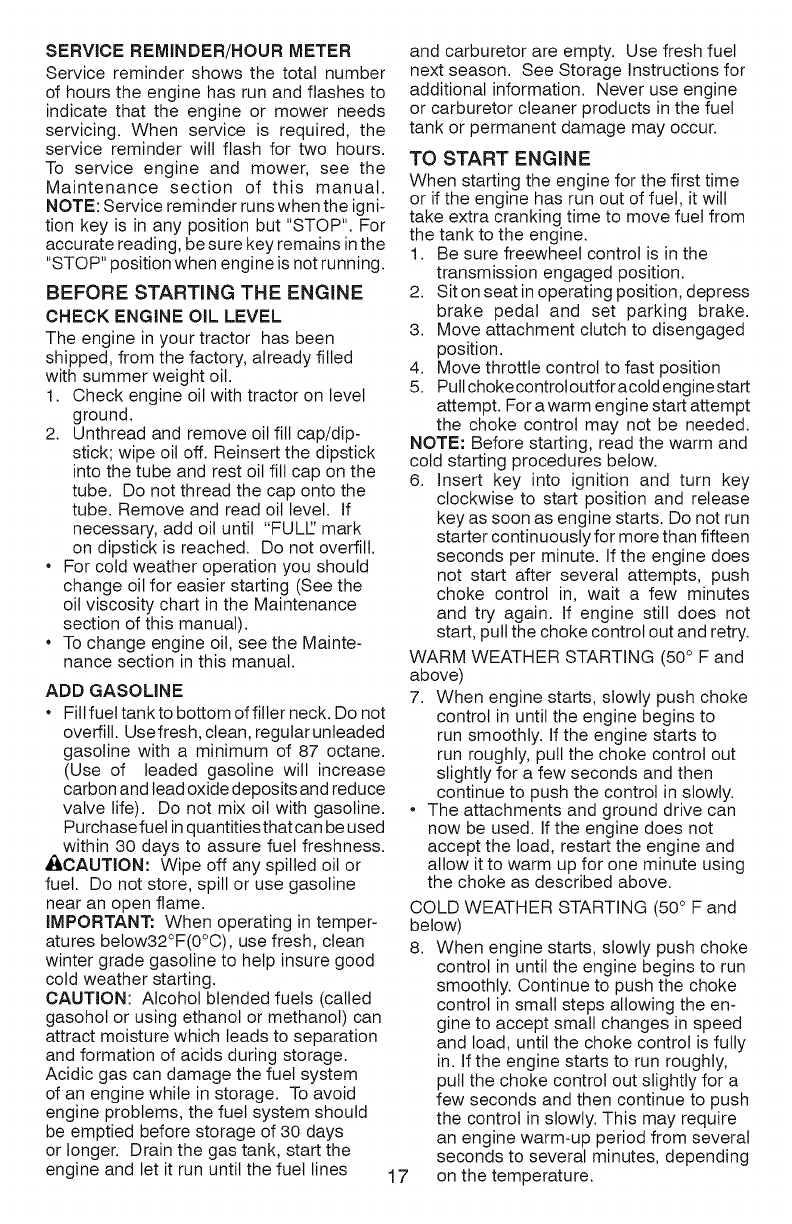
SERVICE REMINDER/HOUR METER
Service reminder shows the total number
of hours the engine has run and flashes to
indicate that the engine or mower needs
servicing. When service is required, the
service reminder wilt flash for two hours.
To service engine and mower, see the
Maintenance section of this manual.
NOTE: Service reminder runs when the igni-
tion key is in any position but "STOP". For
accurate reading, be sure key remains inthe
"STOP" position when engine is not running.
BEFORE STARTING THE ENGINE
CHECK ENGINE OiL LEVEL
The engine in your tractor has been
shipped, from the factory, already filled
with summer weight oil.
1. Check engine oil with tractor on level
ground.
2. Unthread and remove oil fill cap/dip-
stick; wipe oil off. Reinsert the dipstick
into the tube and rest oil fill cap on the
tube. Do not thread the cap onto the
tube. Remove and read oil level. If
necessary, add oil until "FULL' mark
on dipstick is reached. Do not overfill.
•For cold weather operation you should
change oil for easier starting (See the
oil viscosity chart in the Maintenance
section of this manual).
•To change engine oil, see the Mainte-
nance section in this manual.
ADD GASOLINE
•Fill fuel tank to bottom of filler neck. Do not
overfill. Usefresh, clean, regutarunleaded
gasoline with a minimum of 87 octane.
(Use of leaded gasoline will increase
carbon and lead oxide deposits and reduce
valve life). Do not mix oil with gasoline.
Purchase fuel inquantities that can be used
within 30 days to assure fuel freshness.
_,CAUTION: Wipe off any spilled oil or
fuel. Do not store, spill or use gasoline
near an open flame.
iMPORTANT: When operating in temper-
atures betow32°F(0°C), use fresh, clean
winter grade gasoline to help insure good
cold weather starting.
CAUTION: Alcohol blended fuels (called
gasohol or using ethanol or methanol) can
attract moisture which leads to separation
and formation of acids during storage.
Acidic gas can damage the fuel system
of an engine while in storage. To avoid
engine problems, the fuel system should
be emptied before storage of 30 days
or longer. Drain the gas tank, start the
engine and let it run until the fuel lines
and carburetor are empty. Use fresh fuel
next season. See Storage instructions for
additional information. Never use engine
or carburetor cleaner products inthe fuel
tank or permanent damage may occur.
TO START ENGINE
When starting the engine for the first time
or if the engine has run out of fuel, it will
take extra cranking time to move fuel from
the tank to the engine.
1. Be sure freewheel control is in the
transmission engaged position.
2. Sit on seat inoperating position, depress
brake pedal and set parking brake.
3. Move attachment clutch to disengaged
position.
4. Move throttle control to fast position
5. Pullchokecontrotoutforacotd enginestart
attempt. For a warm engine start attempt
the choke control may not be needed.
NOTE: Before starting, read the warm and
cold starting procedures below.
6. insert key into ignition and turn key
clockwise to start position and release
key as soon as engine starts. Do not run
starter continuously for more than fifteen
seconds per minute. If the engine does
not start after several attempts, push
choke control in, wait a few minutes
and try again. If engine still does not
start, putt the choke control out and retry.
WARM WEATHER STARTING (50° F and
above)
7. When engine starts, slowly push choke
control in until the engine begins to
run smoothly, if the engine starts to
run roughly, pull the choke control out
slightly for a few seconds and then
continue to push the control in slowly.
•The attachments and ground drive can
now be used. if the engine does not
accept the load, restart the engine and
allow itto warm up for one minute using
the choke as described above.
COLD WEATHER STARTING (50 ° F and
below)
8. When engine starts, slowly push choke
control in until the engine begins to run
smoothly. Continue to push the choke
control in small steps allowing the en-
gine to accept small changes in speed
and load, until the choke control is fully
in. If the engine starts to run roughly,
pull the choke control out slightly for a
few seconds and then continue to push
the control in slowly. This may require
an engine warm-up period from several
seconds to several minutes, depending
17 on the temperature.
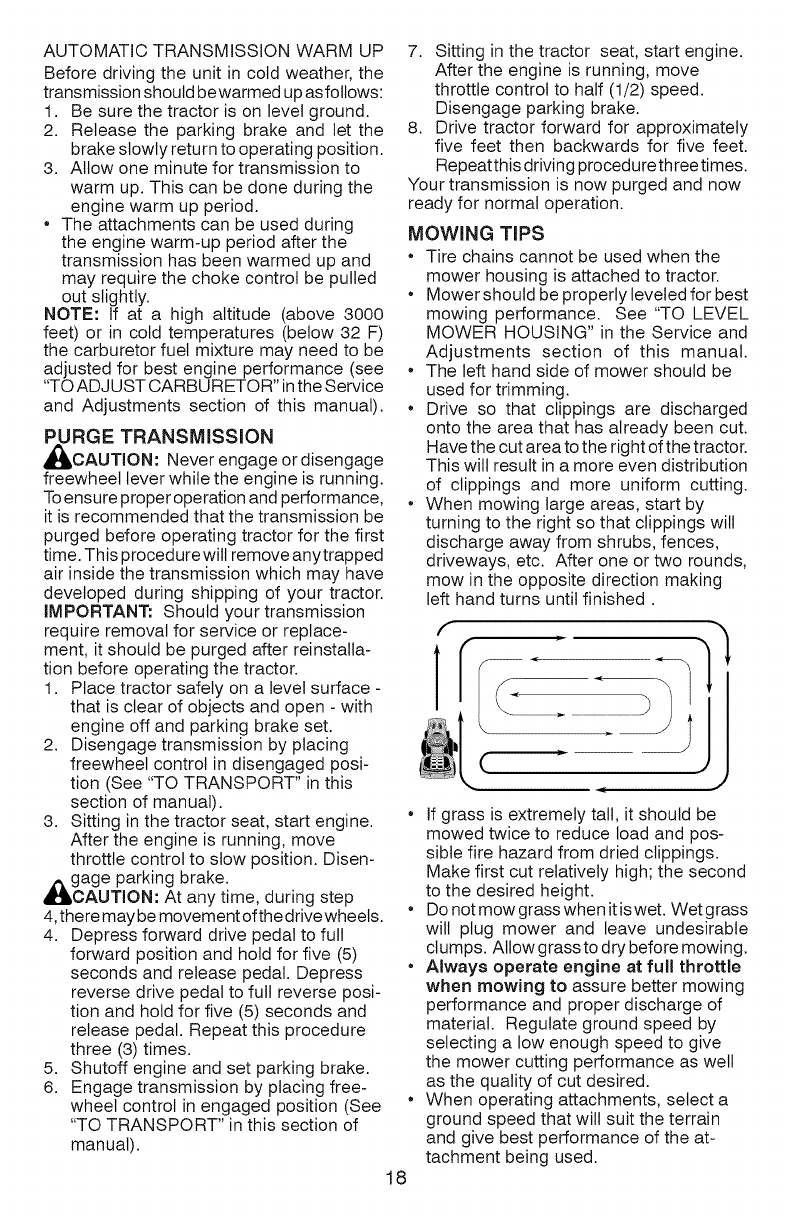
AUTOMATICTRANSMISSIONWARMUP
Beforedrivingtheunitincoldweather,the
transmissionshouldbewarmedupasfollows:
1. Besurethetractorisonlevelground.
2. Releasetheparkingbrakeandtetthe
brakeslowlyreturntooperatingposition.
3. Allowoneminutefortransmissionto
warmup.Thiscanbedoneduringthe
enginewarmupperiod.
Theattachmentscanbeusedduring
theenginewarm-upperiodafterthe
transmissionhasbeenwarmedupand
mayrequirethechokecontrolbepulled
outslightly.
NOTE:If at a highaltitude(above3000
feet)orincoldtemperatures(below32F)
thecarburetorfuelmixturemayneedtobe
adjustedforbestengineperformance(see
"TOADJUSTCARBURETOR"intheService
andAdjustmentssectionofthismanual).
PURGE TRANSMiSSiON
,_CAUTION: Never engage or disengage
freewheel lever while the engine is running.
To ensure proper operation and performance,
it is recommended that the transmission be
purged before operating tractor for the first
time. This procedure will remove anytrapped
air inside the transmission which may have
developed during shipping of your tractor.
IMPORTANT: Should your transmission
require removal for service or replace-
ment, it should be purged after reinstalla-
tion before operating the tractor.
1. Place tractor safely on a level surface -
that is clear of objects and open - with
engine off and parking brake set.
2. Disengage transmission by placing
freewheel control in disengaged posi-
tion (See "TO TRANSPORT" in this
section of manual).
3. Sitting in the tractor seat, start engine.
After the engine is running, move
throttle control to stow position. Disen-
_igcage parking brake.
AUTION: At any time, during step
4, there may be movement of the drive wheels.
4. Depress forward drive pedal to full
forward position and hold for five (5)
seconds and release pedal. Depress
reverse drive pedal to full reverse posi-
tion and hold for five (5) seconds and
release pedal. Repeat this procedure
three (3) times.
5. Shutoff engine and set parking brake.
6. Engage transmission by placing free-
wheel control in engaged position (See
"TO TRANSPORT" in this section of
manual).
18
7. Sitting in the tractor seat, start engine.
After the engine is running, move
throttle control to half (1/2) speed.
Disengage parking brake.
8. Drive tractor forward for approximately
five feet then backwards for five feet.
Repeatthis driving procedure three times.
Your transmission is now purged and now
ready for normal operation.
MOWING TiPS
•Tire chains cannot be used when the
mower housing is attached to tractor.
Mower should be properly leveled for best
mowing performance. See "TO LEVEL
MOWER HOUSING" in the Service and
Adjustments section of this manual.
The left hand side of mower should be
used for trimming.
Drive so that clippings are discharged
onto the area that has already been cut.
Have the cut area to the right of the tractor.
This will result in a more even distribution
of clippings and more uniform cutting.
When mowing large areas, start by
turning to the right so that clippings will
discharge away from shrubs, fences,
driveways, etc. After one or two rounds,
mow in the opposite direction making
left hand turns until finished.
If grass is extremely tall, it should be
mowed twice to reduce load and pos-
sible fire hazard from dried clippings.
Make first cut relatively high; the second
to the desired height.
Do not mow grass when itis wet. Wet grass
will plug mower and leave undesirable
clumps. Allow grass to dry before mowing.
Always operate engine at full throttle
when mowing to assure better mowing
performance and proper discharge of
material. Regulate ground speed by
selecting a low enough speed to give
the mower cutting performance as well
as the quality of cut desired.
* When operating attachments, select a
ground speed that will suit the terrain
and give best performance of the at-
tachment being used.
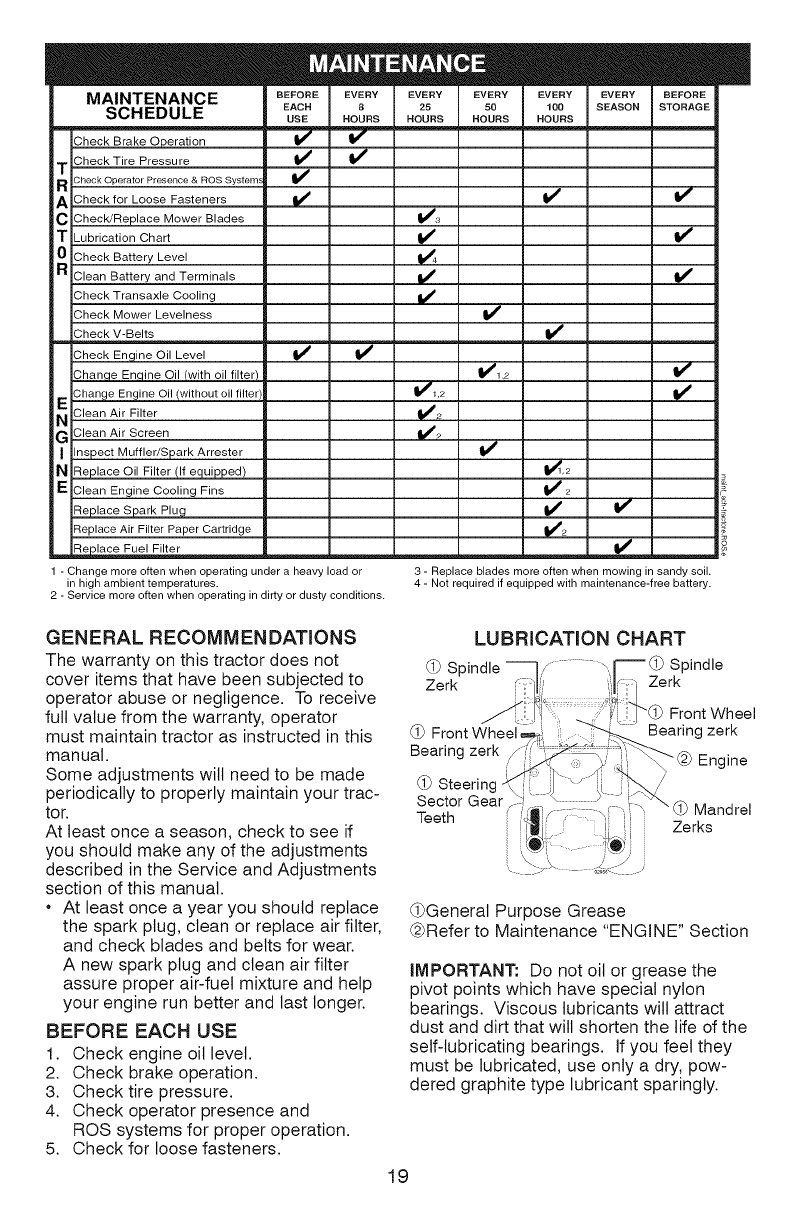
MAINTENANCE
SCHEDULE
Check Brake Operation If I_
TCheck Tire Pressure ..11_ I_
Check Operator Presence & ROS System_
RCheck for Loose Fasteners if
A
C ChecWReplace Mower Blades
TLubrication Chart
0 Check Battery Level
RClean Batte_ and Terminals
Check Transaxle Cooling
Check Mower Levelness
Check V-Belts
Check Engine Oil Level I1_ I_
Chanqe Enqine Oil (with oil filter)
Chan_e Engine Oil !without oil filter
[,_EClean Air Filter
GClean Air Screen
I Inspect Muffler/Spark Arrester
N Replace Oil Filter !If equipped)
E Clean Engine Cooling Fins
Replace Spark Plug
Replace Air Filter Paper Cartridge
__ R_olace Fuel Filter
1 - Change more often when operating under a heavy load or
in high ambient temperatures.
2 - Service more often when operating in dirty or dusty conditions.
v'
i,,'4
VVV
_#'1.2
V,
v"
v'
v'
_1.2
v'
1_1,2
v'2
_2
3 - Replace blades more often when mowing in sandy soil.
4 - Not required if equipped with maintenance-free battery.
GENERAL RECOMMENDATIONS
The warranty on this tractor does not
cover items that have been subjected to
operator abuse or negligence. To receive
full value from the warranty, operator
must maintain tractor as instructed in this
manual.
Some adjustments will need to be made
periodically to properly maintain your trac-
tor.
At least once a season, check to see if
you should make any of the adjustments
described in the Service and Adjustments
section of this manual.
At least once a year you should replace
the spark plug, clean or replace air filter,
and check blades and belts for wear.
A new spark plug and clean air filter
assure proper air-fuel mixture and help
your engine run better and last longer.
BEFORE EACH USE
1. Check engine oil level.
2. Check brake operation.
3. Check tire pressure.
4. Check operator presence and
ROS systems for proper operation.
5. Check for loose fasteners.
LUBRICATION CHART
(_ Spindle ]y ......... \.r---_(_ Spindle
Zerk ':/;/ I!:' Zerk
_:: _l ....... 10"_¢ Front Wheel
@ Front Wheei_ I ::' _Bearing zerk
Bearing zerk /'_r'4 /_" _\ t_''_ _ .
,:_ b" _LZJLnglne
@Steering-P_'rl _--_ j %'-...//
Sector Gear _-- ' _ .........................)" _ !__.W_ _ Mandrel
! ; _ l /......... \ " _, \w
Teeth _i,, _ i __
i _ LerKs
_General Purpose Grease
@Refer to Maintenance "ENGINE" Section
iMPORTANT: Do not oil or grease the
pivot points which have special nylon
bearings. Viscous lubricants will attract
dust and dirt that will shorten the life of the
self-lubricating bearings. If you feet they
must be lubricated, use only a dry, pow-
dered graphite type lubricant sparingly.
19
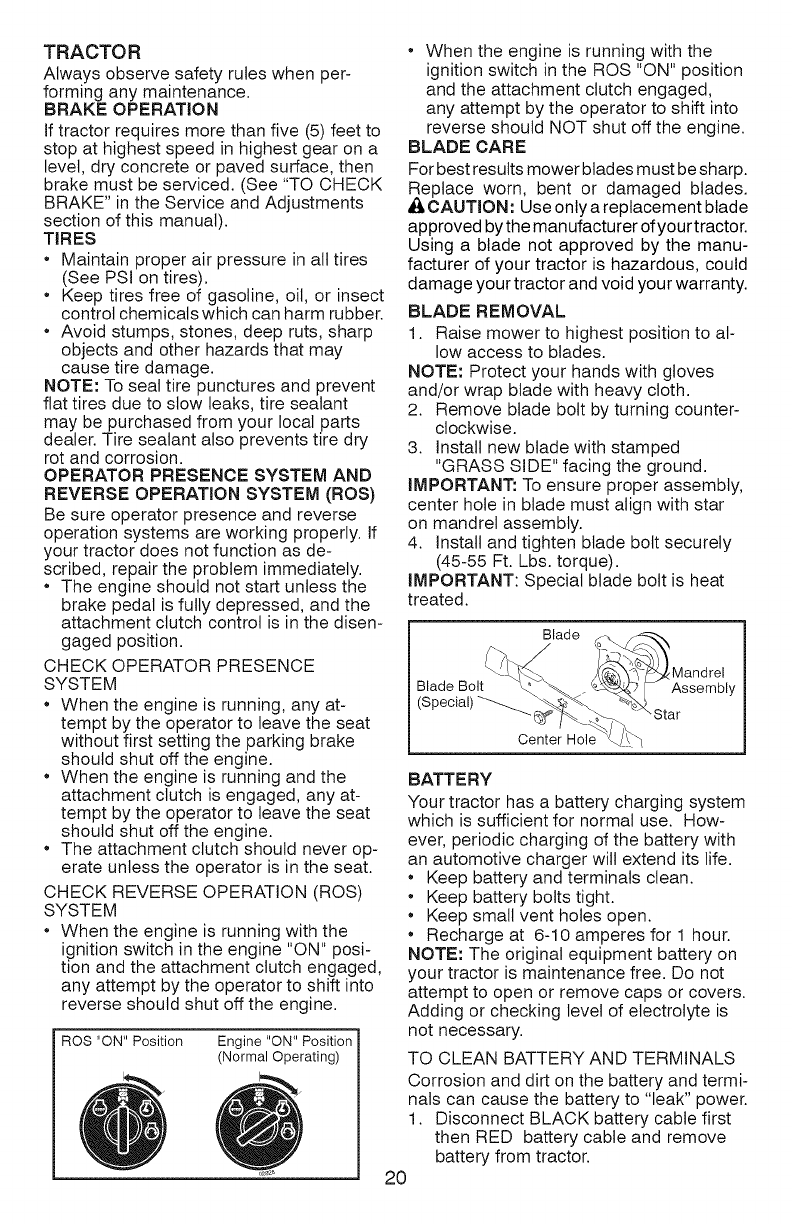
TRACTOR
Always observe safety rules when per-
forming any maintenance.
BRAKE OPERATION
If tractor requires more than five (5) feet to
stop at highest speed in highest gear on a
level, dry concrete or paved surface, then
brake must be serviced. (See "TO CHECK
BRAKE" in the Service and Adjustments
section of this manual).
TIRES
• Maintain proper air pressure in all tires
(See PSI on tires).
• Keep tires free of gasoline, oil, or insect
control chemicals which can harm rubber.
• Avoid stumps, stones, deep ruts, sharp
objects and other hazards that may
cause tire damage.
NOTE: To seal tire punctures and prevent
flat tires due to slow leaks, tire sealant
may be purchased from your local parts
dealer. Tire sealant also prevents tire dry
rot and corrosion.
OPERATOR PRESENCE SYSTEM AND
REVERSE OPERATION SYSTEM (ROS)
Be sure operator presence and reverse
operation systems are working properly. If
your tractor does not function as de-
scribed, repair the problem immediately.
• The engine should not start unless the
brake pedal is fully depressed, and the
attachment clutch control is in the disen-
gaged position.
CHECK OPERATOR PRESENCE
SYSTEM
• When the engine is running, any at-
tempt by the operator to leave the seat
without first setting the parking brake
should shut off the engine.
• When the engine is running and the
attachment clutch is engaged, any at-
tempt by the operator to leave the seat
should shut off the engine.
• The attachment clutch should never op-
erate unless the operator is in the seat.
CHECK REVERSE OPERATION (ROS)
SYSTEM
• When the engine is running with the
ignitionswitch in the engine "ON" posi-
tion and the attachment clutch engaged,
any attempt by the operator to shift into
reverse should shut off the engine.
ROS "ON" Position Engine "ON" Position
(Normal Operating)
• When the engine is running with the
ignition switch in the ROS "ON" position
and the attachment clutch engaged,
any attempt by the operator to shift into
reverse should NOT shut off the engine.
BLADE CARE
For best results mower blades must be sharp.
Replace worn, bent or damaged blades.
CAUTION: Use only a replacement blade
approved by the manufacturer of your tractor.
Using a blade not approved by the manu-
facturer of your tractor is hazardous, could
damage your tractor and void your warranty.
BLADE REMOVAL
1. Raise mower to highest position to al-
low access to blades.
NOTE: Protect your hands with gloves
and/or wrap blade with heavy cloth.
2. Remove blade bolt by turning counter-
clockwise.
3. Install new blade with stamped
"GRASS SIDE" facing the ground.
IMPORTANT: To ensure proper assembly,
center hole in blade must align with star
on mandrel assembly.
4. Install and tighten blade bolt securely
(45-55 Ft. Lbs. torque).
IMPORTANT: Special blade bolt is heat
treated.
Blade
Blade Bolt Assembly
(Special)
Center Hole
BATTERY
Your tractor has a battery charging system
which is sufficient for normal use. How-
ever, periodic charging of the battery with
an automotive charger will extend its life.
• Keep battery and terminals ciean.
• Keep battery bolts tight.
• Keep small vent holes open.
• Recharge at 6-10 amperes for 1 hour.
NOTE: The original equipment battery on
your tractor is maintenance free. Do not
attempt to open or remove caps or covers.
Adding or checking level of electrolyte is
not necessary.
TO CLEAN BATTERY AND TERMINALS
Corrosion and dirt on the battery and termi-
nals can cause the battery to "leak" power.
1. Disconnect BLACK battery cable first
then RED battery cable and remove
battery from tractor.
20
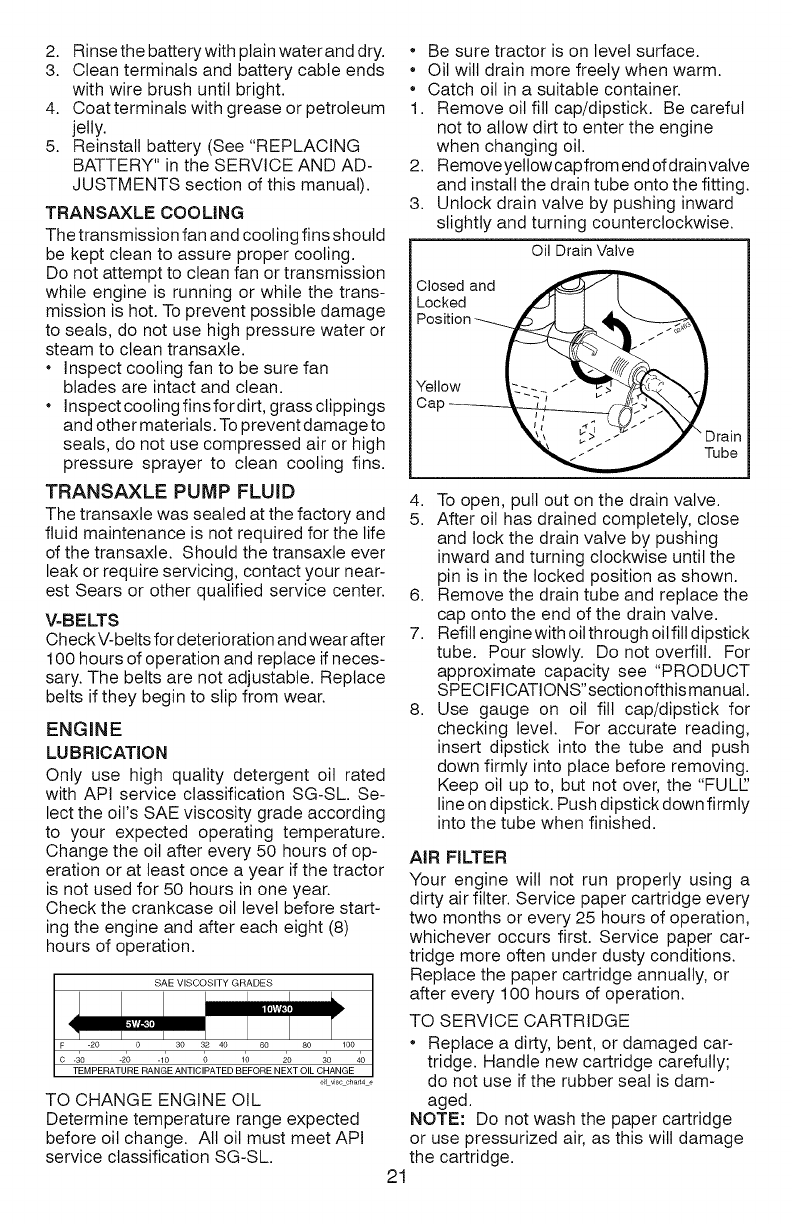
2. Rinsethebatterywithplainwateranddry.
3. Cleanterminalsandbatterycableends
withwirebrushuntilbright.
4. Coatterminalswithgreaseorpetroleum
jelly.
5. Reinstallbattery(See"REPLACING
BATTERY"intheSERVICEANDAD-
JUSTMENTSsectionofthismanual).
TRANSAXLECOOLING
Thetransmissionfanandcoolingfinsshould
bekeptcleantoassurepropercooling.
Donotattempttocleanfanortransmission
whileengineisrunningorwhilethetrans-
missionishot.Topreventpossibledamage
toseals,donotusehighpressurewateror
steamtocleantransaxle.
• Inspectcoolingfantobesurefan
bladesareintactandclean.
• Inspectcootingfinsfordirt,grassctippings
andothermaterials.Topreventdamageto
seals,donotusecompressedairorhigh
pressuresprayerto cleancoolingfins.
TRANSAXLE PUMP FLUID
The transaxte was sealed at the factory and
fluid maintenance is not required for the life
of the transaxte. Should the transaxle ever
leak or require servicing, contact your near-
est Sears or other qualified service center.
V-BELTS
CheckV-betts for deterioration and wear after
100 hours of operation and replace if neces-
sary. The belts are not adjustable. Replace
belts if they begin to slip from wear.
ENGINE
LUBRICATION
Only use high quality detergent oil rated
with API service classification SG-SL Se-
lect the oil's SAE viscosity grade according
to your expected operating temperature.
Change the oil after every 50 hours of op-
eration or at least once a year if the tractor
is not used for 50 hours in one year.
Check the crankcase oil level before start-
ingthe engine and after each eight (8)
hours of operation.
F -20 0 30 32 40 60 80 100
C -30 -20 -10 0 1'0 20 30 40
TEMPERATURE RANGE ANTICIPATED BEFORE NEXT OIL CHANGE
oi_vis¢ ehart4e
TO CHANGE ENGINE OIL
Determine temperature range expected
before oil change. All oil must meet API
service classification SG-SL.
• Be sure tractor is on level surface.
• Oil will drain more freely when warm.
• Catch oil in a suitable container.
1. Remove oil fill cap/dipstick. Be careful
not to allow dirt to enter the engine
when changing oil.
2. Remove yellow cap from end of drainvatve
and install the drain tube onto the fitting.
3. Unlock drain valve by pushing inward
slightly and turning counterclockwise.
Oil Drain Valve
Closed and
Yellow I_"--_--._'" _ W_-4' "N-I
Cap -----__/¢ ."_W
_LL _: z J'Drain
_ Tube
4. To open, pull out on the drain valve.
5. After oil has drained completely, close
and lock the drain valve by pushing
inward and turning clockwise until the
pin is in the locked position as shown.
6. Remove the drain tube and replace the
cap onto the end of the drain valve.
7. Refill engine with oil through oil fill dipstick
tube. Pour slowly. Do not overfill. For
approximate capacity see "PRODUCT
SPECIFICATIONS"section ofthis manual.
8. Use gauge on oil fill cap/dipstick for
checking level. For accurate reading,
insert dipstick into the tube and push
down firmly into place before removing.
Keep oil up to, but not over, the "FULL'
line on dipstick. Push dipstick down firmly
into the tube when finished.
AIR FILTER
Your engine will not run properly using a
dirty air filter. Service paper cartridge every
two months or every 25 hours of operation,
whichever occurs first. Service paper car-
tridge more often under dusty conditions.
Replace the paper cartridge annually, or
after every 100 hours of operation.
TO SERVICE CARTRIDGE
• Replace a dirty, bent, or damaged car-
tridge. Handle new cartridge carefully;
do not use if the rubber seal is dam-
aged.
NOTE: Do not wash the paper cartridge
or use pressurized air, as this will damage
the cartridge.
21
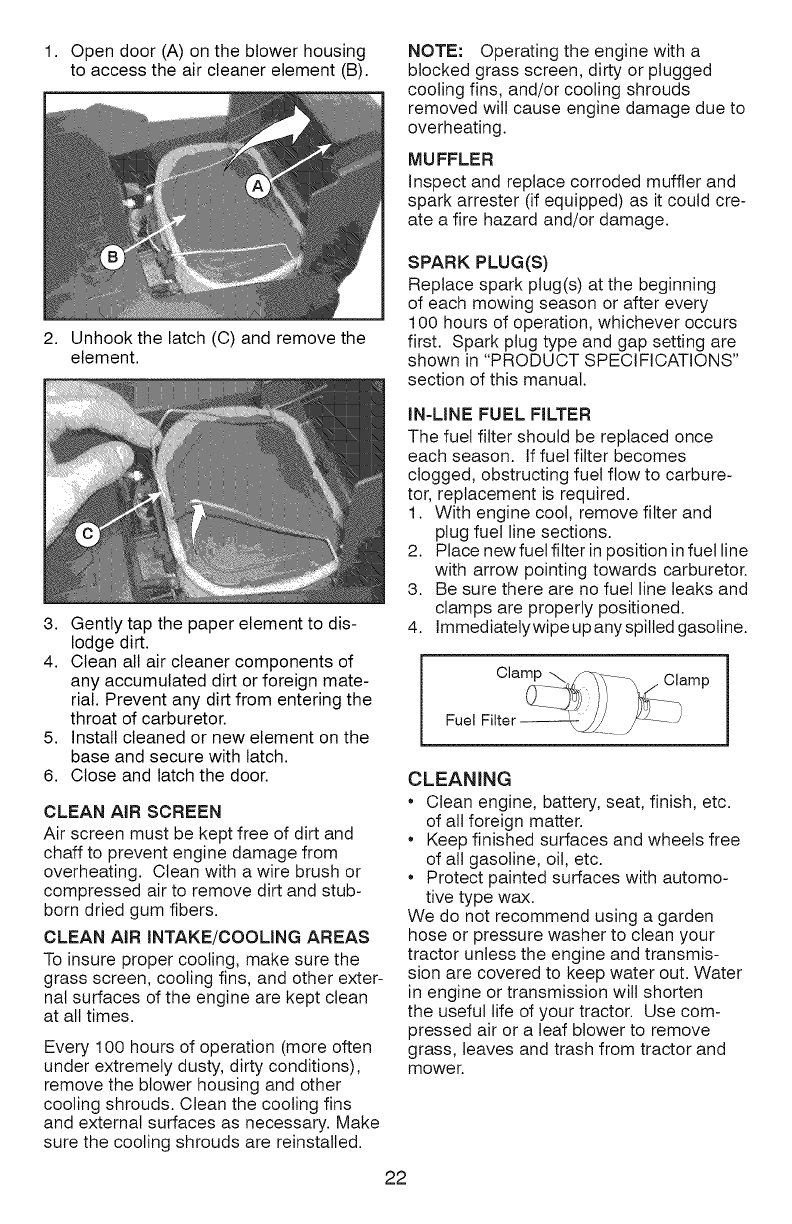
1. Open door (A) on the blower housing
to access the air cleaner element (B).
2. Unhook the latch (C) and remove the
element.
NOTE: Operating the engine with a
blocked grass screen, dirty or plugged
cooling fins, and/or cooling shrouds
removed will cause engine damage due to
overheating.
MUFFLER
inspect and replace corroded muffler and
spark arrester (if equipped) as it could cre-
ate a fire hazard and/or damage.
SPARK PLUG(S)
Replace spark plug(s) at the beginning
of each mowing season or after every
100 hours of operation, whichever occurs
first. Spark plug type and gap setting are
shown in "PRODUCT SPECIFICATIONS"
section of this manual.
3. Gently tap the paper element to dis-
lodge dirt.
4. Clean all air cleaner components of
any accumulated dirt or foreign mate-
rial. Prevent any dirt from entering the
throat of carburetor.
5. Install cleaned or new element on the
base and secure with latch.
6. Close and latch the door.
CLEAN AIR SCREEN
Air screen must be kept free of dirt and
chaff to prevent engine damage from
overheating. Clean with a wire brush or
compressed air to remove dirt and stub-
born dried gum fibers.
CLEAN AIR INTAKE/COOLING AREAS
To insure proper cooling, make sure the
grass screen, cooling fins, and other exter-
nal surfaces of the engine are kept clean
at all times.
Every 100 hours of operation (more often
under extremely dusty, dirty conditions),
remove the blower housing and other
cooling shrouds. Clean the cooling fins
and external surfaces as necessary. Make
sure the cooling shrouds are reinstalled.
IN=LINE FUEL FILTER
The fuel filter should be replaced once
each season. If fuel filter becomes
clogged, obstructing fuel flow to carbure-
tor, replacement is required.
1. With engine coot, remove filter and
plug fuel line sections.
2. Place new fuel filter in position in fuel line
with arrow pointing towards carburetor.
3. Be sure there are no fuel line leaks and
clamps are properly positioned.
4. Immediately wipe up any spilled gasoline.
Clamp _ --___ Clamp
Fuel Filter __ _ _)_- _!_
CLEANING
• Clean engine, battery, seat, finish, etc.
of all foreign matter.
• Keep finished surfaces and wheels free
of all gasoline, oil, etc.
• Protect painted surfaces with automo-
tive type wax.
We do not recommend using a garden
hose or pressure washer to clean your
tractor unless the engine and transmis-
sion are covered to keep water out. Water
in engine or transmission will shorten
the useful life of your tractor. Use com-
pressed air or a leaf blower to remove
grass, leaves and trash from tractor and
mower.
22
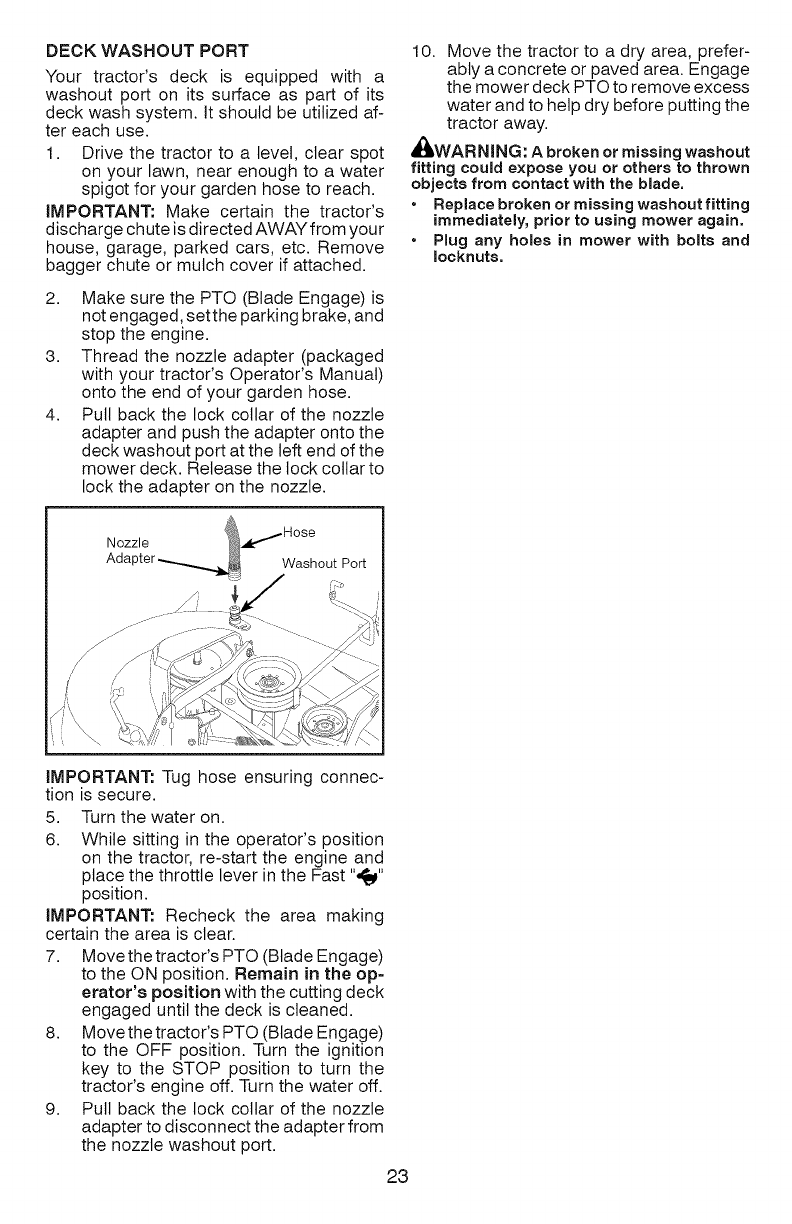
DECK WASHOUT PORT
Your tractor's deck is equipped with a
washout port on its surface as part of its
deck wash system. It should be utilized af-
ter each use.
1. Drive the tractor to a level, clear spot
on your lawn, near enough to a water
spigot for your garden hose to reach.
IMPORTANT: Make certain the tractor's
discharge chute is directed AWAY from your
house, garage, parked cars, etc. Remove
bagger chute or mulch cover if attached.
2. Make sure the PTO (Blade Engage) is
not engaged, setthe parking brake, and
stop the engine.
3. Thread the nozzle adapter (packaged
with your tractor's Operator's Manual)
onto the end of your garden hose.
4. Pull back the lock collar of the nozzle
adapter and push the adapter onto the
deck washout port at the left end of the
mower deck. Release the lock collar to
lock the adapter on the nozzle.
10. Move the tractor to a dry area, prefer-
ably a concrete or paved area. Engage
the mower deck PTO to remove excess
water and to help dry before putting the
tractor away.
_WARNING: A broken or missing washout
fitting could expose you or others to thrown
objects from contact with the blade.
Replace broken or missing washout fitting
immediately, prior to using mower again.
Plug any holes in mower with bolts and
Iocknuts.
Nozzle
Washout Port
IMPORTANT: Tug hose ensuring connec-
tion is secure.
5. Turn the water on.
6. While sitting in the operator's position
on the tractor, re-start the engine and
place the throttle lever in the Fast ",_"
position.
IMPORTANT: Recheck the area making
certain the area is clear.
7. Move thetractor'sPTO (BtadeEngage)
to the ON position. Remain in the op-
erator's position with the cutting deck
engaged until the deck is cleaned.
8. Move thetractor'sPTO(BtadeEngage)
to the OFF position. Turn the ignition
key to the STOP position to turn the
tractor's engine off. Turn the water off.
9. Pull back the lock collar of the nozzle
adapter to disconnect the adapter from
the nozzle washout port.
23
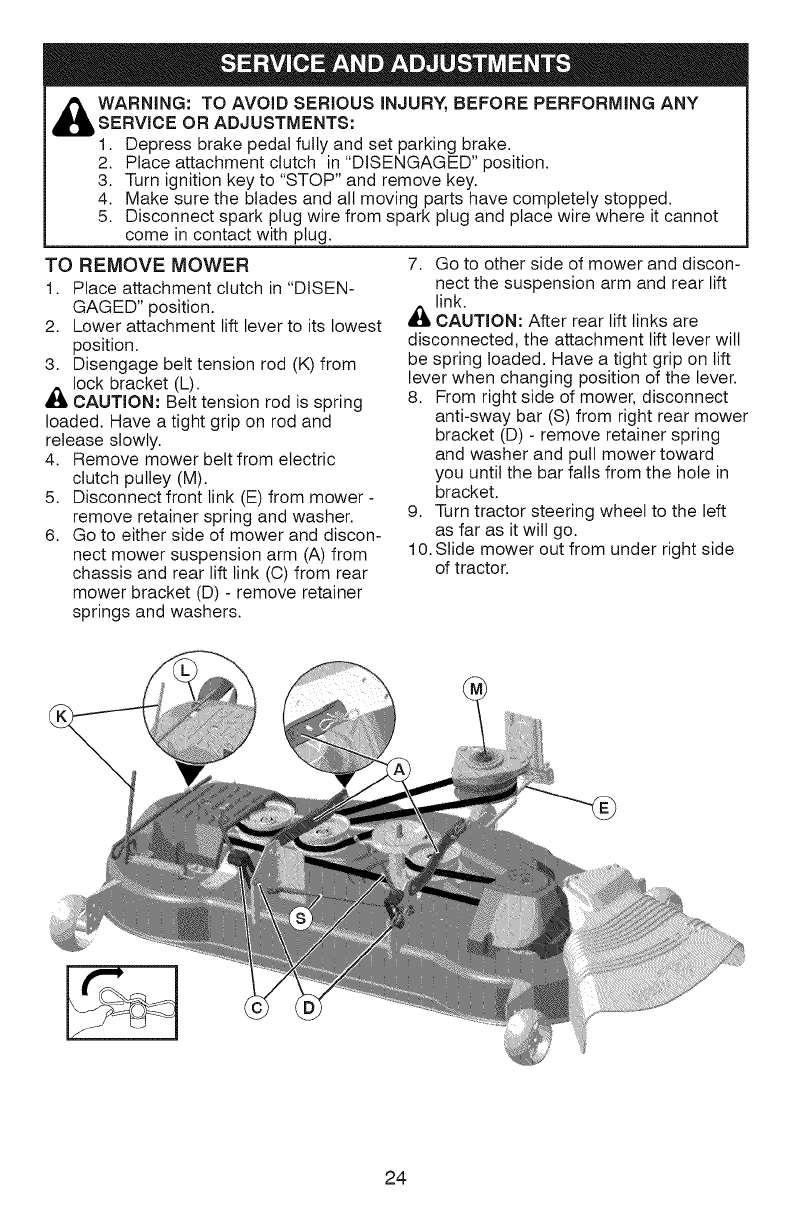
,_WARNING: TO AVOID SERIOUS iNJURY, BEFORE PERFORMING ANY
SERVICE OR ADJUSTMENTS:
1. Depress brake pedal fully and set parking brake.
2. Place attachment clutch in "DISENGAGED" position.
3. Turn ignition key to "STOP" and remove key.
4. Make sure the blades and all moving parts have completely stopped.
5. Disconnect spark plug wire from spark plug and place wire where it cannot
come in contact with plug.
TO REMOVE MOWER
1. Place attachment clutch in "DISEN-
GAGED" position.
2. Lower attachment lift lever to its lowest
position.
3. Disengage belt tension rod (K) from
lock bracket (L).
CAUTION: Belt tension rod is spring
loaded. Have a tight grip on rod and
release slowly.
4. Remove mower belt from electric
clutch pulley (M).
5. Disconnect front link (E) from mower -
remove retainer spring and washer.
6. Go to either side of mower and discon-
nect mower suspension arm (A) from
chassis and rear lift link (C) from rear
mower bracket (D) - remove retainer
springs and washers.
7. Go to other side of mower and discon-
nect the suspension arm and rear lift
link.
Al_ CAUTION: After rear lift links are
disconnected, the attachment lift lever will
be spring loaded. Have a tight grip on lift
lever when changing position of the lever.
8. From right side of mower, disconnect
anti-sway bar (S) from right rear mower
bracket (D) - remove retainer spring
and washer and pull mower toward
you until the bar falls from the hole in
bracket.
9. Turn tractor steering wheel to the left
as far as it will go.
10. Slide mower out from under right side
of tractor.
24
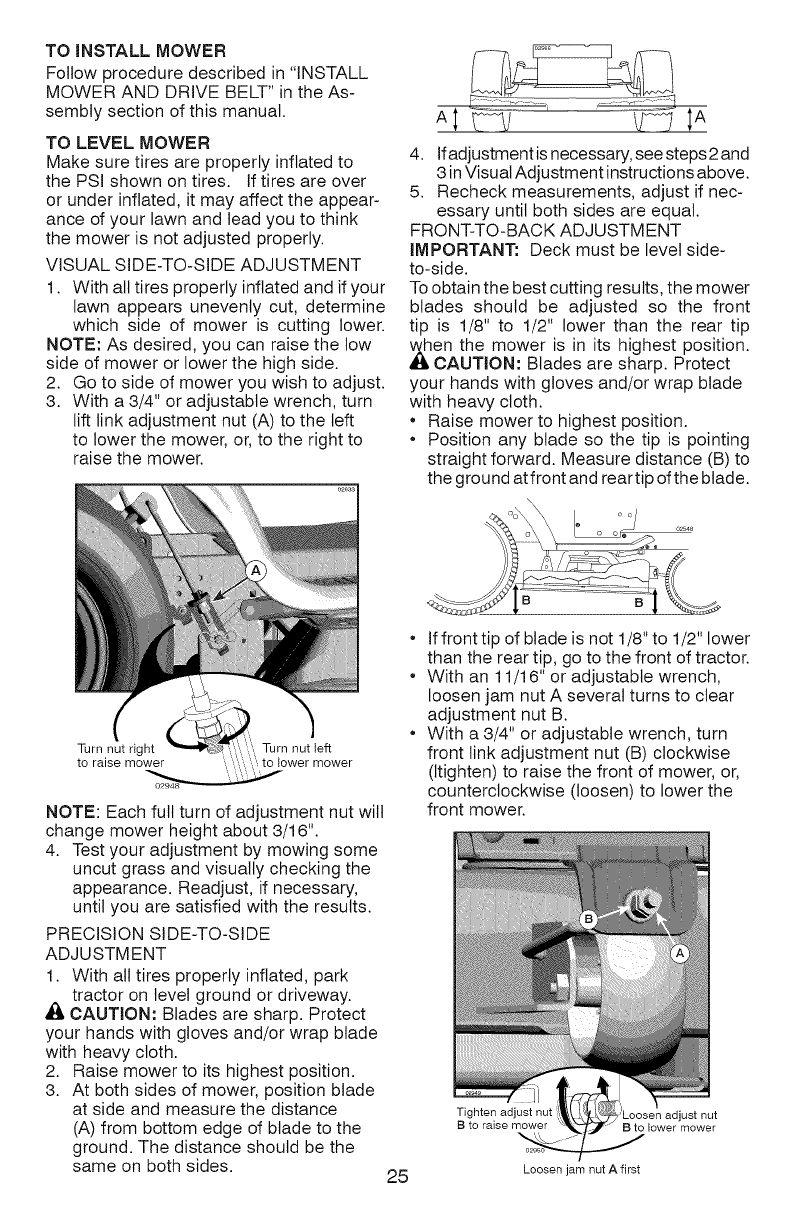
TO INSTALL MOWER
Follow procedure described in "INSTALL
MOWER AND DRIVE BELT" in the As-
sembly section of this manual.
TO LEVEL MOWER
Make sure tires are properly inflated to
the PSi shown on tires. If tires are over
or under inflated, it may affect the appear-
ance of your lawn and lead you to think
the mower is not adjusted properly.
VISUAL SIDE-TO-SIDE ADJUSTMENT
1. With all tires properly inflated and if your
lawn appears unevenly cut, determine
which side of mower is cutting lower.
NOTE: As desired, you can raise the low
side of mower or lower the high side.
2. Go to side of mower you wish to adjust.
3. With a 3/4" or adjustable wrench, turn
lift link adjustment nut (A) to the left
to lower the mower or, to the right to
raise the mower.
;A
4. Ifadjustment is necessary, see steps 2 and
3 in Visual Adjustment instructions above.
5. Recheck measurements, adjust if nec-
essary until both sides are equal.
FRONT-TO-BACK ADJUSTMENT
IMPORTANT: Deck must be level side-
to-side.
To obtain the best cutting results, the mower
blades should be adjusted so the front
tip is 1/8" to 1/2" lower than the rear tip
when the mower is in its highest position.
_ILCAUTION: Blades are sharp. Protect
your hands with gloves and/or wrap blade
with heavy cloth.
•Raise mower to highest position.
•Position any blade so the tip is pointing
straight forward. Measure distance (B) to
the ground at front and rear tip of the blade.
Turn nut right
to raise mower
Turn nut left
to lower mower
NOTE: Each full turn of adjustment nut will
change mower height about 3/16".
4. Test your adjustment by mowing some
uncut grass and visually checking the
appearance. Readjust, if necessary,
until you are satisfied with the results.
PRECISION SIDE-TO-SIDE
ADJUSTMENT
1. With all tires properly inflated, park
tractor on level ground or driveway.
CAUTION: Blades are sharp. Protect
your hands with gloves and/or wrap blade
with heavy cloth.
2. Raise mower to its highest position.
3. At both sides of mower, position blade
at side and measure the distance
(A) from bottom edge of blade to the
ground. The distance should be the
same on both sides. 25
* If fronttip of blade is not 1/8" to 1/2" lower
than the rear tip, go to the front of tractor.
* With an 11/16" or adjustable wrench,
loosen jam nut A several turns to clear
adjustment nut B.
* With a 3/4" or adjustable wrench, turn
front link adjustment nut (B) clockwise
(ltighten) to raise the front of mower, or,
counterclockwise (loosen) to lower the
front mower.
Tighten adjust nut Loosen adjust nut
B to raise mower B to lower mower
Loosen jam nut A first
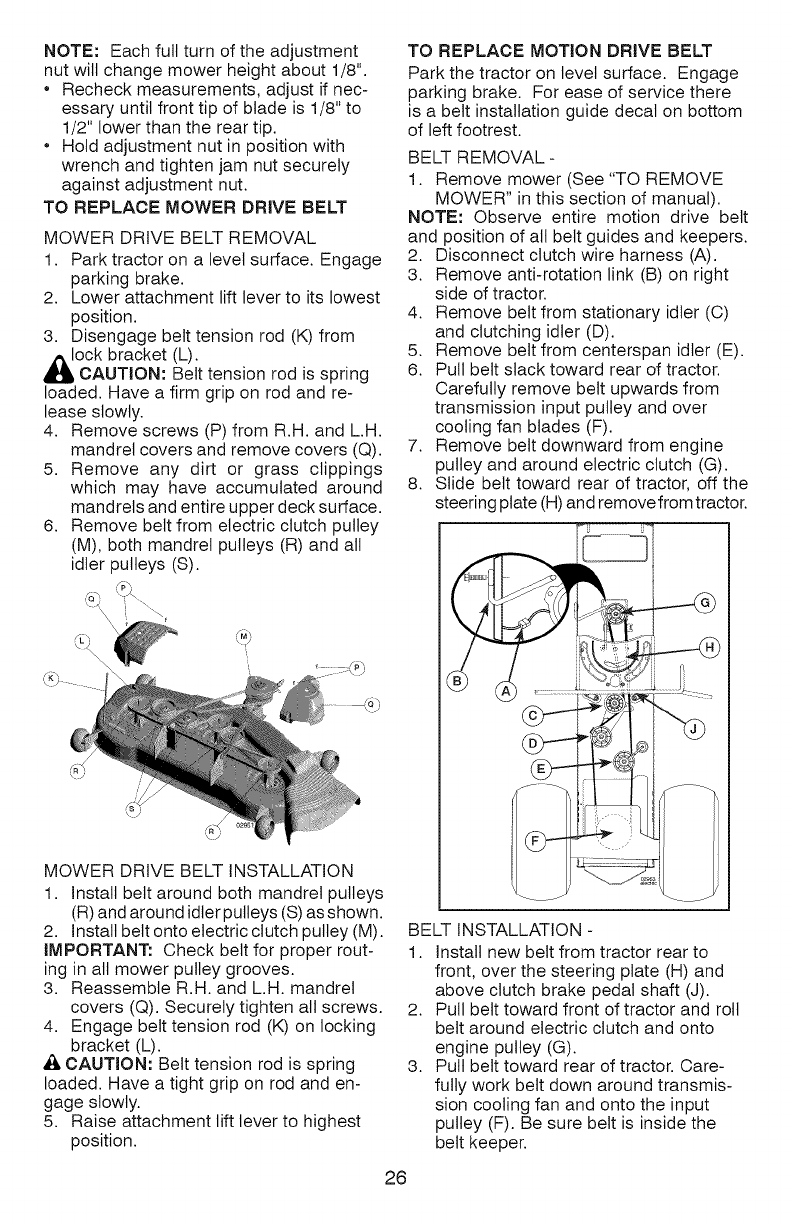
NOTE: Each full turn of the adjustment
nut will change mower height about 1/8".
Recheck measurements, adjust if nec-
essary until front tip of blade is 1/8" to
1/2" lower than the rear tip.
•Hold adjustment nut in position with
wrench and tighten jam nut securely
against adjustment nut.
TO REPLACE MOWER DRIVE BELT
MOWER DRIVE BELT REMOVAL
1. Park tractor on a level surface. Engage
parking brake.
2. Lower attachment lift lever to its lowest
position.
3. Disengage belt tension rod (K) from
ock bracket (L).
CAUTION: Belt tension rod is spring
loaded. Have a firm grip on rod and re-
lease slowly.
4. Remove screws (P) from R.H. and LH.
mandrel covers and remove covers (Q).
5. Remove any dirt or grass clippings
which may have accumulated around
mandrels and entire upper deck surface.
6. Remove belt from electric clutch pulley
(M), both mandrel pulleys (R) and all
idler pulleys (S).
MOWER DRIVE BELT INSTALLATION
1. Install belt around both mandrel pulleys
(R)and around idler pulleys (S) as shown.
2. Install belt onto electric clutch pulley (M).
iMPORTANT: Check belt for proper rout-
ing in all mower pulley grooves.
3. Reassemble R.H. and L.H. mandrel
covers (Q). Securely tighten all screws.
4. Engage belt tension rod (K) on locking
bracket (L).
CAUTION" Belt tension rod is spring
loaded. Have a tight grip on rod and en-
gage slowly.
5. Raise attachment lift lever to highest
position.
TO REPLACE MOTION DRIVE BELT
Park the tractor on level surface. Engage
parking brake. For ease of service there
is a belt installation guide decal on bottom
of left footrest.
BELT REMOVAL -
1. Remove mower (See "TO REMOVE
MOWER" in this section of manual).
NOTE: Observe entire motion drive belt
and position of all belt guides and keepers.
2. Disconnect clutch wire harness (A).
3. Remove anti-rotation link (B) on right
side of tractor.
4. Remove belt from stationary idler (C)
and clutching idler (D).
5. Remove belt from centerspan idler (E).
6. Pull belt slack toward rear of tractor.
Carefully remove belt upwards from
transmission input pulley and over
cooling fan blades (F).
7. Remove belt downward from engine
pulley and around electric clutch (G).
8. Slide belt toward rear of tractor, off the
steering plate (H)and remove from tractor.
BELT INSTALLATION -
1. Install new belt from tractor rear to
front, over the steering plate (H) and
above clutch brake pedal shaft (J).
2. Pull belt toward front of tractor and roll
belt around electric clutch and onto
engine pulley (G).
3. Putt belt toward rear of tractor. Care-
fully work belt down around transmis-
sion cooling fan and onto the input
pulley (F). Be sure belt is inside the
belt keeper.
26
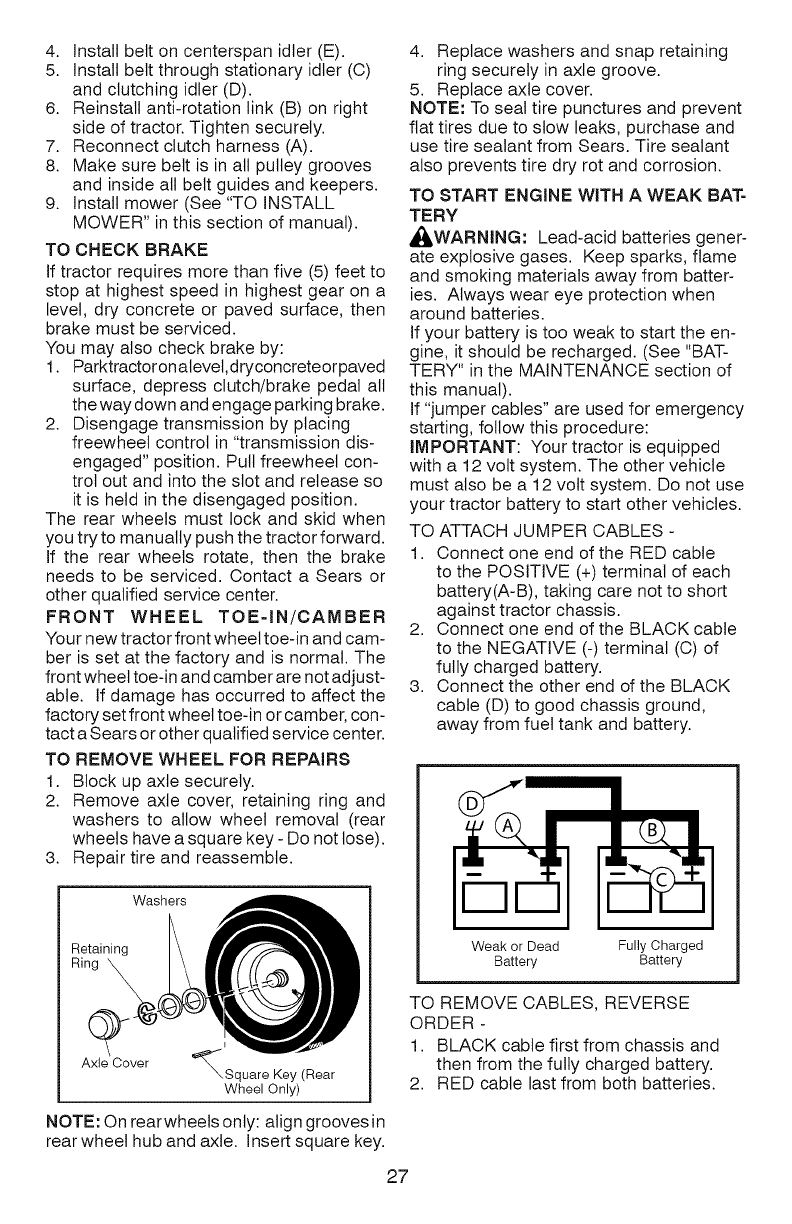
4. Install belt on centerspan idler (E).
5. Install belt through stationary idler (C)
and clutching idler (D).
6. Reinstall anti-rotation link (B) on right
side of tractor. Tighten securely.
7. Reconnect clutch harness (A).
8. Make sure belt is in all pulley grooves
and inside all belt guides and keepers.
9. Install mower (See "TO INSTALL
MOWER" in this section of manual).
TO CHECK BRAKE
If tractor requires more than five (5) feet to
stop at highest speed in highest gear on a
level, dry concrete or paved surface, then
brake must be serviced.
You may also check brake by:
1. Parktractoronalevet,dryconcreteorpaved
surface, depress clutch/brake pedal all
the way down and engage parking brake.
2. Disengage transmission by placing
freewheel control in "transmission dis-
engaged" position. Putt freewheel con-
trol out and into the slot and release so
it is held in the disengaged position.
The rear wheels must lock and skid when
you try to manually push the tractor forward.
If the rear wheels rotate, then the brake
needs to be serviced. Contact a Sears or
other qualified service center.
FRONT WHEEL TOE=IN/CAMBER
Your new tractor front wheel toe-in and cam-
ber is set at the factory and is normal. The
front wheel toe-in and camber are not adjust-
able. If damage has occurred to affect the
factory set front wheel toe-in or camber, con-
tact a Sears or other qualified service center.
TO REMOVE WHEEL FOR REPAIRS
1. Block up axle securely.
2. Remove axle cover, retaining ring and
washers to allow wheel removal (rear
wheels have a square key - Do not lose).
3. Repair tire and reassemble.
Washers
Retaining
Ring
i
Axle Cover
\Square Key (Rear
Wheel Only)
4. Replace washers and snap retaining
ring securely in axle groove.
5. Replace axle cover.
NOTE: To seat tire punctures and prevent
flat tires due to stow leaks, purchase and
use tire sealant from Sears. Tire sealant
also prevents tire dry rot and corrosion.
TO START ENGINE WITH A WEAK BAT-
TERY
_,WARNING: Lead-acid batteries gener-
ate explosive gases. Keep sparks, flame
and smoking materials away from batter-
ies. Always wear eye protection when
around batteries.
If your battery is too weak to start the en-
gine, it should be recharged. (See "BAT-
TERY" in the MAINTENANCE section of
this manual).
If "jumper cables" are used for emergency
starting, follow this procedure:
IMPORTANT: Your tractor is equipped
with a 12 volt system. The other vehicle
must also be a 12 volt system. Do not use
your tractor battery to start other vehicles.
TO ATTACH JUMPER CABLES -
1. Connect one end of the RED cable
to the POSITIVE (+) terminal of each
battery(A-B), taking care not to short
against tractor chassis.
2. Connect one end of the BLACK cable
to the NEGATIVE (-) terminal (C) of
fully charged battery.
3. Connect the other end of the BLACK
cable (D) to good chassis ground,
away from fuel tank and battery.
Weak or Dead Fully Charged
Battery Battery
TO REMOVE CABLES, REVERSE
ORDER -
1. BLACK cable first from chassis and
then from the fully charged battery.
2. RED cable last from both batteries.
NOTE: On rear wheels only: align grooves in
rear wheel hub and axle. Insert square key.
27
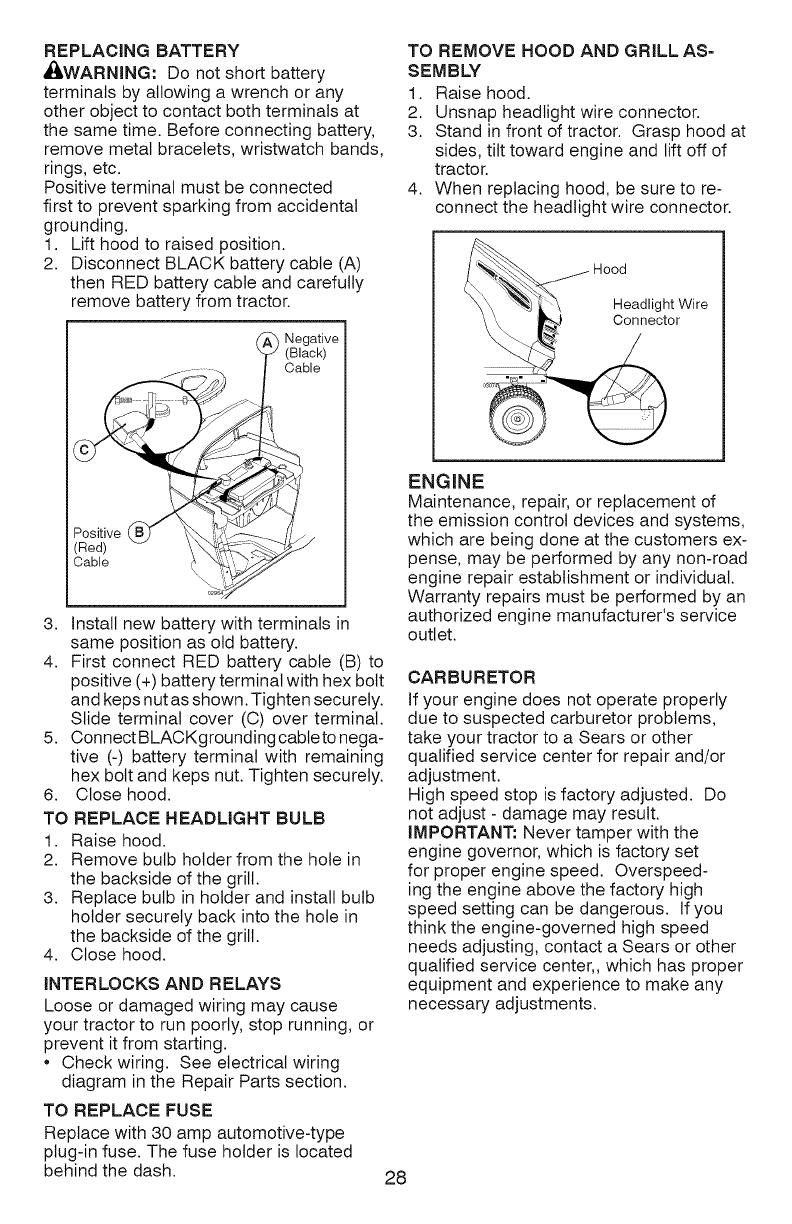
REPLACING BATTERY
AI_WARNING: Do not short battery
terminals by allowing a wrench or any
other object to contact both terminals at
the same time. Before connecting battery,
remove metal bracelets, wristwatch bands,
rings, etc.
Positive terminal must be connected
first to prevent sparking from accidental
grounding.
1. Lift hood to raised position.
2. Disconnect BLACK battery cable (A)
then RED battery cable and carefully
remove battery from tractor.
Positive
(Red)
Cable
Negative
(Black)
Cable
3. install new battery with terminals in
same position as old battery.
4. First connect RED battery cable (B) to
positive (+) battery terminal with hex bolt
and keps nutas shown. Tighten securely.
Slide terminal cover (0) over terminal.
5. Connect BLACKgrounding cable to nega-
tive (-) battery terminal with remaining
hex bolt and keps nut. Tighten securely.
6. Close hood.
TO REPLACE HEADLIGHT BULB
1. Raise hood.
2. Remove bulb holder from the hole in
the backside of the grill.
3. Replace bulb in holder and install bulb
holder securely back into the hole in
the backside of the grill.
4. Close hood.
INTERLOCKS AND RELAYS
Loose or damaged wiring may cause
your tractor to run poorly, stop running, or
prevent it from starting.
•Check wiring. See electrical wiring
diagram in the Repair Parts section.
TO REPLACE FUSE
Replace with 30 amp automotive-type
plug-in fuse. The fuse holder is located
behind the dash.
TO REMOVE HOOD AND GRILL AS=
SEMBLY
1. Raise hood.
2. Unsnap headlight wire connector.
3. Stand in front of tractor. Grasp hood at
sides, tilt toward engine and lift off of
tractor.
4. When replacing hood, be sure to re-
connect the headlight wire connector.
Headlight Wire
Connector
ENGINE
Maintenance, repair, or replacement of
the emission control devices and systems,
which are being done at the customers ex-
pense, may be performed by any non-road
engine repair establishment or individual.
Warranty repairs must be performed by an
authorized engine manufacturer's service
outlet.
CARBURETOR
If your engine does not operate properly
due to suspected carburetor problems,
take your tractor to a Sears or other
qualified service center for repair and/or
adjustment.
High speed stop is factory adjusted. Do
not adjust - damage may result.
IMPORTANT: Never tamper with the
engine governor, which is factory set
for proper engine speed. Overspeed-
ing the engine above the factory high
speed setting can be dangerous. If you
think the engine-governed high speed
needs adjusting, contact a Sears or other
qualified service center,, which has proper
equipment and experience to make any
necessary adjustments.
28
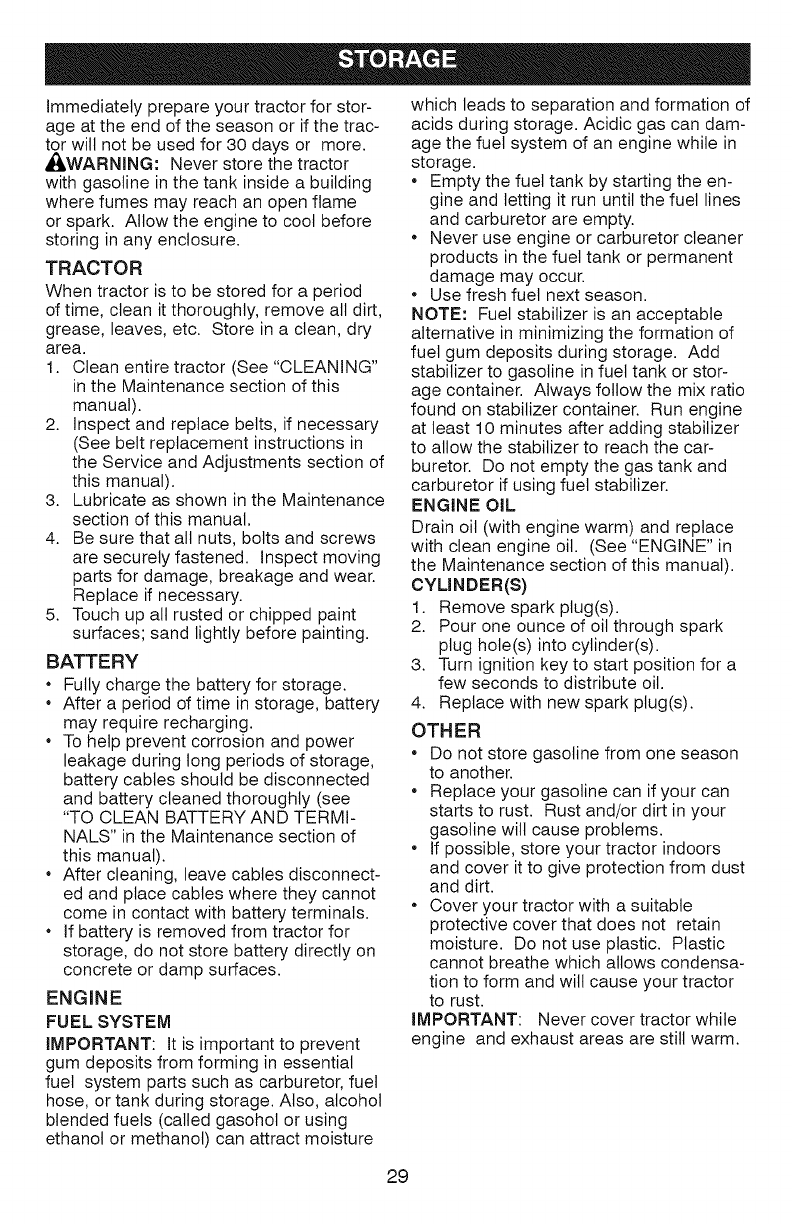
immediately prepare your tractor for stor-
age at the end of the season or if the trac-
tor wilt not be used for 30 days or more.
_WARNING: Never store the tractor
with gasoline in the tank inside a building
where fumes may reach an open flame
or spark. Allow the engine to cool before
storing in any enclosure.
TRACTOR
When tractor is to be stored for a period
of time, clean it thoroughly, remove all dirt,
grease, leaves, etc. Store in a clean, dry
area.
1. Clean entire tractor (See "CLEANING"
in the Maintenance section of this
manual).
2. Inspect and replace belts, if necessary
(See belt replacement instructions in
the Service and Adjustments section of
this manual).
3. Lubricate as shown in the Maintenance
section of this manual.
4. Be sure that all nuts, bolts and screws
are securely fastened. Inspect moving
parts for damage, breakage and wear.
Replace if necessary.
5. Touch up all rusted or chipped paint
surfaces; sand lightly before painting.
BATTERY
* Fully charge the battery for storage.
* After a period of time in storage, battery
may require recharging.
* To help prevent corrosion and power
leakage during tong periods of storage,
battery cables should be disconnected
and battery cleaned thoroughly (see
"TO CLEAN BATTERY AND TERMi-
NALS" in the Maintenance section of
this manual).
* After cleaning, leave cables disconnect-
ed and place cables where they cannot
come in contact with battery terminals.
* if battery is removed from tractor for
storage, do not store battery directly on
concrete or damp surfaces.
ENGINE
FUEL SYSTEM
IMPORTANT: It is important to prevent
gum deposits from forming in essential
fuel system parts such as carburetor, fuel
hose, or tank during storage. Also, alcohol
blended fuels (called gasohol or using
ethanol or methanol) can attract moisture
which leads to separation and formation of
acids during storage. Acidic gas can dam-
age the fuel system of an engine while in
storage.
Empty the fuel tank by starting the en-
gine and letting it run until the fuel lines
and carburetor are empty.
Never use engine or carburetor cleaner
products in the fuel tank or permanent
damage may occur.
Use fresh fuel next season.
NOTE: Fuel stabilizer is an acceptable
alternative in minimizing the formation of
fuel gum deposits during storage. Add
stabilizer to gasoline in fuel tank or stor-
age container. Always follow the mix ratio
found on stabilizer container. Run engine
at least 10 minutes after adding stabilizer
to allow the stabilizer to reach the car-
buretor. Do not empty the gas tank and
carburetor if using fuel stabilizer.
ENGINE OiL
Drain oil (with engine warm) and replace
with clean engine oil. (See "ENGINE" in
the Maintenance section of this manual).
CYLINDER(S)
1. Remove spark plug(s).
2. Pour one ounce of oil through spark
plug hole(s) into cylinder(s).
3. Turn ignition key to start position for a
few seconds to distribute oil.
4. Replace with new spark plug(s).
OTHER
•Do not store gasoline from one season
to another.
•Replace your gasoline can if your can
starts to rust. Rust and/or dirt in your
gasoline will cause problems.
•if possible, store your tractor indoors
and cover it to give protection from dust
and dirt.
•Cover your tractor with a suitable
protective cover that does not retain
moisture. Do not use plastic. Plastic
cannot breathe which allows condensa-
tion to form and will cause your tractor
to rust.
IMPORTANT: Never cover tractor while
engine and exhaust areas are still warm.
29
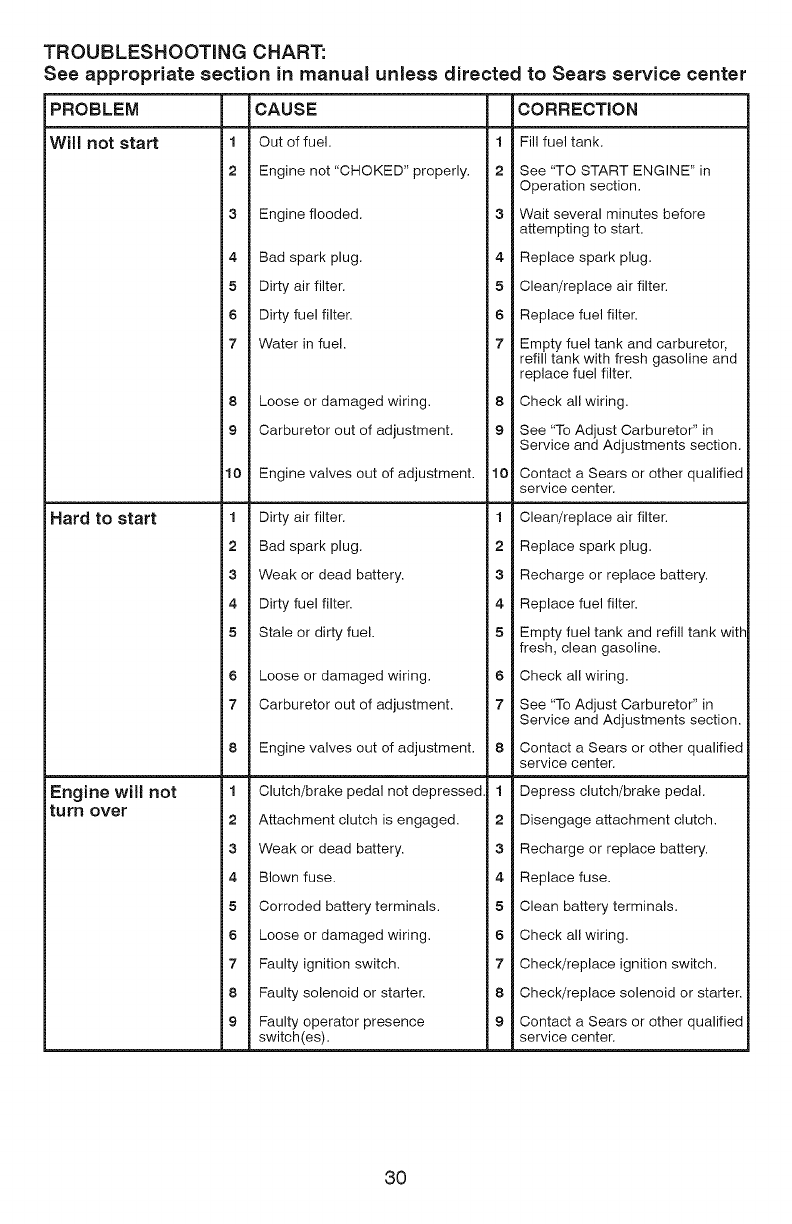
TROUBLESHOOTING CHART:
See appropriate section in rnanual unless directed to Sears service center
PROBLEM CAUSE CORRECTION
Will not start 1 Out of fuel. 1 Fill fuel tank.
2Engine not "CHOKED" properly. 2See "TO START ENGINE" in
Operation section.
3Engine flooded. 3Wait several minutes before
attempting to start.
4 Bad spark plug. 4 Replace spark plug.
5Dirty air filter. 5Clean/replace air filter.
6 Dirty fuel filter. 6 Replace fuel filter.
7Water in fuel. 7Empty fuel tank and carburetor,
refill tank with fresh gasoline and
replace fuel filter.
8 Loose or damaged wiring. 8 Check all wiring.
9 Carburetor out of adjustment. 9 See "To Adjust Carburetor" in
Service and Adjustments section.
10 Engine valves out of adjustment. 10 Contact a Sears or other qualified
service center.
Hard to start 1 Dirtyair filter.
2Bad spark plug.
3Weak or dead battery.
4 Dirty fuel filter.
5Stale or dirty fuel.
6 Loose or damaged wiring.
7Carburetor out of adjustment.
8 Engine valves out of adjustment.
1 Clean/replace air filter.
2Replace spark plug.
3Recharge or replace battery.
4 Replace fuel filter.
5Empty fuel tank and refill tank with
fresh, clean gasoline.
6 Check all wiring.
7See "To Adjust Carburetor" in
Service and Adjustments section.
8 Contact a Sears or other qualified
service center.
Engine will not
turn over 1 Clutch/brake pedal not depressed. 1 Depress clutch/brake pedal.
2 Attachment clutch is engaged. 2 Disengage attachment clutch.
3Weak or dead battery. 3Recharge or replace battery.
4 Blown fuse. 4 Replace fuse.
5 Corroded battery terminals. 5 Clean battery terminals.
6Loose or damaged wiring. 6Check all wiring.
7 Faulty ignition switch. 7 Check/replace ignition switch.
8 Faulty solenoid or starter. 8 Check/replace solenoid or starter.
9Faulty operator presence 9Contact a Sears or other qualified
switch(es), service center.
30
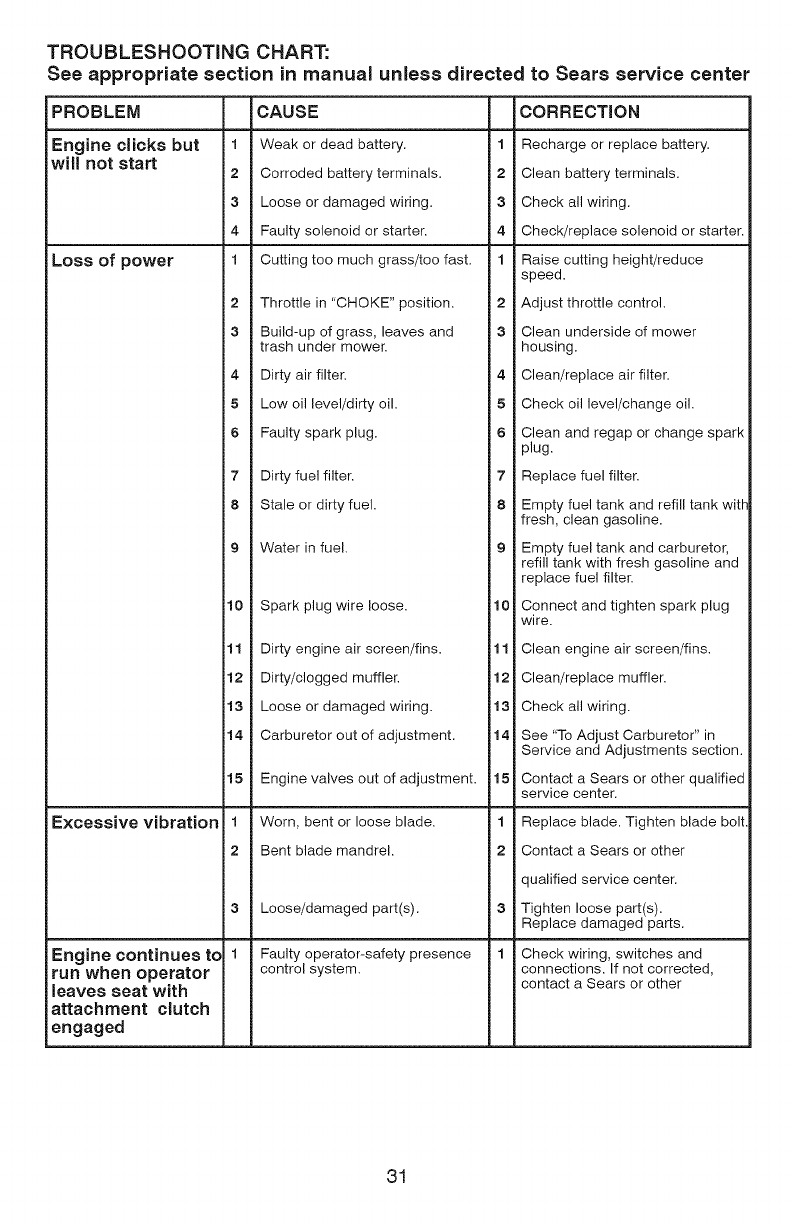
TROUBLESHOOTING CHART:
See appropriate section in manual unless directed to Sears service center
PROBLEM
Engine clicks but
will not start
Loss of power
Excessive vibration
Engine continues t¢
run when operator
leaves seat with
attachment clutch
engaged
CAUSE CORRECTION
1 Weak or dead battery. 1 Recharge or replace battery.
2 Corroded battery terminals. 2 Clean battery terminals.
3 Loose or damaged wiring. 3 Check all wiring.
4 Faulty solenoid or starter. 4 Check/replace solenoid or starter.
1 Cutting too much grass/too fast. 1 Raise cutting height/reduce
speed.
2 Throttle in "CHOKE" position. 2 Adjust throttle control.
3Build-up of grass, leaves and 3Clean underside of mower
trash under mower, housing.
4 Dirty air filter. 4 Clean/replace air filter.
5 Low oil level/dirty oil. 5 Check oil level/change oil.
6 Faulty spark plug. 6 Clean and regap or change spark
plug.
7 Dirty fuel filter. 7 Replace fuel filter.
8Stale or dirty fuel. 8Empty fuel tank and refill tank wig-
fresh, clean gasoline.
9 Water in fuel. 9 Empty fuel tank and carburetor,
refill tank with fresh gasoline and
replace fuel filter.
10 Spark plug wire loose. 10 Connect and tighten spark plug
wire.
11 Dirty engine air screen/fins. 11 Clean engine air screen/fins.
12 Dirty/clogged muffler. 12 Clean/replace muffler.
13 Loose or damaged wiring. 13 Check all wiring.
14 Carburetor out of adjustment. 14 See "To Adjust Carburetor" in
Service and Adjustments section.
15 Engine valves out of adjustment. 15 Contact a Sears or other qualified
service center.
1 Worn, bent or loose blade. 1 Replace blade. Tighten blade bolt
2 Bent blade mandrel. 2 Contact a Sears or other
qualified service center.
3 Loose/damaged part(s). 3 Tighten loose part(s).
Replace damaged parts.
1 Faulty operator-safety presence 1 Check wiring, switches and
control system, connections. If not corrected,
contact a Sears or other
31
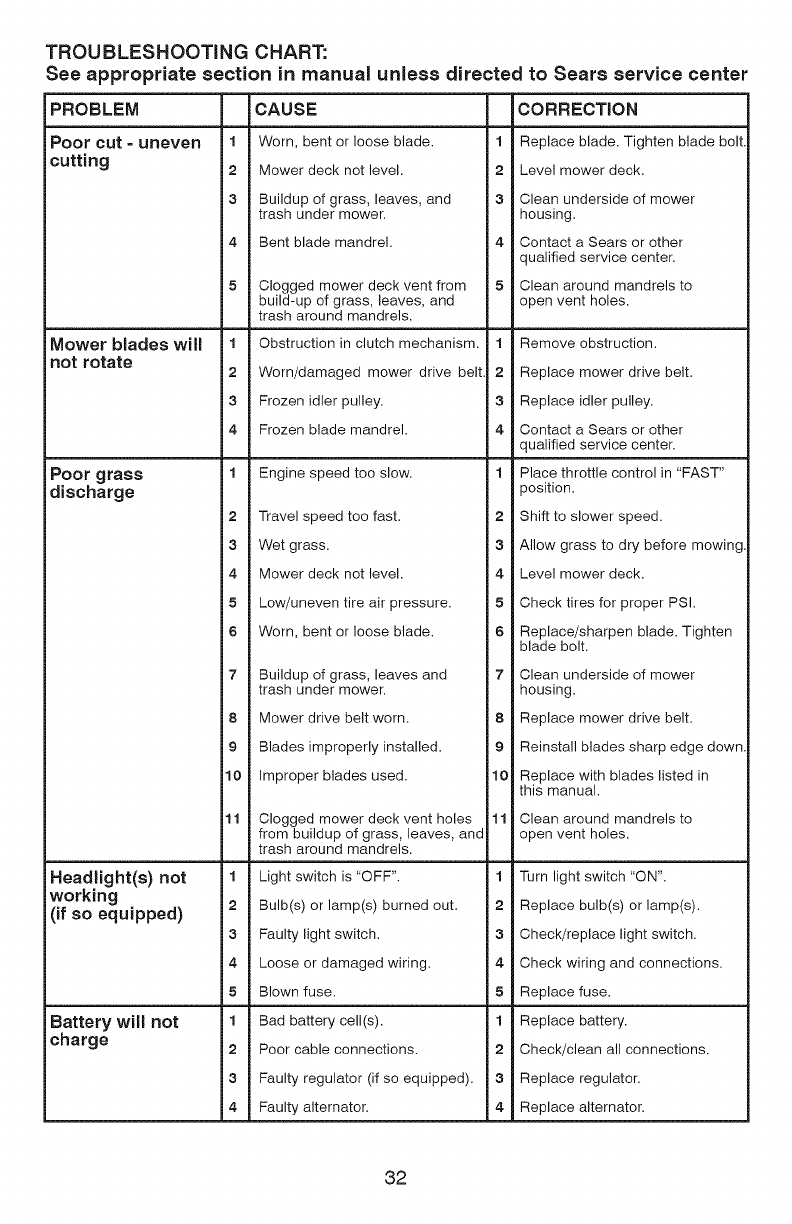
TROUBLESHOOTING CHART:
See appropriate section in manual unless directed to Sears service center
PROBLEM
Poor cut -uneven
cutting
Mower blades will
not rotate
Poor grass
discharge
Headlight(s) not
working
(if so equipped)
Battery will not
charge
CAUSE
1 Worn, bent or loose blade. 1
2 Mower deck not level. 2
3Buildup of grass, leaves, and 3
trash under mower.
4 Bent blade mandrel. 4
5 Clogged mower deck vent from
build-up of grass, leaves, and
trash around mandrels.
1 Obstruction in clutch mechanism.
2 Worn/damaged mower drive belt.
3 Frozen idler pulley.
4 Frozen blade mandrel.
1 Engine speed too slow.
2 Travel speed too fast.
3 Wet grass.
4 Mower deck not level.
5 Low/uneven tire air pressure.
6 Worn, bent or loose blade.
7 Buildup of grass, leaves and
trash under mower.
8 Mower drive belt worn.
9 Blades improperly installed.
10 Improper blades used.
11 Clogged mower deck vent holes
from buildup of grass, leaves, and
trash around mandrels.
1 Light switch is "OFF".
2 Bulb(s) or lamp(s) burned out.
3 Faulty light switch.
4 Loose or damaged wiring.
5 Blown fuse.
1 Bad battery cell(s).
2 Poor cable connections.
3 Faulty regulator (if so equipped).
4 Faulty alternator.
CORRECTION
Replace blade. Tighten blade bolt.
Level mower deck.
Clean underside of mower
housing.
Contact a Sears or other
qualified service center.
Clean around mandrels to
open vent holes.
1 Remove obstruction.
2 Replace mower drive belt.
3 Replace idler pulley.
4 Contact a Sears or other
qualified service center.
1 Place throttle control in "FAST"
position.
2 Shift to slower speed.
3 Allow grass to dry before mowing.
4 Level mower deck.
5Check tires for proper PSI.
6 Replace/sharpen blade. Tighten
blade bolt.
7 Clean underside of mower
housing.
8 Replace mower drive belt.
9 Reinstall blades sharp edge down.
10 Replace with blades listed in
this manual.
11 Clean around mandrels to
open vent holes.
1 Turn light switch "ON".
2 Replace bulb(s) or lamp(s).
3 Check/replace light switch.
4 Check wiring and connections.
5 Replace fuse.
1 Replace battery.
2 Check/clean all connections.
3 Replace regulator.
4 Replace alternator.
32
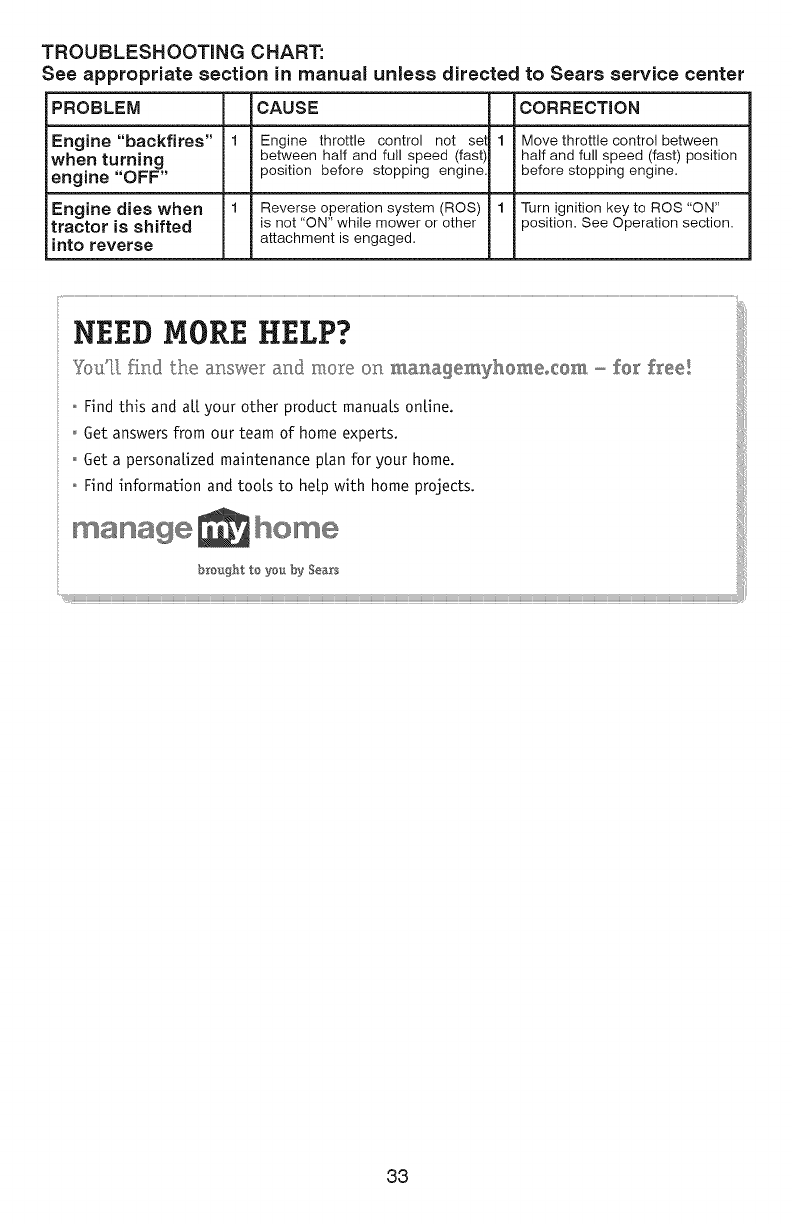
TROUBLESHOOTING CHART:
See appropriate section in manual unless directed to Sears service center
PROBLEM CAUSE CORRECTION
Engine "backfires"
when turning
engine "OFF"
Engine dies when
tractor is shifted
into reverse
1 Engine throttle control not se
between half and full speed (fast'
position before stopping engine
1 Reverse operation system (ROS)
is not "ON" while mower or other
attachment is engaged.
1 Move throttle control between
half and full speed (fast) position
before stopping engine.
1 Turn ignition key to ROS "ON"
position. See Operation section.
.EEDMoRE..
-Find this and all. your other product manuals online.
oGet answers from our team of home experts.
:: o Get a personalized maintenance ptan for your home.
:: - Find information and tooB to hel.p with home projects.
manage home i
33
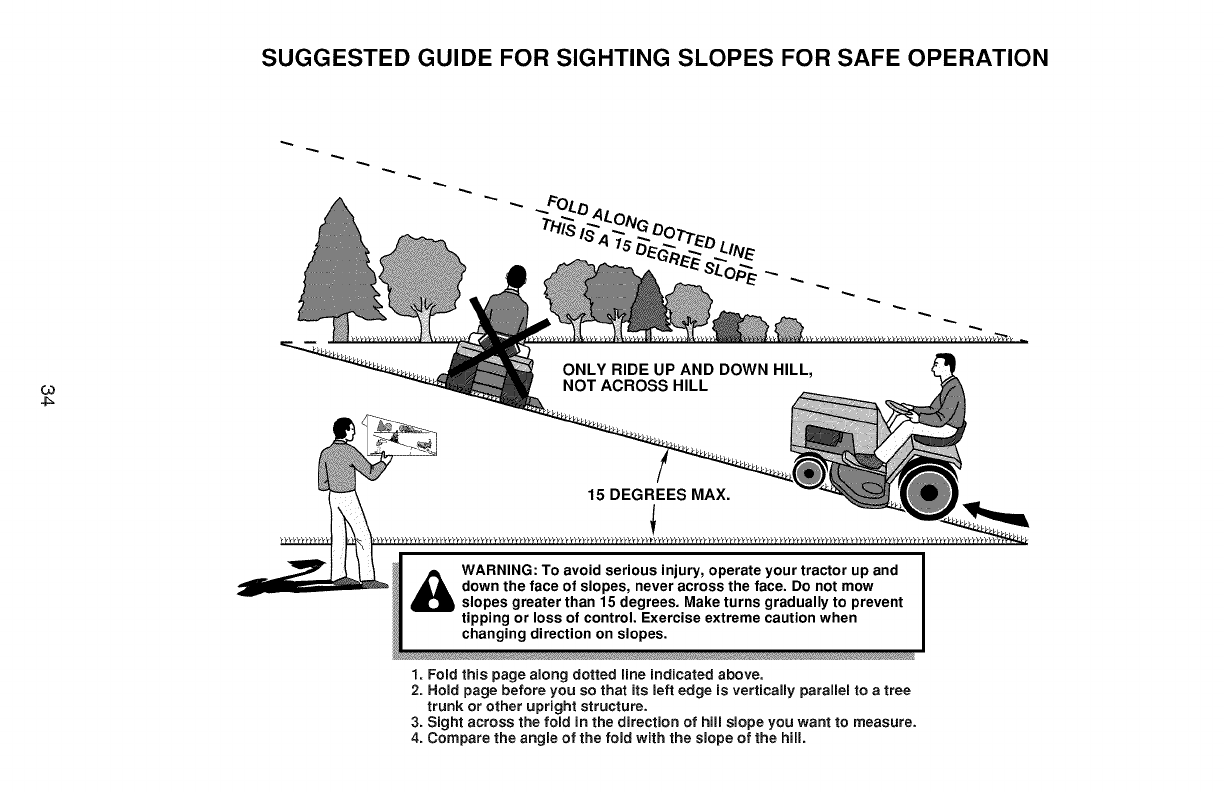
SUGGESTED GUIDE FOR SIGHTING SLOPES FOR SAFE OPERATION
co
4:=
_k ARNING: To avoid serious injury, operate your tractor up and
down the face of slopes, never across the face. Do not mow
slopes greater than 15 degrees. Make turns gradually to prevent
tipping or loss of control. Exercise extreme caution when
changing direction on slopes.
1_ Fold this page along dotted line indicated above_
2_ Hold page before you so that its left edge is vertically parallel to atree
trunk or other upright structure_
3_ Sight across the fold in the direction of hill slope you want to measure_
4_ Compare the angle of the fold with the slope of the hill.
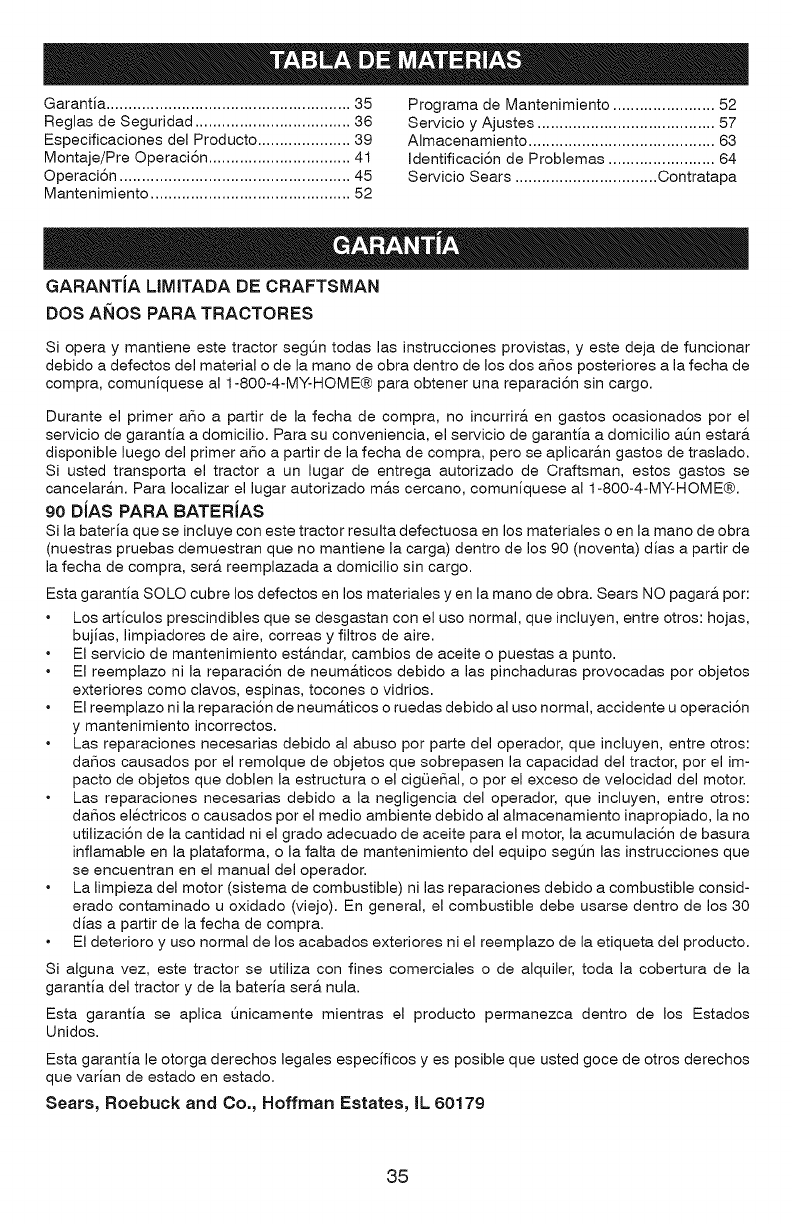
Garantia ....................................................... 35 Programa de Mantenimiento ....................... 52
Reglas de Seguridad ................................... 36 Servicio y Ajustes ........................................ 57
Especificaciones del Producto ..................... 39 Almacenamiento .......................................... 63
Montaje/Pre Operaci6n ................................ 41 identificaci6n de Problemas ........................ 64
Operaci6n .................................................... 45 Servicio Sears ................................ Contratapa
Mantenimiento ............................................. 52
GARANTiA LIMITADA DE CRAFTSMAN
DOS ANOS PARA TRACTORES
Si opera y mantiene este tractor segOn todas las instrucciones provistas, y este deja de funcionar
debido a defectos del material o de la mano de obra dentro de los dos aSos posteriores a la fecha de
compra, comuniquese al 1-800-4-MY-HOME® para obtener una reparaci6n sin cargo.
Durante el primer aSo a partir de la fecha de compra, no incurrir& en gastos ocasionados por el
servicio de garantia a domicilio. Para su conveniencia, el servicio de garantia a domicilio aQn estar&
disponible luego del primer aSo a partir de la fecha de compra, pero se aplicar&n gastos de traslado.
Si usted transporta el tractor a un lugar de entrega autorizado de Craftsman, estos gastos se
cancelar&n. Para Iocalizar el lugar autorizado m&s cercano, comuniquese al 1-800-4-MY-HOME®.
90 DiAS PARA BATERiAS
Si la bateria que se incluye con este tractor resulta defectuosa en los materiales o en la mano de obra
(nuestras pruebas demuestran que no mantiene la carga) dentro de los 90 (noventa) dias a partir de
la fecha de compra, ser& reemplazada a domicilio sin cargo.
Esta garantia SOLO cubre los defectos en los materiales yen la mano de obra. Sears NO pagar& por:
Los articulos prescindibles que se desgastan con el uso normal, que incluyen, entre otros: hojas,
bujias, limpiadores de aire, correas y filtros de aire.
El servicio de mantenimiento est_.ndar, cambios de aceite o puestas a punto.
El reemplazo ni la reparaciSn de neum&ticos debido alas pinchaduras provocadas por objetos
exteriores como clavos, espinas, tocones o vidrios.
El reemplazo ni la reparaciSn de neum&ticos o ruedas debido al uso normal, accidente u operaciSn
y mantenimiento incorrectos.
Las reparaciones necesarias debido al abuso por parte del operador, que incluyen, entre otros:
daSos causados por el remolque de objetos que sobrepasen la capacidad del tractor, por el im-
pacto de objetos que doblen la estructura oel cigL_e_al, o por el exceso de velocidad del motor.
Las reparaciones necesarias debido a la negligencia del operador, que incluyen, entre otros:
daSos electricos o causados por el medio ambiente debido al almacenamiento inapropiado, la no
utilizaciSn de la cantidad ni el grado adecuado de aceite para el motor, la acumulaciSn de basura
inflamable en la plataforma, o la falta de mantenimiento del equipo segQn las instrucciones que
se encuentran en el manual del operador.
La limpieza del motor (sistema de combustible) ni las reparaciones debido a combustible consid-
erado contaminado u oxidado (viejo). En general, el combustible debe usarse dentro de los 30
dias a partir de la fecha de compra.
El deterioro y uso normal de los acabados exteriores ni el reemplazo de la etiqueta del producto.
Si alguna vez, este tractor se utiliza con fines comerciales o de alquiler, toda la cobertura de la
garantia del tractor y de la bateria ser& nula.
Esta garantia se aplica Qnicamente mientras el producto permanezca dentro de los Estados
Unidos.
Esta garantia le otorga derechos legales especificos yes posible que usted goce de otros derechos
que varian de estado en estado.
Sears, Roebuck and Co., Hoffrnan Estates, IL 60179
35
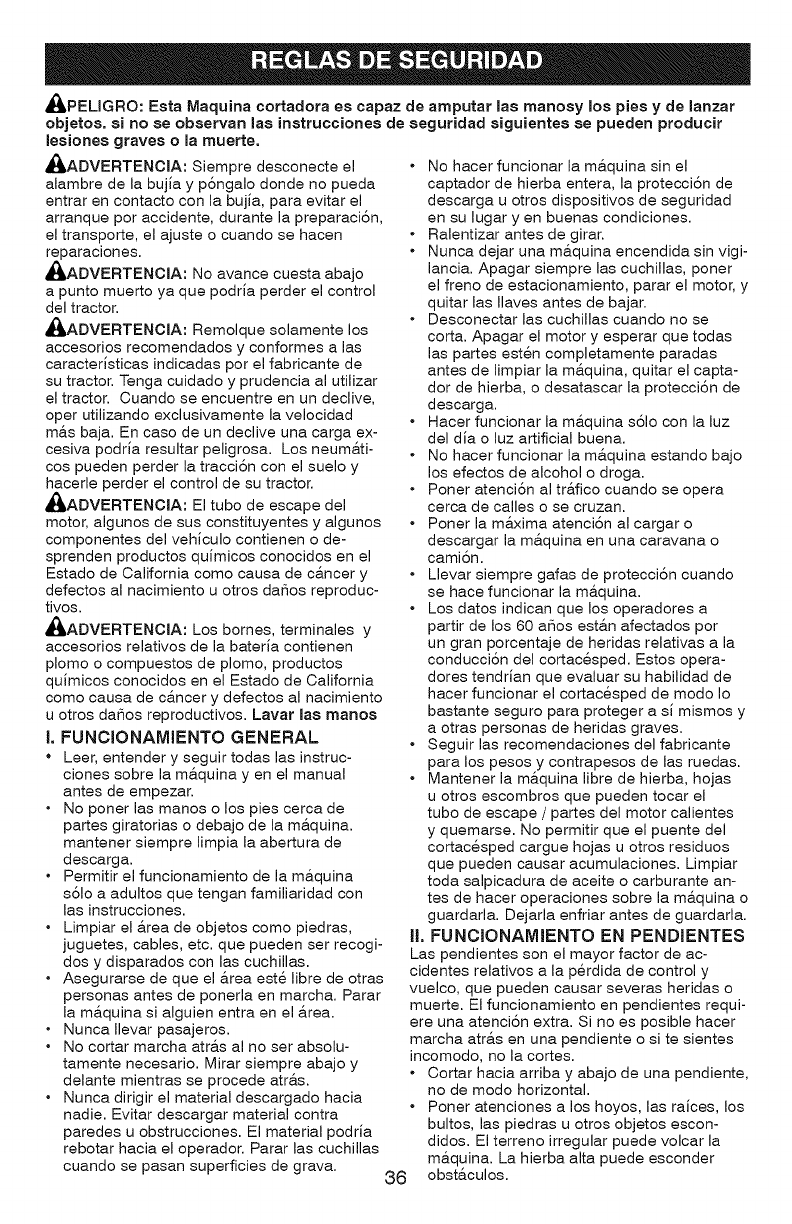
_PELIGRO: Esta Maquina cortadora es eapaz de amputar las manosy los pies y de lanzar
objetos, si no se observan las instrucciones de seguridad siguientes se pueden producir
lesiones graves o la rnuerte.
_ADVERTENCIA: Siempre desconecte el
alambre de la bujia y p6ngalo donde no pueda
entrar en contacto con la bujia, para evitar el
arranque por accidente, durante la preparaci6n,
el transporte, el ajuste o cuando se hacen
reparaciones.
_ADVERTENOiA: No avance cuesta abajo
a punto muerto ya que podria perder el control
del tractor.
_DVERTENOiA: Remolque solamente los
accesorios recomendados y conformes alas
caracteristicas indicadas por el fabricante de
su tractor. Tenga cuidado y prudencia al utilizar
el tractor. Cuando se encuentre en un declive,
oper utilizando exclusivamente la velocidad
m&s baja. En caso de un declive una carga ex-
cesiva podria resultar peligrosa. Los neum&ti-
cos pueden perder la tracci6n con el suelo y
hacerle perder el control de su tractor.
_DVERTENOIA: El tubo de escape del
motor, algunos de sus constituyentes y algunos
componentes del vehiculo contienen o de-
sprenden productos quimicos conocidos en el
Estado de California como causa de c&ncer y
defectos al nacimiento u otros daSos reproduc-
tivos.
_I_,ADVERTENOIA: Los bornes, terminales y
accesorios relativos de la bateria contienen
plomo o compuestos de plomo, productos
quimicos conocidos en el Estado de California
como causa de c&ncer y defectos al nacimiento
u otros da_os reproductivos. Lavar las manos
I, FUNCIONAMIENTO GENERAL
•Leer, entender y seguir todas las instruc-
clones sobre la m&quina yen el manual
antes de empezar.
•No poner las manos o los pies cerca de
partes giratorias o debajo de la m&quina.
mantener siempre limpia la abertura de
descarga.
• Permitir el funcionamiento de la m&quina
s61o a adultos que tengan familiaridad con
las instrucciones.
• Limpiar el &rea de objetos como piedras,
juguetes, cables, etc. que pueden ser recogi-
dos y disparados con las cuchillas.
• Asegurarse de que el &rea este libre de otras
personas antes de ponerla en marcha. Parar
la m&quina si alguien entra en el &tea.
• Nunca Ilevar pasajeros.
• No cortar marcha atr&s al no ser absolu-
tamente necesario. Mirar siempre abajo y
delante mientras se procede atr&s.
• Nunca dirigir el material descargado hacia
nadie. Evitar descargar material contra
paredes u obstrucciones. El material podria
rebotar hacia el operador. Parar las cuchillas
cuando se pasan superficies de grava.
•No hacer funcionar la m&quina sin el
captador de hierba entera, la protecci6n de
descarga u otros dispositivos de seguridad
en su lugar yen buenas condiciones.
•Ralentizar antes de girar.
•Nunca dejar una m_.quina encendida sin vigi-
lancia. Apagar siempre las cuchillas, poner
el freno de estacionamiento, parar el motor, y
quitar las Ilaves antes de bajar.
•Desconectar las cuchillas cuando no se
corta. Apagar el motor y esperar que todas
las partes esten completamente paradas
antes de limpiar la m&quina, quitar el capta-
dor de hierba, o desatascar la protecci6n de
descarga.
•Hacer funcionar la m&quina s61o con la luz
del dia o luz artificial buena.
•No hacer funcionar la m&quina estando bajo
los efectos de alcohol o droga.
•Poner atenci6n al tr&fico cuando se opera
cerca de calles o se cruzan.
• Poner la m&xima atenci6n al cargar o
descargar la m&quina en una caravana o
cami6n.
• Llevar siempre gafas de protecci6n cuando
se hace funcionar la m_.quina.
•Los datos indican que los operadores a
partir de los 60 aSos est_.n afectados por
un gran porcentaje de heridas relativas a la
conducci6n del cortacesped. Estos opera-
dores tendrian que evaluar su habilidad de
hacer funcionar el cortacesped de modo Io
bastante seguro para proteger a si mismos y
a otras personas de heridas graves.
• Seguir las recomendaciones del fabricante
para los pesos y contrapesos de las ruedas.
• Mantener la m&quina libre de hierba, hojas
u otros escombros que pueden tocar el
tubo de escape /partes del motor calientes
y quemarse. No permitir que el puente del
cortacesped cargue hojas u otros residuos
que pueden causar acumulaciones. Limpiar
toda salpicadura de aceite o carburante an-
tes de hacer operaciones sobre la m&quina o
guardarla. Dejarla enfriar antes de guardarla.
II. FUNCIONAMIENTO EN PENDIENTES
Las pendientes son el mayor factor de ac-
cidentes relativos a la perdida de control y
vuelco, que pueden causar severas heridas o
muerte. El funcionamiento en pendientes requi-
ere una atenci6n extra. Si no es posible hacer
marcha atr&s en una pendiente o site sientes
incomodo, no la cortes.
• Cortar hacia arriba y abajo de una pendiente,
no de modo horizontal.
•Poner atenciones a los hoyos, las raices, los
bultos, las piedras u otros objetos escon-
didos. El terreno irregular puede volcar la
m_.quina. La hierba alta puede esconder
36 obst&culos.
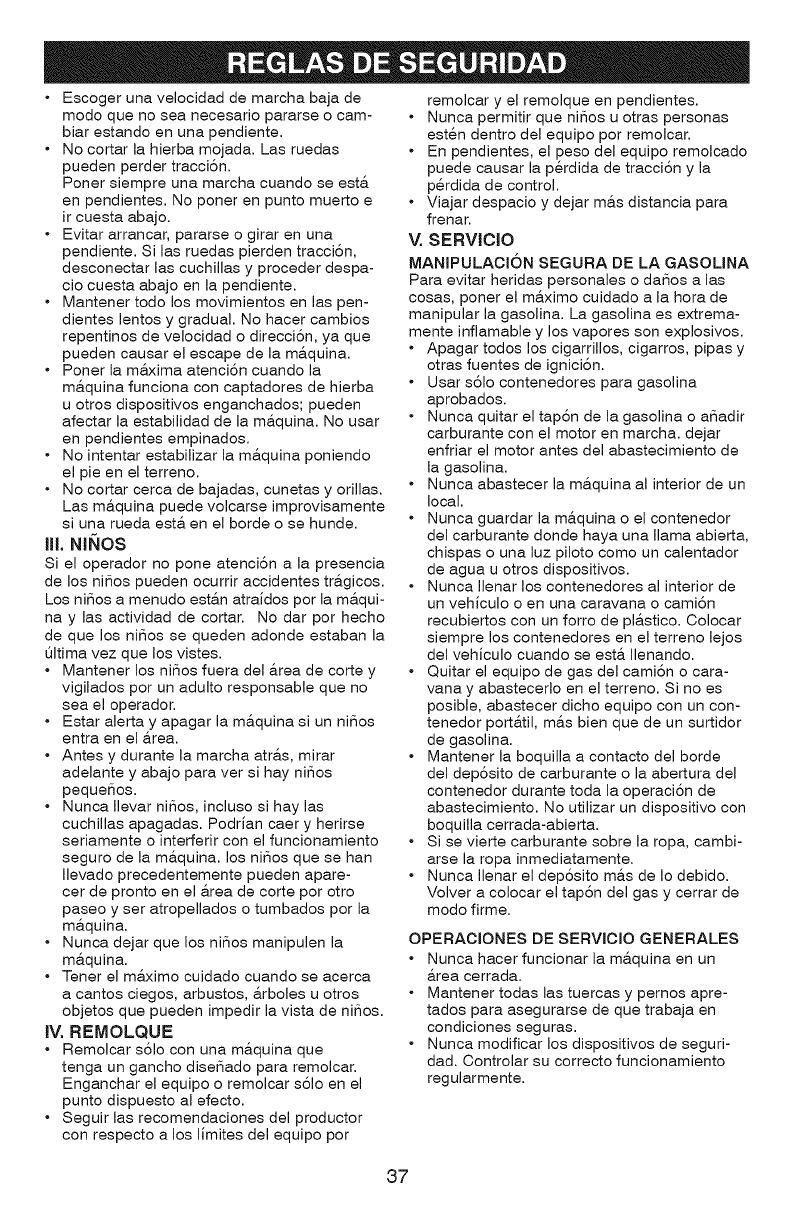
•Escoger una velocidad de marcha baja de
modo que no sea necesario pararse o cam-
biar estando en una pendiente.
•No cortar la hierba mojada. Las ruedas
pueden perder tracci6n.
Porter siempre una marcha cuando se esta
en pendientes. No porter en punto muerto e
ir cuesta abajo.
•Evitar arrancar, pararse o girar en una
pendiente. Si las ruedas pierden tracci6n,
desconectar las cuchillas y proceder despa-
cio cuesta abajo en la pendiente.
•Mantener todo los movimientos en las pen-
dientes lentos y gradual. No hacer cambios
repentinos de velocidad o direcci6n, ya que
pueden causar el escape de la ma.quina.
•Poner la m&xima atenci6n cuando la
m&quina funciona con captadores de hierba
u otros dispositivos enganchados; pueden
afectar la estabilidad de la m&quina. No usar
en pendientes empinados.
• No intentar estabilizar la m&quina poniendo
el pie en el terreno.
•No cortar cerca de bajadas, cunetas y orillas.
Las m&quina puede volcarse improvisamente
si una rueda est& en el borde o se hunde.
m. NINOS
Si el operador no pone atenciSn a la presencia
de los niSos pueden ocurrir accidentes tr&gicos.
Los niSos a menudo est&n atraidos por la m&qui-
na y las actividad de cortar. No dar por hecho
de que los niSos se queden adonde estaban la
Qltima vez que los vistes.
•Mantener los ni_os fuera del @.reade corte y
vigilados por un adulto responsable que no
sea el operador.
• Estar alerta y apagar la m&quina si un ni_os
entra en el &rea.
• Antes y durante la marcha atr&s, mirar
adelante y abajo para ver si hay niSos
pequeSos.
• Nunca Ilevar niSos, incluso si hay las
cuchillas apagadas. Podrian caer y herirse
seriamente o interferir con el funcionamiento
seguro de la m&quina, los niSos que se hart
Ilevado precedentemente pueden apare-
cer de pronto en el &rea de corte por otro
paseo y ser atropellados o tumbados por la
m&quina.
• Nunca dejar que los niSos manipulen la
m&quina.
•Tener el m&ximo cuidado cuando se acerca
a cantos ciegos, arbustos, &tholes u otros
objetos que pueden impedir la vista de niSos.
IV. REMOLQUE
•Remolcar s61o con una maquina que
tenga un gancho dise_ado para remolcar.
Enganchar el equipo o remolcar s61o en el
punto dispuesto al efecto.
•Seguir las recomendaciones del productor
con respecto a los limites del equipo por
remolcar y el remolque en pendientes.
• Nunca permitir que niSos u otras personas
esten dentro del equipo por remolcar.
• En pendientes, el peso del equipo remolcado
puede causar la perdida de tracciSn y la
perdida de control.
•Viajar despacio y dejar m&s distancia para
frenar.
V. SERVIOIO
MANIPULACI6N SEGURA DE LA GASOLJNA
Para evitar heridas personales o daSos a las
cosas, poner el m&ximo cuidado a la hora de
manipular la gasolina. La gasolina es extrema-
mente inflamable y los vapores son explosivos.
• Apagar todos los cigarrillos, cigarros, pipas y
otras fuentes de igniciSn.
• Usar s61o contenedores para gasolina
aprobados.
• Nunca quitar el tap6n de la gasolina o aSadir
carburante con el motor en marcha, dejar
enfriar el motor antes del abastecimiento de
la gasolina.
• Nunca abastecer la m&quina al interior de un
local.
• Nunca guardar la m&quina o el contenedor
del carburante donde haya una llama abierta,
chispas o una luz piloto como un calentador
de agua u otros dispositivos.
•Nunca Ilenar los contenedores al interior de
un vehiculo o en una caravana o cami6n
recubiertos con un forro de pl&stico. Colocar
siempre los contenedores en el terreno lejos
del vehiculo cuando se est& Ilenando.
•Quitar el equipo de gas del cami6n o cara-
vana y abastecerlo en el terreno. Si no es
posible, abastecer dicho equipo con un con-
tenedor port&til, m&s bien que de un surtidor
de gasolina.
•Mantener la boquilla a contacto del borde
del dep6sito de carburante o la abertura del
contenedor durante toda la operaci6n de
abastecimiento. No utilizar un dispositivo con
boquilla cerrada-abierta.
•Si se vierte carburante sobre la ropa, cambi-
arse la ropa inmediatamente.
•Nunca Ilenar el dep6sito m&s de Io debido.
Volver a colocar el tap6n del gas y cerrar de
mode firme.
OPERACJONES DE SERVICJO GENERALES
• Nunca hacer funcionar la m&quina en un
&rea cerrada.
• Mantener todas las tuercas y pemos apre-
tados para asegurarse de que trabaja en
condiciones seguras.
• Nunca modificar los dispositivos de seguri-
dad. Controlar su correcto funcionamiento
regularmente.
37
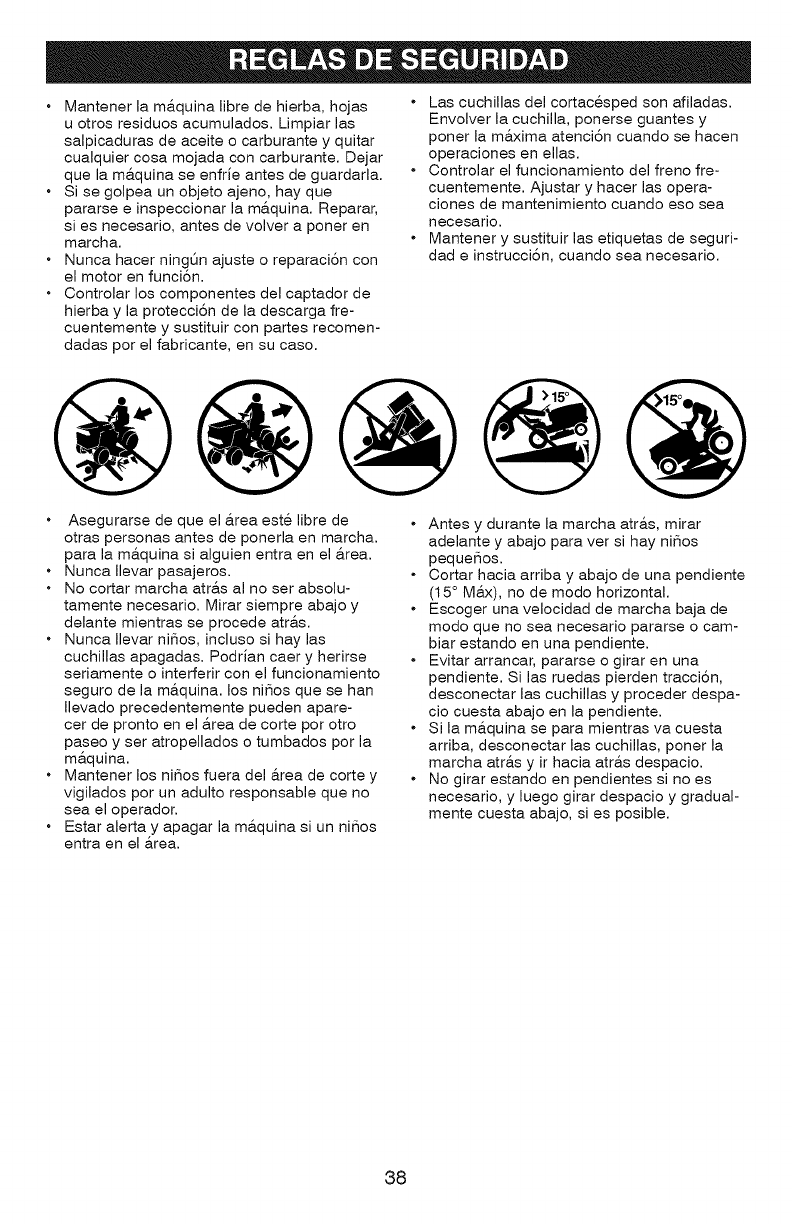
• Mantener la m&quina libre de hierba, hojas
u otros residuos acumulados. Limpiar las
salpicaduras de aceite o carburante y quitar
cualquier cosa mojada con carburante. Dejar
que la m&quina se enfrie antes de guardarla.
• Si se golpea un objeto ajeno, hay que
pararse einspeccionar la m&quina. Reparar,
si es necesario, antes de volver a poner en
marcha.
• Nunca hacer ningt_n ajuste o reparaci6n con
el motor en funci6n.
• Controlar los componentes del captador de
hierba y la protecci6n de la descarga fie-
cuentemente y sustituir con partes recomen-
dadas por el fabricante, en su caso.
Las cuchillas del cortacesped son afiladas.
Envolver la cuchilla, ponerse guantes y
poner la m&xima atenci6n cuando se hacen
operaciones en elias.
Controlar el funcionamiento del freno fre-
cuentemente. Ajustar y hacer las opera-
ciones de mantenimiento cuando eso sea
necesario.
Mantener y sustituir las etiquetas de seguri-
dad e instrucci6n, cuando sea necesario.
@@@@@
• Asegurarse de que el &rea este libre de
otras personas antes de ponerla en marcha.
para la m&quina si alguien entra en el &tea.
• Nunca Ilevar pasajeros.
• No cortar marcha atr&s al no ser absolu-
tamente necesario. Mirar siempre abajo y
delante mientras se procede atr&s.
• Nunca Ilevar nifios, incluso si hay las
cuchillas apagadas. Podrian caer y herirse
seriamente o interferir con el funcionamiento
seguro de la m&quina, los nifios que se han
Ilevado precedentemente pueden apare-
cer de pronto en el &rea de corte por otro
paseo y ser atropellados o tumbados por la
m&quina.
• Mantener los nifios fuera del a.rea de corte y
vigilados por un adulto responsable que no
sea el operador.
• Estar alerta y apagar la m&quina si un nifios
entra en el &tea.
o
o
Antes y durante la marcha atr&s, mirar
adelante y abajo para ver si hay nifios
pequefios.
Cortar hacia arriba y abajo de una pendiente
(15° M&x), no de modo horizontal.
Escoger una velocidad de marcha baja de
modo que no sea necesario pararse o cam-
biar estando en una pendiente.
Evitar arrancar, pararse o girar en una
pendiente. Si las ruedas pierden tracci6n,
desconectar las cuchillas y proceder despa-
cio cuesta abajo en la pendiente.
Si la m&quina se para mientras va cuesta
arriba, desconectar las cuchillas, poner la
marcha atra.s y ir hacia atr&s despacio.
No girar estando en pendientes si no es
necesario, y luego girar despacio y gradual-
mente cuesta abajo, si es posible.
38
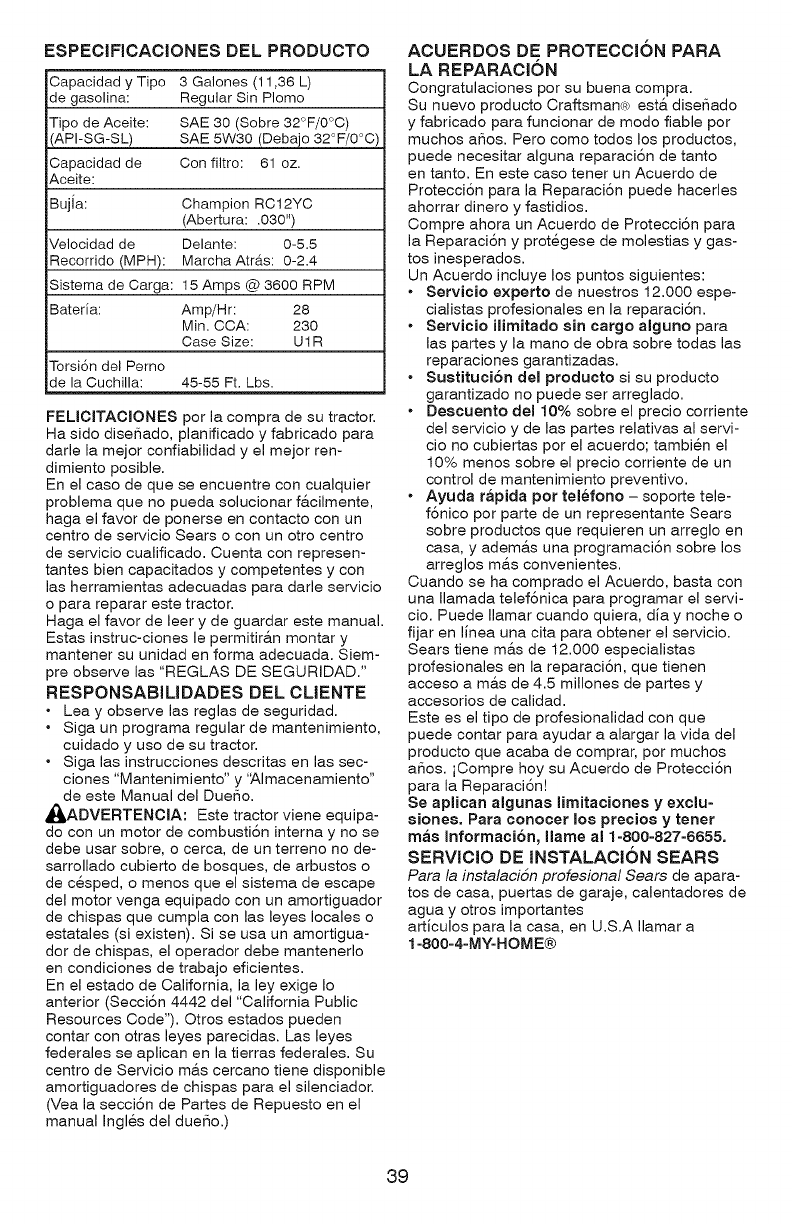
ESPECIRCACIONES DEL PRODUCTO
Capacidad y Tipo 3 Galones (11,36 L)
de gasolina: Regular Sin Plomo
Tipo de Aceite: SAE 30 (Sobre 32°F/0°C)
(API-SG-SL) SAE 5W30 (Debajo 32°F/0°C)
Capacidad de Coo filtro: 61 oz.
Aceite:
Bujia: Champion RC12YC
(Abertura: .030")
Velocidad de Delante: 0-5.5
Recorrido (MPH): Marcha Atrb, s: 0-2.4
Sistema de Carga: 15 Amps @ 3600 RPM
Bateria: Amp/Hr: 28
Min. CCA: 230
Case Size: U1R
Torsi6n del Perno
de la Cuchilla: 45-55 Ft. Lbs.
FELICITAOIONES por la compra de su tractor.
Ha sido diseSado, planificado y fabricado para
darle la mejor confiabilidad y el mejor ren-
dimiento posible.
En el caso de que se encuentre con cualquier
problema que no pueda solucionar f&cilmente,
haga el favor de ponerse en contacto con un
centro de servicio Sears o con un otro centro
de servicio cualificado. Cuenta con represen-
tantes bien capacitados y competentes y con
las herramientas adecuadas para darle servicio
o para reparar este tractor.
Haga el favor de leer y de guardar este manual.
Estas instruc-ciones le permitir&n montar y
mantener su unidad en forma adecuada. Siem-
pre observe las "REGLAS DE SEGURIDAD."
RESPONSABIMDADES DEL CMENTE
•Lea y observe las reglas de seguridad.
• Siga un programa regular de mantenimiento,
cuidado y uso de su tractor.
• Siga las instrucciones descritas en las sec-
clones "Mantenimiento" y 'Almacenamiento"
de este Manual del DueSo.
_DVERTENCIA: Este tractor viene equipa-
do con un motor de combusti6n interna y no se
debe usar sobre, o cerca, de un terreno no de-
sarrollado cubierto de bosques, de arbustos o
de cesped, o menos que el sistema de escape
del motor venga equipado con un amortiguador
de chispas que cumpla con las leyes locales o
estatales (si existen). Si se usa un amortigua-
dor de chispas, el operador debe mantenerlo
en condiciones de trabajo eficientes.
En el estado de California, la ley exige Io
anterior (Secci6n 4442 del "California Public
Resources Code"). Otros estados pueden
contar con otras leyes parecidas. Las leyes
federales se aplican en la tierras federales. Su
centro de Servicio m&s cercano tiene disponible
amortiguadores de chispas para el silenciador.
(Vea la secci6n de Partes de Repuesto en el
manual Ingles del dueSo.)
ACUERDOS DE PROTECCI(!)N PARA
LA REPARACION
Congratulaciones por su buena compra.
Su nuevo producto Craftsman(_> esta diseSado
y fabricado para funcionar de modo fiable por
muchos aSos. Pero como todos los productos,
puede necesitar alguna reparaci6n de tanto
en tanto. En este caso tener un Acuerdo de
Protecci6n para la Reparaci6n puede hacerles
ahorrar dinero y fastidios.
Compre ahora un Acuerdo de Protecci6n para
la Reparaci6n y protegese de molestias y gas-
tos inesperados.
Un Acuerdo incluye los puntos siguientes:
• Servicio experto de nuestros 12.000 espe-
cialistas profesionales en la reparaci6n.
•Servicio ilirnitado sin cargo alguno para
las partes y la mano de obra sobre todas las
reparaciones garantizadas.
• Suetituci6n del producto si su producto
garantizado no puede ser arreglado.
•Deecuento del 10% sobre el precio corriente
del servicio y de las partes relativas al servi-
cio no cubiertas por el acuerdo; tambien el
10% menos sobre el precio corriente de un
control de mantenimiento preventivo.
•Ayuda rapida pot telefono - soporte tele-
f6nico por parte de un representante Sears
sobre productos que requieren un arreglo en
casa, y adem&s una programaci6n sobre los
arreglos mas convenientes.
Cuando se ha comprado el Acuerdo, basta con
una Ilamada telef6nica para programar el servi-
cio. Puede Ilamar cuando quiera, dia y noche o
fijar en linea una cita para obtener el servicio.
Sears tiene m&s de 12.000 especialistas
profesionales en la reparaci6n, que tienen
acceso a ma.s de 4.5 millones de partes y
accesorios de calidad.
Este es el tipo de profesionalidad con que
puede contar para ayudar a alargar la vida del
producto que acaba de comprar, por muchos
aSos. iCompre hoy su Acuerdo de Protecci6n
para la Reparaci6n!
Se aplican algunas limitaciones y exclu-
siones. Para conocer Ice precioe y tenet
mac Inforrnaci6n, Ilame al 1-800-827=6655.
SERVlClO DE INSTALACI6N SEARS
Para la instalaciSn profesional Sears de apara-
tos de casa, puertas de garaje, calentadores de
agua y otros importantes
articulos para la casa, en U.S.A Ilamar a
1-800-4-MY-HOME®
39
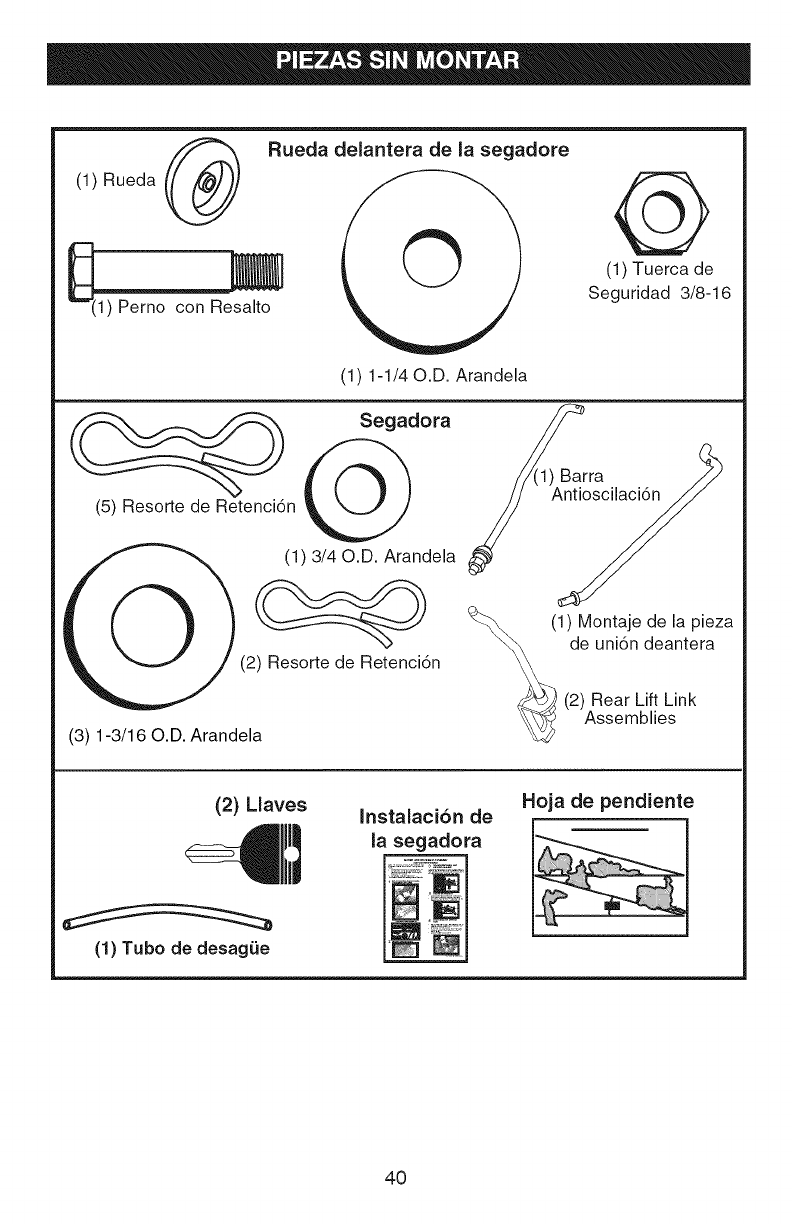
(1) Rueda (_
Rueda delantera de la segadore
(1) 1-1/40.D. Arandela
Q
(1) Tuerca de
Seguridad 3/8-16
(5) Resorte de Retenci6n
Segadora
(1) 3/40.D. Arandela
(2) Resorte de Retenci6n
(3) 1-3/16 O.D. Arandela
1) Barra
Antioscilaci6n
(1) Montaje de la pieza
de uni6n deantera
(2) Rear Lift Link
Assemblies
(2) Llaves
(1) Tubo de desagi_e
Instalaci6n de
la segadora
Hoja de pendiente
40
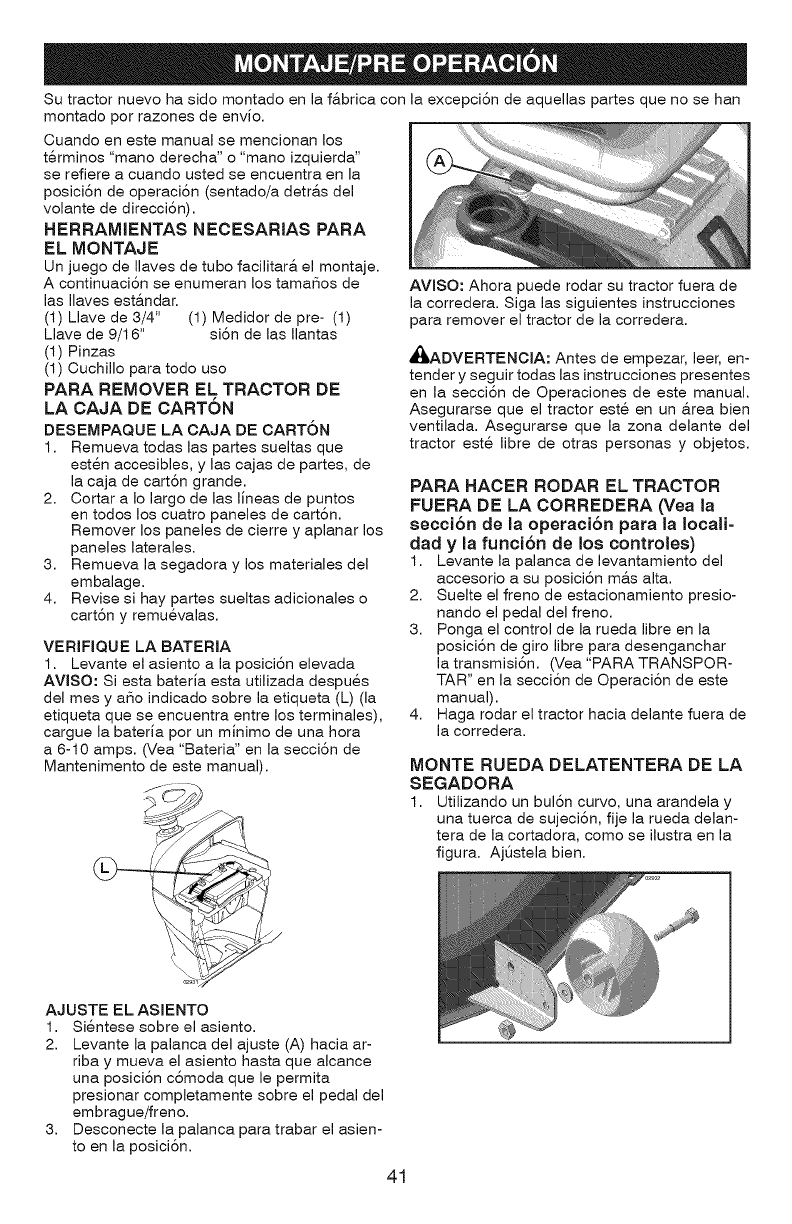
Su tractor nuevo ha sido montado en la f&brica con la excepci6n de aquellas partes que no se han
montado por razones de envio.
Cuando en este manual se mencionan los
t@minos "mano derecha" o "mano izquierda"
se refiere a cuando usted se encuentra en la
posici6n de operaci6n (sentado/a detr&s del
volante de direcci6n).
HERRAMIENTAS NECESARIAS PARA
EL MONTAJE
Un juego de Ilaves de tubo facilitara el montaje.
A continuaci6n se enumeran los tamafios de
las Ilaves est_.ndar.
(1) Llave de 3/4" (1) Medidor de pre- (1)
Llave de 9/16" si6n de las Ilantas
(1) Pinzas
(1) Cuchillo para todo uso
PARA REMOVER EL TRACTOR DE
LA CAJA DE CARTON
DESEMPAQUE LA CAJA DE CARTON
1. Remueva todas las partes sueltas que
esten accesibles, y las cajas de partes, de
la caja de cart6n grande.
2. Cortar a Io largo de las lineas de puntos
en todos los cuatro paneles de cart6n.
Remover los paneles de cierre y aplanar los
paneles laterales.
3. Remueva la segadora y los materiales del
embalage.
4. Revise si hay partes sueltas adicionales o
cart6n y remuevalas.
VERIFIQUE LA BATERIA
1. Levante el asiento a la posici6n elevada
AVlSO: Siesta bateria esta utilizada despues
del rues y afio indicado sobre la etiqueta (L) (la
etiqueta que se encuentra entre los terminales),
cargue la bateria por un minimo de una hora
a 6-10 amps. (Vea "Bateria" en la secci6n de
Mantenimento de este manual).
/
AVISO: Ahora puede rodar su tractor fuera de
la corredera. Siga las siguientes instrucciones
para remover el tractor de la corredera.
,_ADVERTENCiA: Antes de empezar, leer, en-
tender y seguir todas las instrucciones presentes
en la secci6n de Operaciones de este manual.
Asegurarse que el tractor este en un a.rea bien
ventilada. Asegurarse que la zona delante del
tractor este libre de otras personas y objetos.
PARA HACER RODAR EL TRACTOR
FUERA DE LA CORREDERA (Vea la
seccJ6n de la operaci6n para la Iocali-
dad y la funci6n de los controles)
1. Levante la palanca de levantamiento del
accesorio a su posici6n m&s alta.
2. Suelte el freno de estacionamiento presio-
nando el pedal del freno.
3. Ponga el control de la rueda libre en la
posici6n de giro libre para desenganchar
la transmisi6n. (Vea "PARA TRANSPOR-
TAR" en la secci6n de Operaci6n de este
manual).
4. Haga rodar el tractor hacia delante fuera de
la corredera.
MONTE RUEDA DELATENTERA DE LA
SEGADORA
1. Utilizando un bul6n curvo, una arandela y
una tuerca de sujeci6n, fije la rueda delan-
tera de la cortadora, como se ilustra en la
figura. AjQstela bien.
AJUSTE EL ASIENTO
1. Sientese sobre el asiento.
2. Levante la palanca del ajuste (A) hacia ar-
riba y mueva el asiento hasta que alcance
una posici6n c6moda que le permita
presionar completamente sobre el pedal del
embrague/freno.
3. Desconecte la palanca para trabar el asien-
to en la posici6n.
41
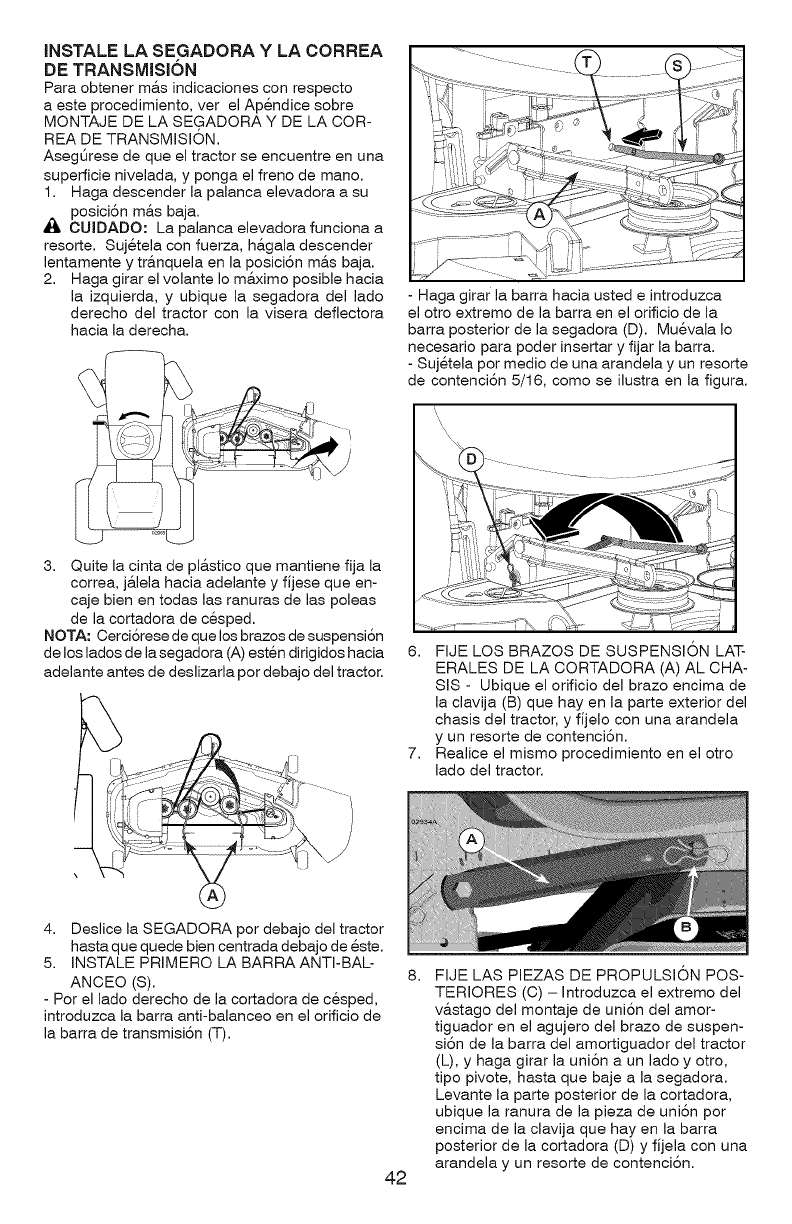
JNSTALE LA SEGADORA YLA CORREA
DE TRANSMISJON
Para obtener m&s indicaciones con respecto
aeste procedimiento, ver el Apendice sobre
MONTAJE DE LA SE,GADORA Y DE LA COR-
REA DE TRANSMISION.
AsegQrese de que el tractor se encuentre en una
superficie nivelada, y ponga el freno de mano.
1. Haga descender la palanca elevadora a su
posici6n m&s baja.
_, CUiDADO: La palanca elevadora funciona a
resorte. Sujetela con fuerza, h&gala descender
lentamente y tr&nquela en la posici6n m&s baja.
2. Haga girar el volante Io m&ximo posible hacia
la izquierda, y ubique la segadora del lado
derecho del tractor con la visera deflectora
hacia la derecha.
- Haga girar la barra hacia usted e introduzca
el otro extremo de la barra en el orificio de la
barra posterior de la segadora (D). Muevala Io
necesario para poder insertar y fijar la barra.
- Suj@ela por medio de una arandela y un resorte
de contenci6n 5/16, como se ilustra en la figura.
\\I
3. Quite la cinta de pl&stico que mantiene fija la
correa, ja.lela hacia adelante y fijese que en-
caje bien en todas las ranuras de las poleas
de la cortadora de c6sped.
NOTA: Cerci6rese de que los brazos de suspensi6n
de los lados de la segadora (A) est6n dirigidos hacia
adelante antes de deslizarla por debajo del tractor.
6. FIJE LOS BRAZOS DE SUSPENSION LAT-
ERALES DE LA CORTADORA (A) AL CHA-
SIS - Ubique el orificio del brazo encima de
la clavija (B) que hay en la parte exterior del
chasis del tractor, y fijelo con una arandela
y un resorte de contenci6n.
7. Realice el mismo procedimiento en el otro
lado del tractor.
4. Deslice la SEGADORA por debajo del tractor
hasta que quede bien centrada debajo de este.
5. INSTALE PRIMERO LA BARRAANTI-BAL-
ANCEO (S).
- Por el lado derecho de la cortadora de cesped,
introduzca la barra anti-balanceo en el orificio de
la barra de transmisi6n (T).
8,
42
FIJE LAS PIEZAS DE PROPULSION POS-
TERIORES (C) - Introduzca el extremo del
v&stago del montaje de uni6n del amor-
ti.g,uador en el agujero del brazo de suspen-
sion de la barra del amortiguador del tractor
(L), y haga girar la uni6n a un lado y otro,
tipo pivote, hasta que baje a la segadora.
Levante la parte posterior de la cortadora,
ubique la ranura de la pieza de uni6n por
encima de la clavija que hay en la barra
posterior de la cortadora (D) y fijela con una
arandela y un resorte de contenci6n.
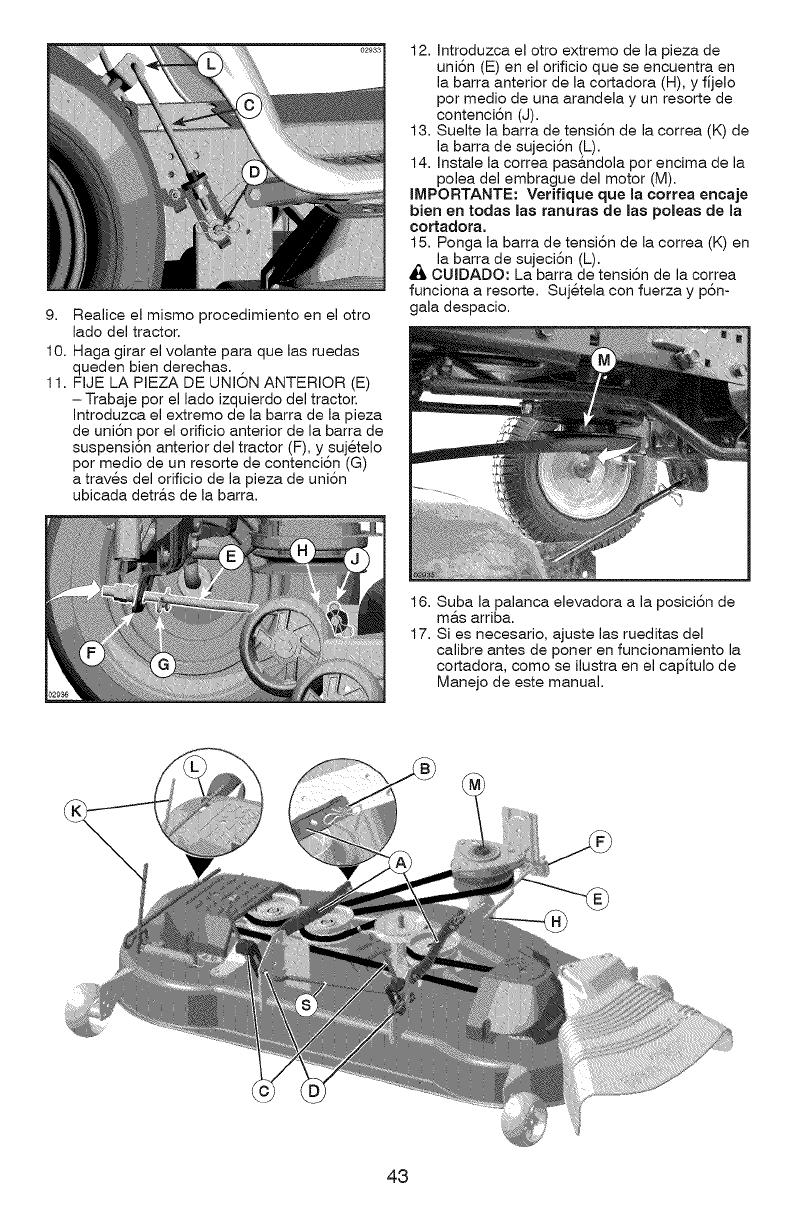
9. Realiceelmismoprocedimientoenelotro
ladodeltractor.
10.Hagagirarel volante para que las ruedas
queden bien derechas.
11. FIJE LA PIEZA DE UNION ANTERIOR (E)
-Trabaje por el lado izquierdo del tractor.
Introduzca el extremo de la barra de la pieza
de uni6n por el orificio anterior de la barra de
suspensi6n anterior del tractor (F), y suj@elo
por medio de un resorte de contenci6n (G)
a traves del orificio de la pieza de uni6n
ubicada detr&s de la barra.
12. Introduzca el otro extremo de la pieza de
uni6n (E) en el orificio que se encuentra en
la barra anterior de la cortadora (H), y fJjelo
por medio de una arandela y un resorte de
contenci6n (J).
13. Suelte la barra de tensi6n de la correa (K) de
la barra de sujeci6n (L).
14. Instale la correa pas&ndola por encima de la
polea del embrague del motor (M).
IMPORTANTE: Verifique que la correa encaje
bJen en todas Jas ranuras de Jas poJeas de Ja
cortadora,
15. Ponga la barra de tensi6n de la correa (K) en
la barra de sujeci6n (L).
OUJDADO: La barra de tensi6n de la correa
funciona a resorte. Suj@ela con fuerza y p6n-
gala despacio.
16. Suba la palanca elevadora a la posici6n de
mas arriba.
17. Si es necesario, ajuste las rueditas del
calibre antes de poner en funcionamiento la
cortadora, como se ilustra en el capitulo de
Manejo de este manual.
43
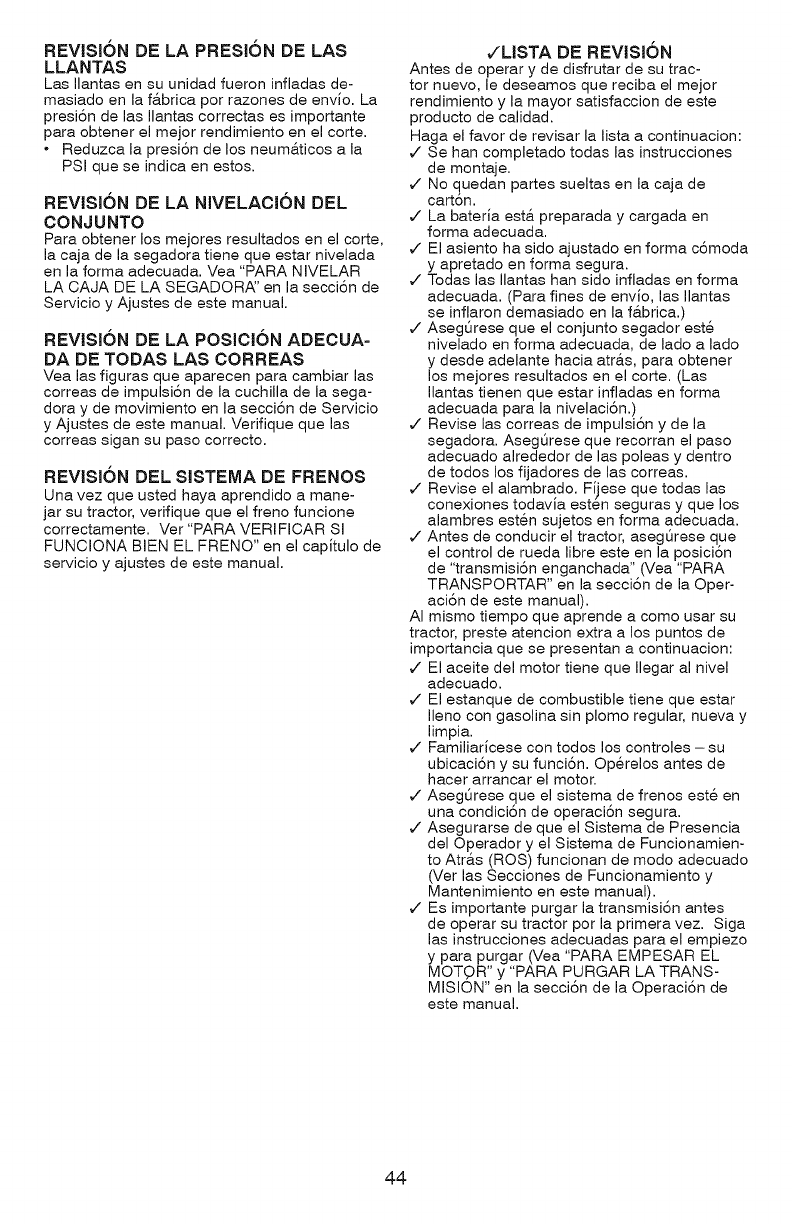
REVISI6N DE LA PRESION DE LAS
LLANTAS
Las Ilantas en su unidad fueron infladas de-
masiado en la f&brica por razones de envio. La
presiSn de las Ilantas correctas es importante
para obtener el mejor rendimiento en el corte.
• Reduzca la presiSn de los neum&ticos a la
PSi que se indica en estos.
REVISION DE LA NIVELACION DEL
CONJUNTO
Para obtener los mejores resultados en el corte,
la caja de la segadora tiene que estar nivelada
en la forma adecuada. Vea "PARA NIVELAR
LA CAJA DE LA SEGADOR_' en la secci6n de
Servicio y Ajustes de este manual.
REVISION DE LA POSICION ADECUA=
DA DE TODAS LAS CORREAS
Yea las figuras que aparecen para cambiar las
correas de impulsiSn de la cuchilla de la sega-
dora y de movimiento en la secciSn de Servicio
y Ajustes de este manual. Verifique que las
correas sigan su paso correcto.
REVISION DEL SISTEMA DE FRENOS
Una vez que usted haya aprendido a mane-
jar su tractor, verifique que el freno funcione
correctamente. Ver "PARA VERIFICAR SI
FUNCIONA BIEN EL FRENO" en el capitulo de
servicio y ajustes de este manual.
¢'LISTA DE REVISI6N
Antes de operar y de disfrutar de su trac-
tor nuevo, le deseamos que reciba el mejor
rendimiento y la mayor satisfaccion de este
producto de calidad.
Haga el favor de revisar la lista a continuacion:
/Se han completado todas las instrucciones
de montaje.
,/ No quedan partes sueltas en la caja de
cartSn.
/La bateria esta. preparada y cargada en
forma adecuada.
/El asiento ha sido ajustado en forma cSmoda
y apretado en forma segura.
/Todas las Ilantas han sido infladas en forma
adecuada. (Para fines de envio, las Ilantas
se inflaron demasiado en la fa.brica.)
/Asegt_rese que el conjunto segador este
nivelado en forma adecuada, de lado a lado
y desde adelante hacia atr&s, para obtener
los mejores resultados en el corte. (Las
Ilantas tienen que estar infladas en forma
adecuada para la nivelaciSn.)
/Revise las correas de impulsiSn y de la
segadora. AsegQrese que recorran el paso
adecuado alrededor de las poleas y dentro
de todos los fijadores de las correas.
/Revise el alambrado. Fijese que todas las
conexiones todavia esten seguras y que los
alambres esten sujetos en forma adecuada.
/Antes de conducir el tractor, asegQrese que
el control de rueda libre este en la posiciSn
de "transmisiSn enganchada" (Vea "PARA
TRANSPORTAR" en la secciSn de la Oper-
aciSn de este manual).
AI mismo tiempo que aprende a como usar su
tractor, preste atencion extra a los puntos de
importancia que se presentan a continuacion:
J El aceite del motor tiene que Ilegar al nivel
adecuado.
J El estanque de combustible tiene que estar
Ileno con gasolina sin plomo regular, nueva y
limpia.
J Familiaricese con todos los controles - su
ubicaci6n y su funci6n. Operelos antes de
hacer arrancar el motor.
,/AsegQrese que el sistema de frenos este en
una condici6n de operaci6n segura.
,/Asegurarse de que el Sistema de Presencia
del Operador y el Sistema de Funcionamien-
to Atr&s (ROS) funcionan de modo adecuado
(Ver las Secciones de Funcionamiento y
Mantenimiento en este manual).
,/ Es importante purgar la transmisi6n antes
de operar su tractor por la primera vez. Siga
las instrucciones adecuadas para el empiezo
y para purgar (Vea "PARA EMPESAR EL
MOT(_R" y "PARA PURGAR LA TRANS-
MISION" en la secci6n de la Operaci6n de
este manual.
44
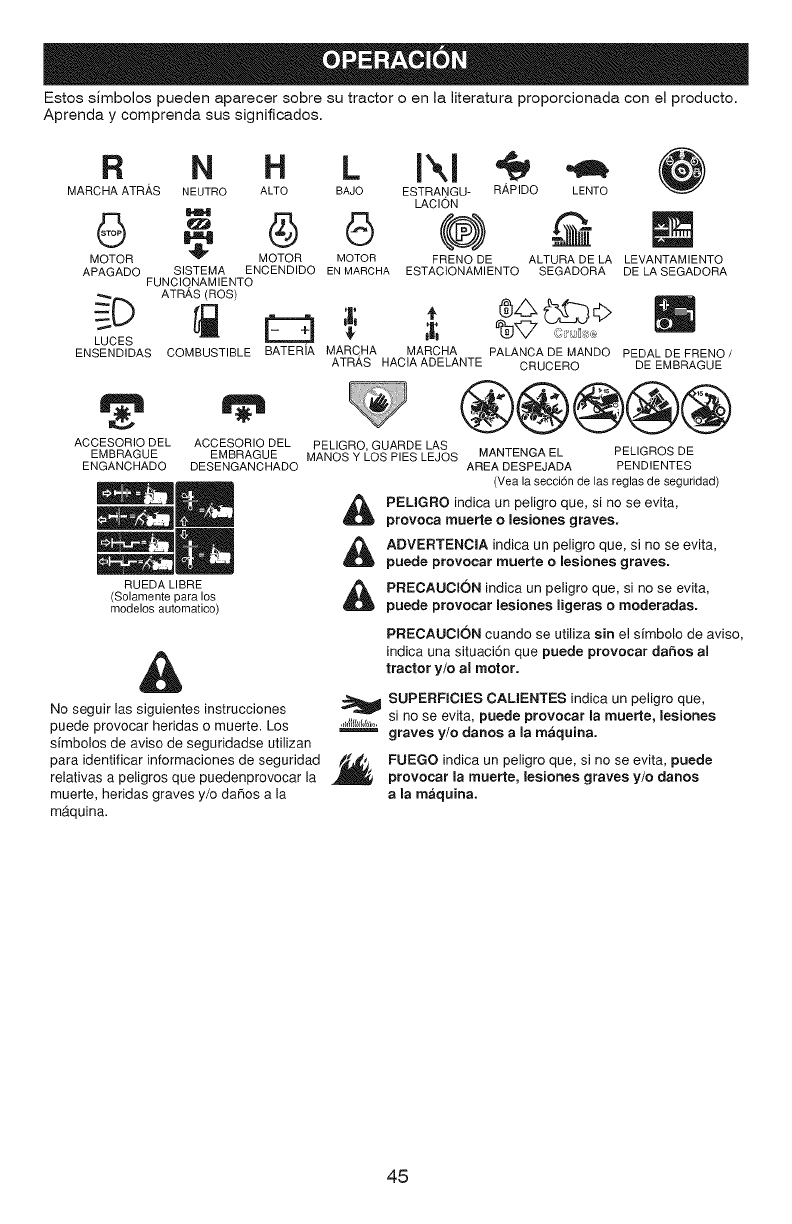
Estos simbolos pueden aparecer sobre su tractor o en la literatura proporcionada con el producto.
Aprenda y comprenda sus significados.
R N H L
MARCHA ATRAS NEUTRO ALTO BAJO
MOTOR _ MOTOR
APAGADO SISTEMA ENCENDIDO
FUNCIONAMIENTO
ATRAS (ROS)
LUCES
ENSENDIDAS COMBUSTIBLE
G
MOTOR
EN MARCHA
;I;
BATERIA MARCHA
ACCESORIO DEL ACCESORIO DEL
EMBRAGUE EMBRAGUE
ENGANCHADO DESENGANCHADO
RUEDA LIBRE
(Solamente para los
modelos automatico)
&
No seguir las siguientes instrucciones
puede provocar heridas o muerte. Los .,_,ll_,_,,_____
simbolos de aviso de seguridadse utilizan
para identificar informaciones de seguridad _
relativas a peligros que puedenprovocar la
muerte, heridas graves y/o daSos a la
maquina.
ESTRANGU- R/_PIDO LENTO
LACION
(@)
FRENO DE ALTURA DE LA LEVANTAMIENTO
ESTACIONAMIENTO SEGADORA DE LA SEGADORA
MARC.APALA,CAOEMA,OOPEOALOEPRE,O,
ATRAS HACIA ADELANTE CRUCERO DE EMBRAGUE
®@®@@
PELIGRO,GUARDE LAS
MANOS Y LOS PIES LEJOS MANTENGA EL PELIGROS DE
AREA DESPEJADA PENDIENTES
(Vea la secci6n de las reglas de seguridad)
PEUGRO indica un peligro que, si no se evita,
provoca muerte olesiones graves.
ADVERTENClA indica un peligro que, si no se evita,
puede provocar muerte o lesiones graves.
PRECAUClON indica un peligro que, si no se evita,
puede provocar lesiones ligeras o moderadas.
PRECAUCl0N cuando se utiliza sin el simbolo de aviso,
indica una situaci6n que puede provocar dahos al
tractor y/o al motor.
SUPERFICIES CAUENTES indica un peligro que,
si no se evita, puede provocar la muerte, lesiones
graves y/o danos a la maquina.
FUEGO indica un peligro que, si no se evita, puede
provocar la muerte, lesiones graves y/o danos
a la maquina.
45
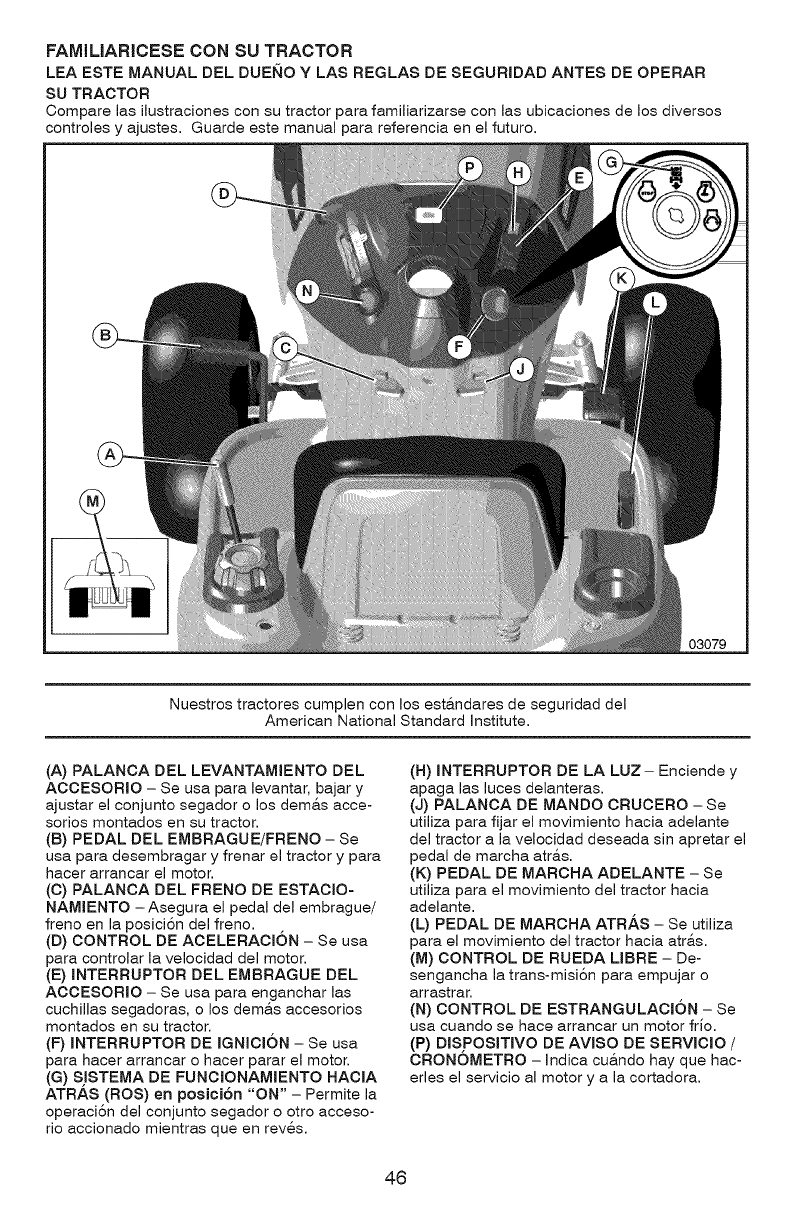
FAMIMARICESE CON SU TRACTOR
LEA ESTE MANUAL DEL DUEI_IO Y LAS REGLAS DE SEGURIDAD ANTES DE OPERAR
SU TRACTOR
Compare las ilustraciones con su tractor para familiarizarse con las ubicaciones de los diversos
controles y ajustes. Guarde este manual para referencia en el futuro.
Nuestros tractores cumplen con los esta.ndares de seguridad del
American National Standard institute.
(A) PALANCA DEL LEVANTAMIENTO DEL
ACOESORaO - Se usa para levantar, bajar y
ajustar el conjunto segador o los dem&s acce-
sorios montados en su tractor.
(B) PEDAL DEL EMBRAGUE/FRENO - Se
usa para desembragar y frenar el tractor y para
hacer arrancar el motor.
(C) PALANCA DEL FRENO DE ESTACIO-
NAMIENTO -Asegura el pedal del embrague/
freno en la posici6n del freno.
(D) CONTROL DE ACELERACION - Se usa
para controlar la velocidad del motor.
(E) INTERRUPTOR DEL EMBRAGUE DEL
ACCESORaO - Se usa para enganchar las
cuchillas segadoras, o los dem&s accesorios
montados en su tractor.
(F) INTERRUPTOR DE IGNICION - Se usa
para hacer arrancar o hacer parar el motor.
(G) S,ISTEMA DE FUNCIONAMIENTO HACIA
ATRAS (ROS) en posici6n "ON" - Permite la
operaci6n del conjunto segador o otro acceso-
rio accionado mientras queen reves.
(H) INTERRUPTOR DE LA LUZ - Enciende y
apaga las luces delanteras.
(J) PALANCA DE MANDO CRUCERO - Se
utiliza para fijar el movimiento hacia adelante
del tractor a la velocidad deseada sin apretar el
pedal de marcha atr&s.
(K) PEDAL DE MARCHA ADELANTE - Se
utiliza para el movimiento del tractor hacia
adelante.
(L) PEDAL DE MARCHA ATR,_S - Se utiliza
para el movimiento del tractor hacia atr&s.
(M) CONTROL DE RUEDA LIBRE - De-
sengancha la trans-misi6n para empujar o
arrastrar.
(N) CONTROL DE ESTRANGULACION - Se
usa cuando se hace arrancar un motor frio.
(P) DIS,POSITIVO DE AVISO DE SERVICIO /
CRONOMETRO - Indica cu&ndo hay que hac-
erles el servicio al motor y a la cortadora.
46
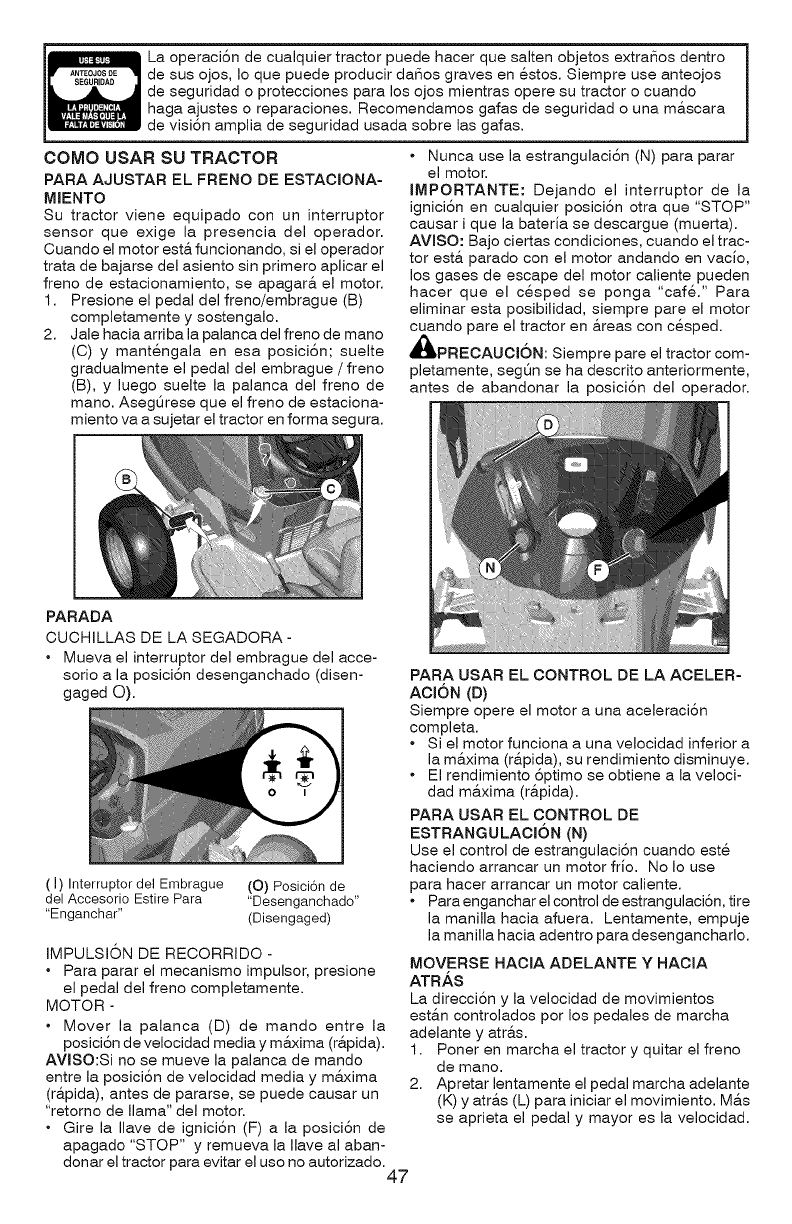
La operaci6n de cualquier tractor puede hacer que salten objetos extraSos dentro
de sus ojos, Io que puede producir daSos graves en estos. Siempre use anteojos
de seguridad o protecciones para los ojos mientras opere su tractor o cuando
haga ajustes o reparaciones. Recomendamos gafas de seguridad o una m&scara
de visi6n amplia de seguridad usada sobre las gafas.
COMO USAR SU TRACTOR
PARA AJUSTAR EL FRENO DE ESTACIONA-
MIENTO
Su tractor viene equipado con un interruptor
sensor que exige la presencia del operador.
Cuando el motor est& funcionando, si el operador
trata de bajarse del asiento sin primero aplicar el
freno de estacionamiento, se apagara, el motor.
1. Presione el pedal del freno/embrague (B)
completamente y sostengalo.
2. Jale hacia arriba la palanca del freno de mano
(C) y mantengala en esa posici6n; suelte
gradualmente el pedal del embrague / freno
(B), y luego suelte la palanca del freno de
mano. Asegt_rese que el freno de estaciona-
miento va a sujetar el tractor en forma segura.
• Nunca use la estrangulaci6n (N) para parar
el motor.
IMPORTANTE: Dejando el interruptor de la
ignici6n en cualquier posici6n otra que "STOP"
causar i que la bateria se descargue (muerta).
AVlSO: Bajo ciertas condiciones, cuando el trac-
tor est& parado con el motor andando en vacio,
los gases de escape del motor caliente pueden
hacer que el cesped se ponga "cafe." Para
eliminar esta posibilidad, siempre pare el motor
cuando pare el tractor en &reas con cesped.
PRECAUCI6N: Siempre pare el tractor com-
pletamente, segQn se ha descrito anteriormente,
antes de abandonar la posici6n del operador.
PARADA
CUCHILLAS DE LA SEGADORA-
• Mueva el interruptor del embrague del acce-
sorio a la posici6n desenganchado (disen-
gaged O).
(I) interrupter del Embrague (0) Posici6n de
del Accesorio Estire Para "Desenganchado"
"Enganchar" (Disengaged)
IMPULSI6N DE RECORRIDO -
• Para parar el mecanismo impulsor, presione
el pedal del freno completamente.
MOTOR -
• Mover la palanca (D) de mando entre la
posici6n de velocidad media y m&xima (ra.pida).
AVJSO:Si no se mueve la palanca de mando
entre la posici6n de velocidad media y m&xima
(r&pida), antes de pararse, se puede causar un
"retorno de llama" del motor.
• Gire la Ilave de ignici6n (F) a la posici6n de
apagado "STOP" y remueva la Ilave al aban-
donar el tractor para evitar el uso no autorizado. 47
PARA USAR EL CONTROL DE LA ACELER-
ACI6N (D)
Siempre opere el motor a una aceleraci6n
completa.
• Si el motor funciona a una velocidad inferior a
la m&xima (r&pida), su rendimiento disminuye.
• El rendimiento 6ptimo se obtiene a la veloci-
dad m&xima (r&pida).
PARA USAR EL CONTROL DE
ESTRANGULACI6N (N)
Use el control de estrangulaci6n cuando este
haciendo arrancar un motor frio. No Io use
para hacer arrancar un motor caliente.
• Para enganchar el control de estrangulaci6n, tire
la manilla hacia afuera. Lentamente, empuje
la manilla hacia adentro para desengancharlo.
MOVERSE HACIA ADELANTE Y HACIA
ATRAS
La direcci6n y la velocidad de movimientos
est&n controlados por los pedales de marcha
adelante y atr&s.
1. Poner en marcha el tractor y quitar el freno
de mano.
2. Apretar lentamente el pedal marcha adelante
(K) y atr&s (L) para iniciar el movimiento. Ma.s
se aprieta el pedal y mayor es la velocidad.
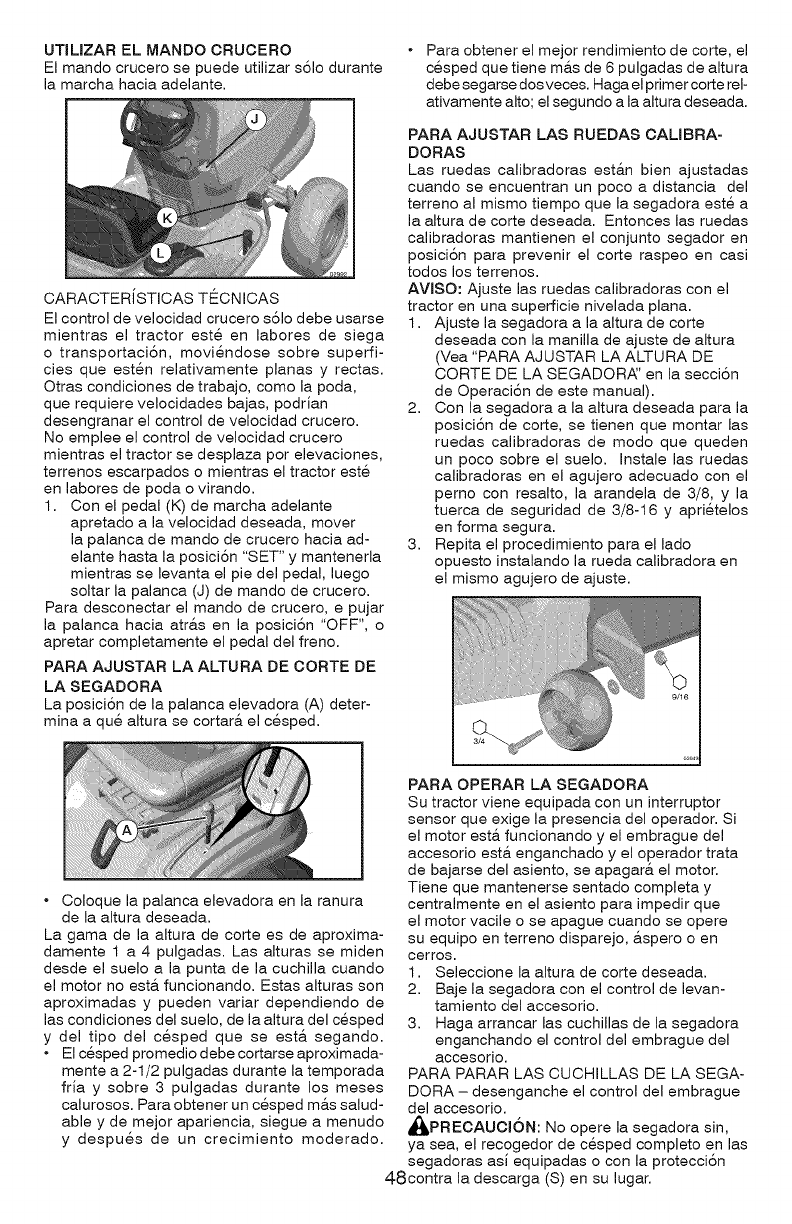
UTILIZARELMANDOCRUCERO
Elmandocrucerosepuedeutilizars61odurante
lamarchahaciaadelante.
CARACTER(STICASTECNICAS
Elcontroldevelocidadcruceros61odebeusarse
mientrasel tractor este en labores de siega
o transportaci6n, moviendose sobre superfi-
cies que esten relativamente planas y rectas.
Otras condiciones de trabajo, como la poda,
que requiere velocidades bajas, podrian
desengranar el control de velocidad crucero.
No emplee el control de velocidad crucero
mientras el tractor se desplaza por elevaciones,
terrenos escarpados o mientras el tractor este
en labores de poda o virando.
1. Con el pedal (K) de marcha adelante
apretado a la velocidad deseada, mover
la palanca de mando de crucero hacia ad-
elante hasta la posici6n "SET" y mantenerla
mientras se levanta el pie del pedal, luego
soltar la palanca (J) de mando de crucero.
Para desconectar el mando de crucero, epujar
la palanca hacia atr&s en la posici6n "OFF", o
apretar completamente el pedal del freno.
PARA AJUSTAR LA ALTURA DE CORTE DE
LA SEGADORA
La posici6n de la palanca elevadora (A) deter-
mina a que altura se cortar& el cesped.
Para obtener el mejor rendimiento de corte, el
cesped que tiene ma.sde 6 pulgadas de altura
debe segarse dos veces. Haga el primer corte rel-
ativamente alto; el segundo a la altura deseada.
PARA AJUSTAR LAS RUEDAS CAUBRA-
DORAS
Las ruedas calibradoras est&n bien ajustadas
cuando se encuentran un poco a distancia del
terreno al mismo tiempo que la segadora este a
la altura de corte deseada. Entonces las ruedas
calibradoras mantienen el conjunto segador en
posici6n para prevenir el corte raspeo en casi
todos los terrenos.
AVlSO: Ajuste las ruedas calibradoras con el
tractor en una superficie nivelada plana.
1. Ajuste la segadora a la altura de corte
deseada con la manilla de ajuste de altura
(Vea "PARA AJUSTAR LA ALTURA DE
CORTE DE LA SEGADORA_' en la secci6n
de Operaci6n de este manual).
2. Con la segadora a la altura deseada para la
posici6n de corte, se tienen que montar las
ruedas calibradoras de modo que queden
un poco sobre el suelo. Instale las ruedas
calibradoras en el agujero adecuado con el
perno con resalto, la arandela de 3/8, y la
tuerca de seguridad de 3/8-16 y aprietelos
en forma segura.
3. Repita el procedimiento para el lado
opuesto instalando la rueda calibradora en
el mismo agujero de ajuste.
• Coloque la palanca elevadora en la ranura
de la altura deseada.
La gama de la altura de cortees de aproxima-
damente 1 a 4 pulgadas. Las alturas se miden
desde el suelo a la punta de la cuchilla cuando
el motor no est& funcionando. Estas alturas son
aproximadas y pueden variar dependiendo de
las condiciones del suelo, de la altura del cesped
y del tipo del c6sped que se est& segando.
• El cesped promedio debe cortarse aproximada-
mente a 2-1/2 pulgadas durante la temporada
fria y sobre 3 pulgadas durante los meses
calurosos. Para obtener un cesped m&s salud-
able y de mejor apariencia, siegue a menudo
y despues de un crecimiento moderado.
PARA OPERAR LA SEGADORA
Su tractor viene equipada con un interruptor
sensor que exige la presencia del operador. Si
el motor est& funcionando y el embrague del
accesorio est& enganchado yel operador trata
de bajarse del asiento, se apagar_, el motor.
Tiene que mantenerse sentado completa y
centralmente en el asiento para impedir que
el motor vacile o se apague cuando se opere
su equipo en terreno disparejo, &spero o en
cerros.
1. Seleccione la altura de corte deseada.
2. Baje la segadora con el control de levan-
tamiento del accesorio.
3. Haga arrancar las cuchillas de la segadora
enganchando el control del embrague del
accesorio.
PARA PARAR LAS CUCHILLAS DE LA SEGA-
DORA - desenganche el control del embrague
del accesorio.
_,PREOAUCJ6N: No opere la segadora sin,
ya sea, el recogedor de c6sped completo en las
segadoras asi equipadas o con la protecci6n
48contra la descarga (S) en su lugar.
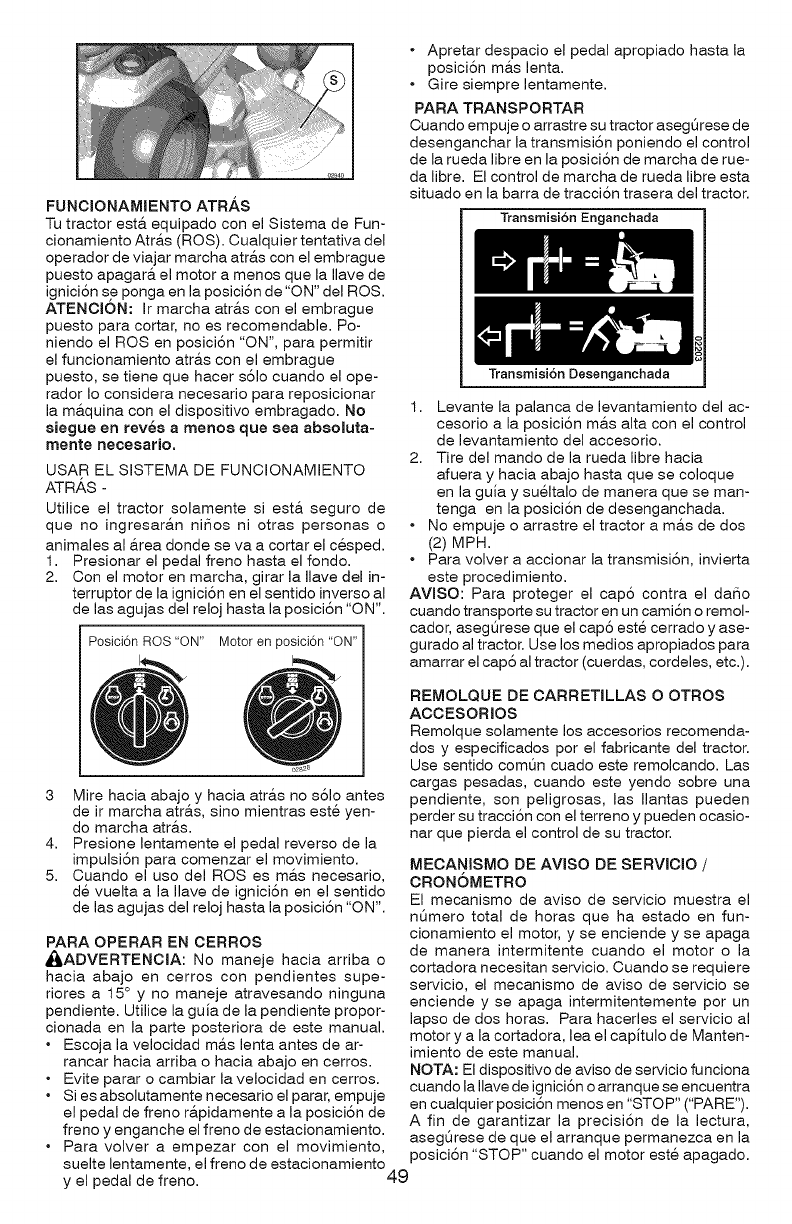
FUNCIONAMIENTOATRAS
Tutractorest& equipado con el Sistema de Fun-
cionamiento Atr&s (ROS). Cualquier tentativa del
operador de viajar marcha atra.s con el embrague
puesto apagara, el motor a menos que la Ilave de
ignici6n seponga en la posici6n de "ON" del ROS.
ATENCION: Jr marcha atr&s con el embrague
puesto para cortar, no es recomendable. Po-
niendo el ROS en posici6n "ON", para permitir
el funcionamiento atr&s con el embrague
puesto, se tiene que hacer s61o cuando el ope-
rador Io considera necesario para reposicionar
la m&quina con el dispositivo embragado. No
siegue en rev6s amenos que sea absoJuta-
mente necesario.
USAR EL SISTEMA DE FUNCiONAMIENTO
ATR_,S -
Utilice el tractor solamente si est& seguro de
que no ingresar&n niSos ni otras personas o
animales al &rea donde se va a cortar el cesped.
1. Presionar el pedal freno hasta el fondo.
2. Con el motor en marcha, girar la llave del in-
terruptor de la ignici6n en el sentido inverso al
de las agujas del reloj hasta la posici6n "ON".
Posici6n ROS "ON" Motor en posici6n "ON"
3 Mire hacia abajo y hacia atr&s no s61o antes
de ir marcha atr&s, sino mientras este yen-
do marcha atr&s.
4. Presione lentamente el pedal reverso de la
impulsi6n para comenzar el movimiento.
5. Cuando el uso del ROSes ma.s necesario,
de vuelta a la Ilave de ignici6n en el sentido
de las agujas del reloj hasta la posici6n "ON".
PARA OPERAR EN CERROS
A(_ADVERTENCIA: No maneje hacia arriba o
hacia abajo en cerros con pendientes supe-
riores a I5 ° y no maneje atravesando ninguna
pendiente. Utilice la guia de la pendiente propor-
cionada en la parte posteriora de este manual.
•Escoja la velocidad m&s lenta antes de ar-
rancar hacia arriba o hacia abajo en cerros.
• Evite parar o cambiar la velocidad en cerros.
•Si es absolutamente necesario el parar, empuje
el pedal de freno r&pidamente a la posici6n de
freno y enganche el freno de estacionamiento.
• Para volver a empezar con el movimiento,
suelte lentamente, el freno de estacionamiento
y el pedal de freno.
•Apretar despacio el pedal apropiado hasta la
posici6n m&s lenta.
•Gire siempre lentamente.
PARA TRANSPORTAR
Cuando empuje o arrastre su tractor asegQrese de
desenganchar la transmisi6n poniendo el control
de la rueda libre en la posici6n de marcha de rue-
da libre. El control de marcha de rueda libre esta
situado en la barra de tracci6n trasera del tractor.
Transmisi6n Enganchada
Transmisi6n Desenganchada
1. Levante la palanca de levantamiento del ac-
cesorio a la posici6n m&s alta con el control
de levantamiento del accesorio.
2. Tire del mando de la rueda libre hacia
afuera y hacia abajo hasta que se coloque
en la guia y sueltalo de manera que se man-
tenga en la posici6n de desenganchada.
• No empuje o arrastre el tractor a m&s de dos
(2) MPH.
•Para volver a accionar la transmisi6n, invierta
este procedimiento.
AVlSO: Para proteger el cap6 contra el daSo
cuando transporte su tractor en un cami6n o remol-
cador, asegQrese que el cap6 este cerrado y ase-
gurado al tractor. Use los medios apropiados para
amarrar el cap6 al tractor (cuerdas, cordeles, etc.).
REMOLQUE DE CARRETILLAS O OTROS
ACCESORIOS
Remolque solamente los accesorios recomenda-
dos y especificados por el fabricante del tractor.
Use sentido comQn cuado este remolcando. Las
cargas pesadas, cuando este yendo sobre una
pendiente, son peligrosas, las Ilantas pueden
perder su tracci6n con el terreno y pueden ocasio-
nar que pierda el control de su tractor.
MEOANISMO DE AVlSO DE SERVI¢IO /
CRONOMETRO
El mecanismo de aviso de servicio muestra el
nOmero total de horas que ha estado en fun-
cionamiento el motor, y se enciende y se apaga
de manera intermitente cuando el motor o la
cortadora necesitan servicio. Cuando se requiere
servicio, el mecanismo de aviso de servicio se
enciende y se apaga intermitentemente por un
lapso de dos horas. Para hacerles el servicio al
motor y a la cortadora, lea el capitulo de Manten-
imiento de este manual.
NOTA: El dispositivo de aviso de servicio funciona
cuando la Ilave de ignici6n o arranque se encuentra
en cualquier posici6n menos en "STOP" ("PARE").
A fin de garantizar la precisi6n de la lectura,
asegOrese de que el arranque permanezca en la
posici6n "STOP" cuando el motor este apagado.
49
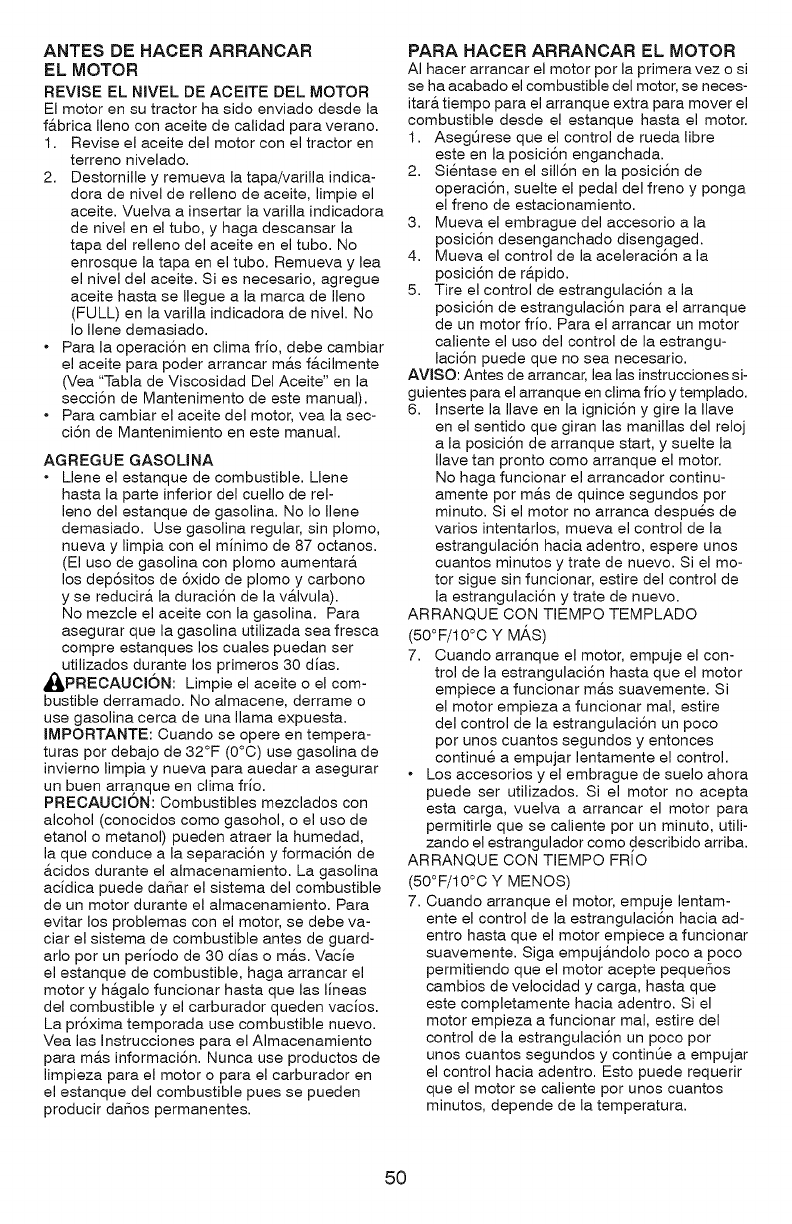
ANTES DE HACER ARRANCAR
EL MOTOR
REVISE EL NIVEL DE ACEITE DEL MOTOR
El motor en su tractor ha sido enviado desde la
f&brica Ileno con aceite de calidad para verano.
1. Revise el aceite del motor con el tractor en
terreno nivelado.
2. Destornille y remueva la tapa/varilla indica-
dora de nivel de relleno de aceite, limpie el
aceite. Vuelva a insertar la varilla indicadora
de nivel en el tubo, y haga descansar la
tapa del relleno del aceite en el tubo. No
enrosque la tapa en el tubo. Remueva y lea
el nivel del aceite. Si es necesario, agregue
aceite hasta se Ilegue a la marca de Ileno
(FULL) en la varilla indicadora de nivel. No
Io Ilene demasiado.
• Para la operaci6n en clima frio, debe cambiar
el aceite para poder arrancar m&s f&cilmente
(Vea "Tabla de Viscosidad Del Aceite" en la
secci6n de Mantenimento de este manual).
• Para cambiar el aceite del motor, yea la sec-
ci6n de Mantenimiento en este manual.
AGREGUE GASOLiNA
•Llene el estanque de combustible. Llene
hasta la parte inferior del cuello de rel-
leno del estanque de gasolina. No Io Ilene
demasiado. Use gasolina regular, sin plomo,
nueva y limpia con el mJnimo de 87 octanos.
(El uso de gasolina con plomo aumentara.
los dep6sitos de 6xido de plomo y carbono
y se reducir& la duraci6n de la v&lvula).
No mezcle el aceite con la gasolina. Para
asegurar que la gasolina utilizada sea fresca
compre estanques los cuales puedan ser
utilizados durante los primeros 30 dJas.
_,PREOAUOI6N: Limpie el aceite o el com-
bustible derramado. No almacene, derrame o
use gasolina cerca de una llama expuesta.
IMPORTANTE: Cuando se opere en tempera-
turas por debajo de 32°F (0°C) use gasolina de
invierno limpia y nueva para auedar a asegurar
un buen arra,nque en clima frJo.
PRECAUCION: Combustibles mezclados con
alcohol (conocidos como gasohol, o el uso de
etanol o metanol) pueden atraer la humedad,
la que conduce a la separaci6n y formaci6n de
&cidos durante el almacenamiento. La gasolina
acJdica puede daSar el sistema del combustible
de un motor durante el almacenamiento. Para
evitar los problemas con el motor, se debe va-
ciar el sistema de combustible antes de guard-
ado por un perJodo de 30 dJas o m&s. VacJe
el estanque de combustible, haga arrancar el
motor y h&galo funcionar hasta que las IJneas
del combustible y el carburador queden vacJos.
La pr6xima temporada use combustible nuevo.
Yea las Instrucciones para el Almacenamiento
para m&s informaci6n. Nunca use productos de
limpieza para el motor o para el carburador en
el estanque del combustible pues se pueden
producir daSos permanentes.
PARA HACER ARRANCAR EL MOTOR
AI hacer arrancar el motor por la primera vez o si
se ha acabado el combustible del motor, se neces-
itar& tiempo para el arranque extra para mover el
combustible desde el estanque hasta el motor.
1. Aseg0rese que el control de rueda libre
este en la posici6n enganchada.
2. Sientase en el sill6n en la posici6n de
operaci6n, suelte el pedal del freno y ponga
el freno de estacionamiento.
3. Mueva el embrague del accesorio a la
posici6n desenganchado disengaged.
4. Mueva el control de la aceleraci6n a la
posici6n de r&pido.
5. Tire el control de estrangulaci6n ala
posici6n de estrangulaci6n para el arranque
de un motor frJo. Para el arrancar un motor
caliente el uso del control de la estrangu-
laci6n puede que no sea necesario.
AVISO: Antes de arrancar, lea las instrucciones si-
guientes para el arranque en clima frio y templado.
6. Inserte la Ilave en la ignici6n y gire la Ilave
en el sentido que giran las manillas del reloj
a la posici6n de arranque start, y suelte la
Ilave tan pronto como arranque el motor.
No haga funcionar el arrancador continu-
amente por m&s de quince segundos por
minuto. Si el motor no arranca despues de
varios intentados, mueva el control de la
estrangulaci6n hacia adentro, espere unos
cuantos minutos y trate de nuevo. Si el mo-
tor sigue sin funcionar, estire del control de
la estrangulaci6n y trate de nuevo.
ARRANQUE CON TJEMPO TEMPLADO
(50°F/10°C Y M_,S)
7. Cuando arranque el motor, empuje el con-
trol de la estrangulaci6n hasta que el motor
empiece a funcionar ma.s suavemente. Si
el motor empieza a funcionar mal, estire
del control de la estrangulaci6n un poco
por unos cuantos segundos y entonces
continue a empujar lentamente el control.
•Los accesorios y el embrague de suelo ahora
puede ser utilizados. Si el motor no acepta
esta carga, vuelva a arrancar el motor para
permitirle que se caliente por un minuto, utili-
zando el estrangulador como ,describido arriba.
ARRANQUE CON TIEMPO FRIO
(50°F/10°C Y MENOS)
7. Cuando arranque el motor, empuje lentam-
ente el control de la estrangulaci6n hacia ad-
entro hasta que el motor empiece a funcionar
suavemente. Siga empuj&ndolo poco a poco
permitiendo que el motor acepte pequeSos
cambios de velocidad y carga, hasta que
este completamente hacia adentro. Si el
motor empieza a funcionar mal, estire del
control de la estrangulaci6n un poco por
unos cuantos segundos y contin0e a empujar
el control hacia adentro. Esto puede requerir
que el motor se caliente por unos cuantos
minutos, depende de la temperatura.
5O
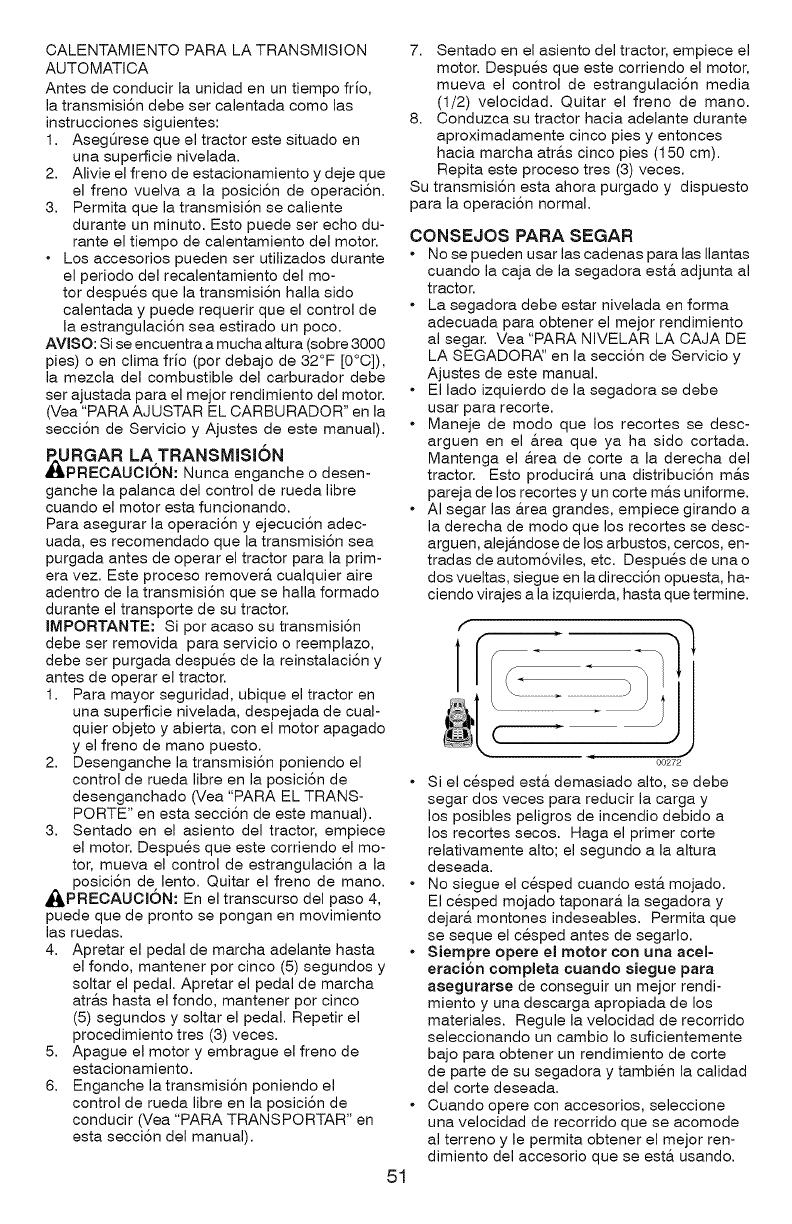
CALENTAMIENTO PARA LA TRANSMISION
AUTOMATICA
Antes de conducir la unidad en un tiempo frio,
la transmisi6n debe ser calentada como las
instrucciones siguientes:
1. AsegQrese que el tractor este situado en
una superficie nivelada.
2. Alivie el freno de estacionamiento y deje que
el freno vuelva a la posici6n de operaci6n.
3. Permita que la transmisi6n se caliente
durante un minuto. Esto puede ser echo du-
rante el tiempo de calentamiento del motor.
• Los accesorios pueden ser utilizados durante
el periodo del recalentamiento del mo-
tor despues que la transmisi6n halla sido
calentada y puede requerir que el control de
la estrangulaci6n sea estirado un poco.
AVISO: Sise encuentra a mucha altura (sobre 3000
pies) o en clima frio (por debajo de 32°F [0°C]),
la mezcla del combustible del carburador debe
ser ajustada para el mejor rendimiento del motor.
(Vea "PARA AJUSTAR EL CARBURADOR" en la
secci6n de Servicio y Ajustes de este manual).
RGAR LA TRANSMISJON
PRECAUCI6N: Nunca enganche o desen-
ganche la palanca del control de rueda libre
cuando el motor esta funcionando.
Para asegurar la operaci6n y ejecuci6n adec-
uada, es recomendado que la transmisi6n sea
purgada antes de operar el tractor para la prim-
era vez. Este proceso remover& cualquier aire
adentro de la transmisi6n que se halla formado
durante el transporte de su tractor.
IMPORTANTE: Si por acaso su transmisi6n
debe ser removida para servicio o reemplazo,
debe ser purgada despues de la reinstalaci6n y
antes de operar el tractor.
1. Para mayor seguridad, ubique el tractor en
una superficie nivelada, despejada de cual-
quier objeto y abierta, con el motor apagado
y el freno de mano puesto.
2. Desenganche la transmisi6n poniendo el
control de rueda libre en la posici6n de
desenganchado (Vea "PARA EL TRANS-
PORTE" en esta secci6n de este manual).
3. Sentado en el asiento del tractor, empiece
el motor. Despues que este corriendo el mo-
tor, mueva el control de estrangulaci6n a la
posici6n de lento. Quitar el freno de mano.
_PREOAUOi6N: En el transcurso del paso 4,
puede que de pronto se pongan en movimiento
las ruedas.
4. Apretar el pedal de marcha adelante hasta
el fondo, mantener por cinco (5) segundos y
soltar el pedal. Apretar el pedal de marcha
atr&s hasta el fondo, mantener por cinco
(5) segundos y soltar el pedal. Repetir el
procedimiento tres (3) veces.
5. Apague el motor y embrague el freno de
estacionamiento.
6. Enganche latransmisi6n poniendo el
control de rueda libre en la posici6n de
conducir (Vea "PARA TRANSPORTAR" en
esta secci6n del manual).
7. Sentado en el asiento del tractor, empiece el
motor. Despues que este corriendo el motor,
mueva el control de estrangulaci6n media
(1/2) velocidad. Quitar el freno de mano.
8. Conduzca su tractor hacia adelante durante
aproximadamente cinco pies y entonces
hacia marcha atr&s cinco pies (150 cm).
Repita este proceso tres (3) veces.
Su transmisi6n esta ahora purgado y dispuesto
para la operaci6n normal.
51
CONSEJOS PARA SEGAR
•No se pueden usar las cadenas para las Ilantas
cuando la caja de la segadora est& adjunta al
tractor.
•La segadora debe estar nivelada en forma
adecuada para obtener el mejor rendimiento
al segar. Vea "PARA NIVELAR LA CAJA DE
LA SEGADOR_' en la secci6n de Servicio y
Ajustes de este manual.
•El lado izquierdo de la segadora se debe
usar para recorte.
•Maneje de modo que los recortes se desc-
arguen en el &rea que ya ha sido cortada.
Mantenga el &rea de corte a la derecha del
tractor. Esto producir& una distribuci6n m&s
pareja de los recortes y un corte m&s uniforme.
• AI segar las &rea grandes, empiece girando a
la derecha de modo que los recortes se desc-
arguen, alej&ndose de los arbustos, cercos, en-
tradas de autom6viles, etc. Despues de una o
dos vueltas, siegue en la direcci6n opuesta, ha-
ciendo virajes a la izquierda, hasta que termine.
(
00272
• Si el cesped esta. demasiado alto, se debe
segar dos veces para reducir la carga y
los posibles peligros de incendio debido a
los recortes secos. Haga el primer corte
relativamente alto; el segundo a la altura
deseada.
• No siegue el cesped cuando esta mojado.
El cesped mojado taponara la segadora y
dejara, montones indeseables. Permita que
se seque el cesped antes de segarlo.
•Siempre opere eJ motor con una acel-
eraclon completa cuando siegue para
asegurarse de conseguir un mejor rendi-
miento y una descarga apropiada de los
materiales. Regule la velocidad de recorrido
seleccionando un cambio Io suficientemente
bajo para obtener un rendimiento de corte
de parte de su segadora y tambien la calidad
del corte deseada.
• Cuando opere con accesorios, seleccione
una velocidad de recorrido que se acomode
al terreno y le permita obtener el mejor ren-
dimiento del accesorio que se est& usando.
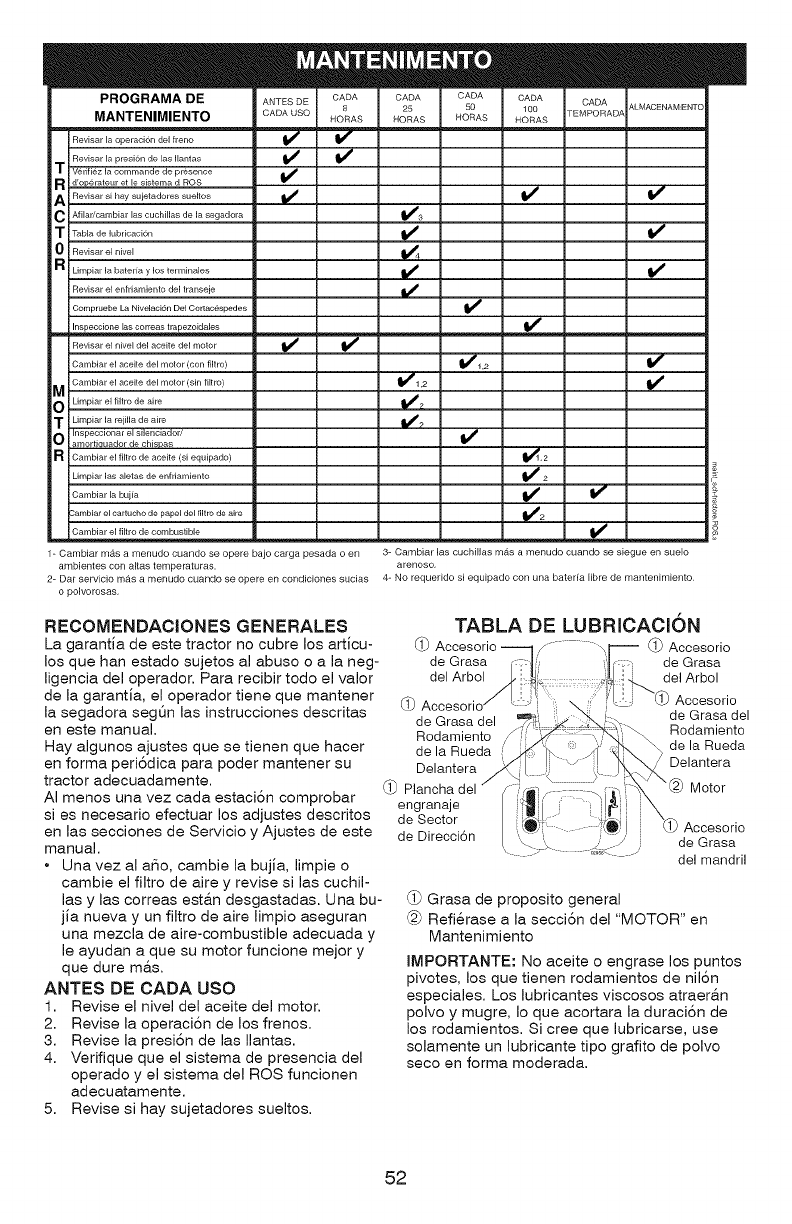
PROGRAMADE
MANTENIMIENTO
Revisar la operaci6n del freno _ V
Revisar la presJ6n de las Ilantas
TVerifi6z la commande de pr6sence _1_
Rd'operateur et le sistema d ROS
ARev_ars_haysuietaa....... _to_ If _
CAfilar/cambiar las cuchillas de la segadora V#3
TTabla de lubdcaci6n _
0 Revisar el nivel _4,
RLimpiar la bateria y los terminales _
Revisar el enfriamiento del transeje
Compruebe La Niveiaci6n Del Cortacespedes
-- Inspeccione las correas trapezoidaies
Revisar el nivel del aceite del motor _
Cambiar el aceile del motor (con filtro) _1,2
Cambiar el aceile del motor (sin filtro) _'1,2 _
M
O Limpiar el filtro de aire _#lf?
TLimpiar la rejilla de aire _?
hspeccionar el silenciador/
O amortJquador de chispas
RCambiar el filtro de aceite (si equipado) tllll_,2
Limpiar las aletas de enfriamiento _ 2
Cambiar la buiia _
Cambiar el cartucho de papel del lilt ro de aire _2
-- Cambiarelfiltrodecombustibl_ -- -- -- _ --
1- Cambiar mas a menudo cuando se opere bajo carga pesada o en 3- Cambiar las cuchillas mas a menudo cuando se siegue en suelo
ambientes con altas ternperaturas, arenoso,
2- Dar servicio mas a menudo cuando se opere en condiciones sucias 4- No requerido si equipado con una bateria libre de mantenimiento,
o polvorosas,
RECOMENDACIONES GENERALES
La garantia de este tractor no cubre los articu-
los que han estado sujetos al abuse o a la neg-
ligencia del operador. Para recibir todo el valor
de la garantia, el operador tiene que mantener
la segadora segOn las instrucciones descritas
en este manual.
Hay algunos ajustes que se tienen que hacer
en forma peri6dica para poder mantener su
tractor adecuadamente.
AI menos una vez cada estaci6n comprobar
si es necesario efectuar los adjustes descritos
en las secciones de Servicio y Ajustes de este
manual.
•Una vez al a_o, cambie la bujia, limpie o
cambie el filtro de aire y revise si las cuchil-
las y las correas est&n desgastadas. Una bu-
jia nueva y un filtro de aire limpio aseguran
una mezcla de aire-combustible adecuada y
le ayudan a que su motor funcione mejor y
que dure mas.
ANTES DE CADA USO
1. Revise el nivel del aceite del motor.
2. Revise la operaci6n de los frenos.
3. Revise la presi6n de las Ilantas.
4. Verifique que el sistema de presencia del
operado y el sistema del ROS funcionen
adecuatamente.
5. Revise si hay sujetadores sueltos.
TABLA DE LUBRICACI6N
(_) Accesorio- -- (_) Accesorio
de Grasa de Grasa
del Arbol del Arbol
(_) Accesorio
de Grasa del de Grasa del
Rodamiento Rodamiento
de la Ruedade la Rueda ) Delantera
Delantera
(_) Plancha del Motor
engranaje
de Sector
de Direcci6n ) Accesorio
de Grasa
del mandril
(_) Grasa de proposito general
@ Refi@ase a la secci6n del "MOTOR" en
Mantenimiento
IMPORTANTE: No aceite o engrase los puntos
pivotes, los que tienen rodamientos de nil6n
especiales. Los lubricantes viscosos atraera.n
polvo y mugre, Io que acortara la duraci6n de
los rodamientos. Si cree que lubricarse, use
solamente un lubricante tipo grafito de polvo
seco en forma moderada.
52
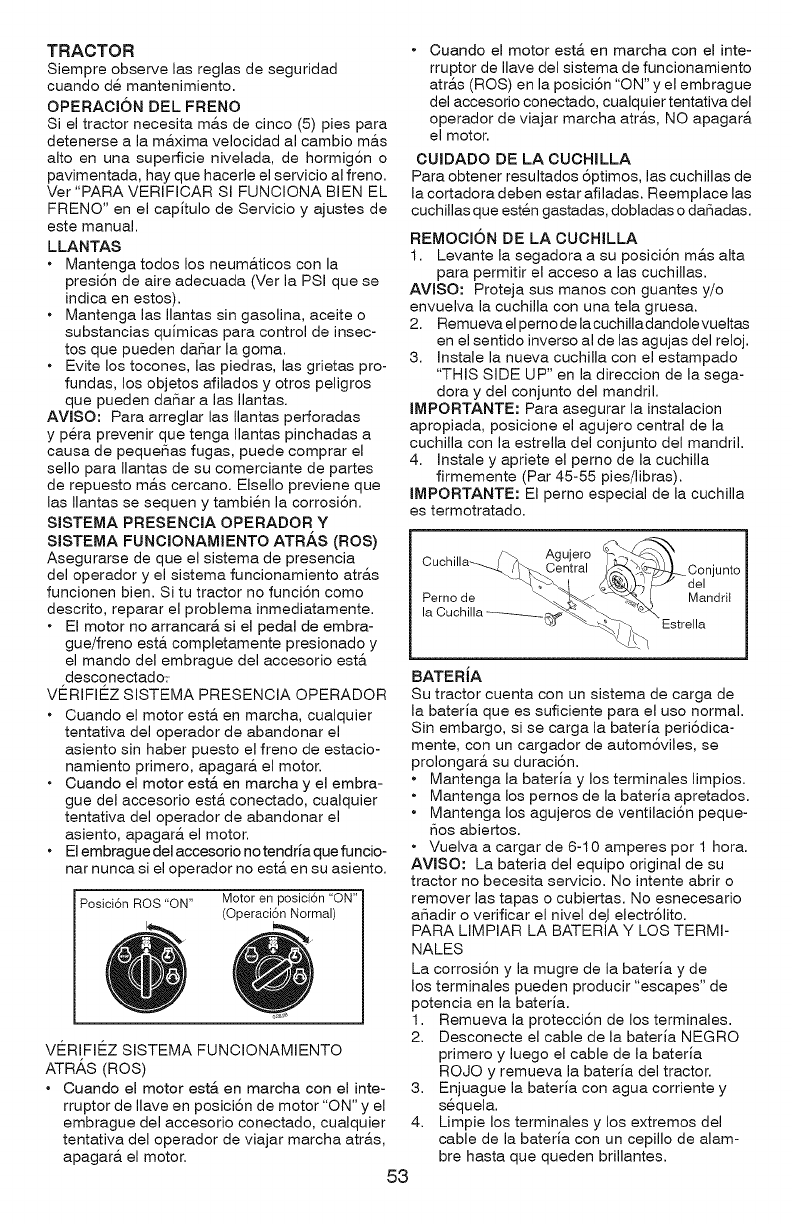
TRACTOR
Siempre observe las reglas de seguridad
cuando de mantenimiento.
OPERAOION DEL FRENO
Si el tractor necesita m&s de cinco (5) pies para
detenerse a la m&xima velocidad al cambio mas
alto en una superficie nivelada, de hormig6n o
pavimentada, hay que hacerle el servicio al freno.
Ver "PARA VERIFICAR SI FUNCIONA BIEN EL
FRENO" en el capitulo de Servicio y ajustes de
este manual.
LLANTAS
• Mantenga todos los neumaticos con la
presi6n de aire adecuada (Ver la PSI que se
indica en estos).
• Mantenga las Ilantas sin gasolina, aceite o
substancias quimicas para control de insec-
tos que pueden da_ar la goma.
• Evite los tocones, las piedras, las grietas pro-
fundas, los objetos afilados y otros peligros
que pueden da_ar alas Ilantas.
AVlSO: Para arreglar las Ilantas perforadas
y pera prevenir que tenga Ilantas pinchadas a
causa de peque_as fugas, puede comprar el
sello para Ilantas de su comerciante de partes
de repuesto ma.s cercano. Elsello previene que
las Ilantas se sequen y tambien la corrosi6n.
SISTEMA PRESENOIA OPERADOR Y
SISTEMA FUNOIONAMIENTO ATR.&S (ROS)
Asegurarse de que el sistema de presencia
del operador y el sistema funcionamiento atras
funcionen bien. Si tu tractor no funci6n como
descrito, reparar el problema inmediatamente.
• El motor no arrancar& si el pedal de embra-
gue/freno esta completamente presionado y
el mando del embrague del accesorio esta
desconectado;-
VF_RIFII_Z SISTEMA PRESENCIA OPERADOR
• Cuando el motor est& en marcha, cualquier
tentativa del operador de abandonar el
asiento sin haber puesto el freno de estacio-
namiento primero, apagara el motor.
• Cuando el motor est& en marcha y el embra-
gue del accesorio esta conectado, cualquier
tentativa del operador de abandonar el
asiento, apagara el motor.
• Elembrague del accesorio no tendria que fundo-
nat nunca si el operador no esta en su asiento.
Posici6n ROS "ON" Motor en posici6n "ON"
(Operaci6n Normal)
VE_RIFIE_ZSISTEMA FUNCiONAMIENTO
ATR_,S (ROS)
•Cuando el motor estA en marcha con el inte-
rruptor de Ilave en posici6n de motor "ON" y el
embrague del accesorio conectado, cualquier
tentativa del operador de viajar marcha atr&s,
apagar& el motor. 53
•Cuando el motor est& en marcha con el inte-
rruptor de Ilave del sistema de funcionamiento
atr&s (ROS) en la posici6n "ON" y el embrague
del accesorio conectado, cualquier tentativa del
operador de viajar marcha atr&s, NO apagar&
el motor.
CUIDADO DE LA CUCHILLA
Para obtener resultados 6ptimos, las cuchillas de
la cortadora deben estar afiladas. Reemplace las
cuchillas que esten gastadas, dobladas o daSadas.
REMOOION DE LA CUOHILLA
1. Levante la segadora a su posici6n m&s alta
para permitir el acceso alas cuchillas.
AVlSO: Proteja sus manos con guantes y/o
envuelva la cuchilla con una tela gruesa.
2. Remueva el perno de la cuchilla dandole vueltas
en el sentido inverso al de las agujas del reloj.
3. Instale la nueva cuchilla con el estampado
"THIS SIDE UP" en la direccion de la sega-
dora y del conjunto del mandril.
IMPORTANTE: Para asegurar la instalacion
apropiada, posicione el agujero central de la
cuchilla con la estrella del conjunto del mandril.
4. Instale y apriete el perno de la cuchilla
firmemente (Par 45-55 pies/libras).
IMPORTANTE: El perno especial de la cuchilla
es termotratado.
Cuchilla_. Agujero
Perno de Mandril
la Cuchilla _-___ Estrella
BATERiA
Su tractor cuenta con un sistema de carga de
la bateria que es suficiente para el uso normal.
Sin embargo, si se carga la bateria peri6dica-
mente, con un cargador de autom6viles, se
prolongar& su duraci6n.
• Mantenga la bateria y los terminales limpios.
• Mantenga los pernos de la bateria apretados.
• Mantenga los agujeros de ventilaci6n peque-
_os abiertos.
• Vuelva a cargar de 6-10 amperes por 1 hora.
AVlSO: La bateria del equipo original de su
tractor no becesita servicio. No intente abrir o
remover las tapas o cubiertas. No esnecesario
a_adir o verificar el nivel deJ electr61ito.
PARA LIMPIAR LA BATERIA Y LOS TERMF
NALES
La corrosi6n y la mugre de la bateria y de
los terminales pueden producir "escapes" de
potencia en la bateria.
1. Remueva la protecci6n de los terminales.
2. Desconecte el cable de la bateria NEGRO
primero y luego el cable de la bateria
ROJO y remueva la bateria del tractor.
3. Enjuague la bateria con agua corriente y
sequela.
4. Limpie los terminales y los extremos del
cable de la bateria con un cepillo de alam-
bre hasta que queden brillantes.
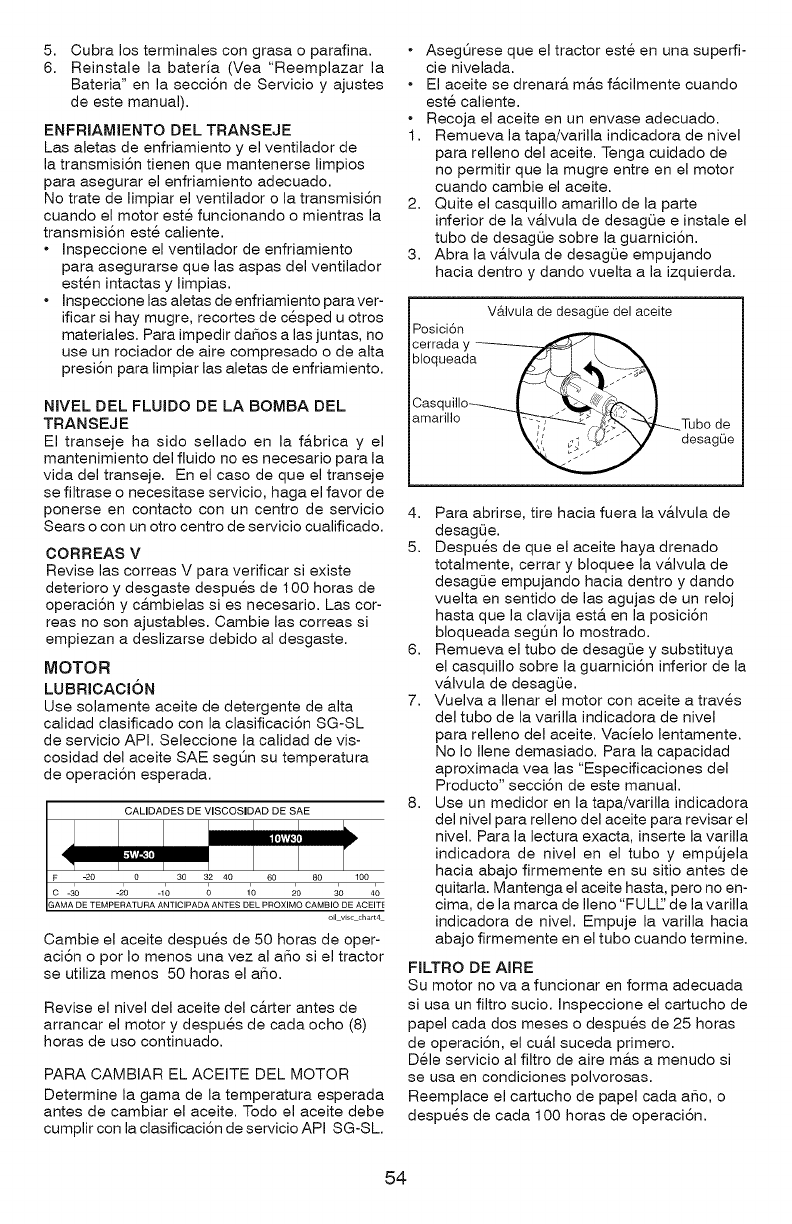
5,
6.
Cubra los terminales con grasa o parafina.
Reinstale la baterJa (Vea "Reemplazar la
Bateria" en la secci6n de Servicio y ajustes
de este manual).
ENFRIAMIENTO DEL TRANSEJE
Las aletas de enfriamiento yel ventilador de
la transmisi6n tienen que mantenerse limpios
para asegurar el enfriamiento adecuado.
No trate de limpiar el ventilador o la transmisi6n
cuando el motor este funcionando o mientras la
transmisi6n este caliente.
• Inspeccione el ventilador de enfriamiento
para asegurarse que las aspas del ventilador
esten intactas y limpias.
• Inspeccione las aletas de enfriamiento paraver-
ificar si hay mugre, recortes de cesped u otros
materiales. Para impedir daSos alas juntas, no
use un rociador de aire compresado o de alta
presi6n para limpiar las aletas de enfriamiento.
NIVEL DEL FLUIDO DE LA BOMBA DEL
TRANSEJE
El transeje ha sido sellado en la f&brica y el
mantenimiento del fluido no es necesario para la
vida del transeje. En el caso de que el transeje
se filtrase o necesitase servicio, haga el favor de
ponerse en contacto con un centro de servicio
Sears o con un otro centro de servicio cualificado.
CORREAS V
Revise las correas V para verificar si existe
deterioro y desgaste despues de 100 horas de
operaci6n y c&mbielas si es necesario. Las cor-
reas no son ajustables. Cambie las correas si
empiezan a deslizarse debido al desgaste.
MOTOR
LUBRICACI6N
Use solamente aceite de detergente de alta
calidad clasificado con la clasificaci6n SG-SL
de servicio API. Seleccione la calidad de vis-
cosidad del aceite SAE segQn su temperatura
de operaci6n esperada.
CALIDADES DE VISCOSIDAD DE SAE
4o
oiJviscchar t4
Cambie el aceite despues de 50 horas de oper-
aci6n o por Io menos una vez al aSo si el tractor
se utiliza menos 50 horas el aSo.
Revise el nivel del aceite del c&rter antes de
arrancar el motor y despues de cada ocho (8)
horas de uso continuado.
PARA CAMBIAR EL ACEITE DEL MOTOR
Determine la gama de la temperatura esperada
antes de cambiar el aceite. Todo el aceite debe
cumplir con la clasificaci6n de servicio API SG-SL.
• AsegQrese que el tractor este en una superfi-
cie nivelada.
• El aceite se drenar& m&s f&cilmente cuando
este caliente.
• Recoja el aceite en un envase adecuado.
1. Remueva la tapa/varilla indicadora de nivel
para relleno del aceite. Tenga cuidado de
no permitir que la mugre entre en el motor
cuando cambie el aceite.
2. Quite el casquillo amarillo de la parte
inferior de la v&lvula de desagL_e einstale el
tubo de desagQe sobre la guarnici6n.
3. Abra la v&lvula de desagL_e empujando
hacia dentro y dando vuelta a la izquierda.
V&lvula de desagOe del aceite
Posici6n
cerrada y
,oque ,
Casquill°-'----_L _'. _Y_ I
amarillo _-__<Tix_'_Tubo de
desague
4. Para abrirse, tire hacia fuera la v&lvula de
desagL_e.
5. Despues de que el aceite haya drenado
totalmente, cerrar y bloquee la v&lvula de
desagL_e empujando hacia dentro y dando
vuelta en sentido de las agujas de un reloj
hasta que la clavija est'. en la posici6n
bloqueada segQn Io mostrado.
6. Remueva el tubo de desagQe y substituya
el casquillo sobre la guarnici6n inferior de la
v&lvula de desagL_e.
7. Vuelva a Ilenar el motor con aceite a traves
del tubo de la varilla indicadora de nivel
para relleno del aceite. VacJelo lentamente.
No Io Ilene demasiado. Para la capacidad
aproximada vea las "Especificaciones del
Producto" secci6n de este manual.
8. Use un medidor en la tapa/varilla indicadora
del nivel para relleno del aceite para revisar el
nivel. Para la lectura exacta, inserte la varilla
indicadora de nivel en el tubo y empQjela
hacia abajo firmemente en su sitio antes de
quitarla. Mantenga el aceite hasta, pero no en-
cima, de la marca de Ileno "FU LE' de la varilla
indicadora de nivel. Empuje la varilla hacia
abajo firmemente en el tubo cuando termine.
FILTRO DE AIRE
Su motor no va a funcionar en forma adecuada
si usa un filtro sucio. Inspeccione el cartucho de
papel cada dos meses o despues de 25 horas
de operaci6n, el cu&l suceda primero.
Dele servicio al filtro de aire m&s a menudo si
se usa en condiciones polvorosas.
Reemplace el cartucho de papel cada aSo, o
despues de cada 100 horas de operaci6n.
54
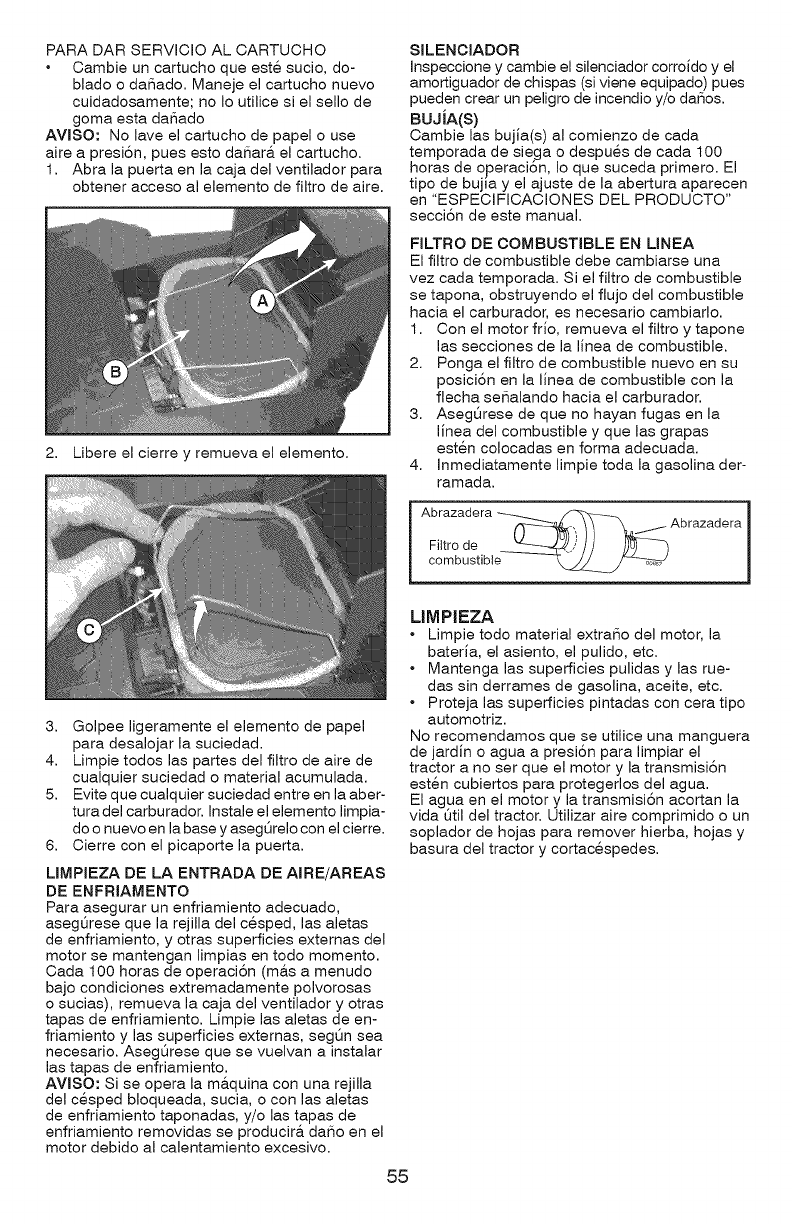
PARA DAR SERVICIO AL CARTUCHO
Cambie un cartucho que este sucio, do-
blado o da_ado. Maneje el cartucho nuevo
cuidadosamente; no Io utilice si el sello de
goma esta da_ado
AVlSO: No lave el cartucho de papel o use
aire a presi6n, pues esto da_ara el cartucho.
1. Abra la puerta en la caja del ventilador para
obtener acceso al elemento de filtro de aire.
2. Libere el cierre y remueva el elemento.
SILENCIADOR
Inspeccione y cambie el silenciador corroido y el
amortiguador de chispas (si viene equipado) pues
pueden crear un peligro de incendio y/o da_os.
BUJiA(S)
Cambie las bujia(s) al comienzo de cada
temporada de si.e,ga o despues de cada 100
horas de operaclon, Io que suceda primero. El
tipo de bujia y el ajuste de la abertura aparecen
en "ESPECIFICACIONES DEL PRODUCTO"
secci6n de este manual.
FILTRO DE COMBUSTIBLE EN LINEA
El filtro de combustible debe cambiarse una
vez cada temporada. Si el filtro de combustible
se tapona, obstruyendo el flujo del combustible
hacia el carburador, es necesario cambiarlo.
1. Con el motor frio, remueva el filtro y tapone
las secciones de la linea de combustible.
2. Ponga el filtro de combustible nuevo en su
posici6n en la linea de combustible con la
flecha seSalando hacia el carburador.
3. Asegt_rese de que no hayan fugas en la
linea del combustible y que las grapas
esten colocadas en forma adecuada.
4. Inmediatamente limpie toda la gasolina der-
ramada.
1
Abrazadera _. _
0_-'_ // ___j Abrazadera J
Fittrode _/// _0) q
combustible
3. Golpee ligeramente el elemento de papel
para desalojar la suciedad.
4. Limpie todos las partes del filtro de aire de
cualquier suciedad o material acumulada.
5. Evite que cualquier suciedad entre en la aber-
tura del carburador. Instale el elemento limpia-
do o nuevo en la base y asegt_relo con el cierre.
6. Cierre con el picaporte la puerta.
LIMPIEZA DE LA ENTRADA DE AIRE/AREAS
DE ENFRIAMENTO
Para asegurar un enfriamiento adecuado,
asegQrese que la rejilla del cesped, las aletas
de enfriamiento, y otras superficies externas del
motor se mantengan limpias en todo momento.
Cada 100 horas de operaci6n (m&s a menudo
bajo condiciones extremadamente polvorosas
o sucias), remueva la caja del ventilador y otras
tapas de enfriamiento. Limpie las aletas de en-
friamiento y las superficies externas, segQn sea
necesario. AsegQrese que se vuelvan a instalar
las tapas de enfriamiento.
AVlSO: Si se opera la m&quina con una rejilla
del cesped bloqueada, sucia, o con las aletas
de enfriamiento taponadas, y/o las tapas de
enfriamiento removidas se producir& daSo en el
motor debido al calentamiento excesivo.
LIMPIEZA
• Limpie todo material extra_o del motor, la
bateria, el asiento, el pulido, etc.
• Mantenga las superficies pulidas y las rue-
das sin derrames de gasolina, aceite, etc.
• Proteja las superficies pintadas con cera tipo
automotriz.
No recomendamos que se utilice una manguera
de jardin o agua a presi6n para limpiar el
tractor a no ser que el motor y la transmisi6n
esten cubiertos para protegerlos del agua.
El agua en el motor y la transmisi6n acortan la
vida Qtil del tractor. Utilizar aire comprimido o un
soplador de hojas para remover hierba, hojas y
basura del tractor y cortacespedes.
55
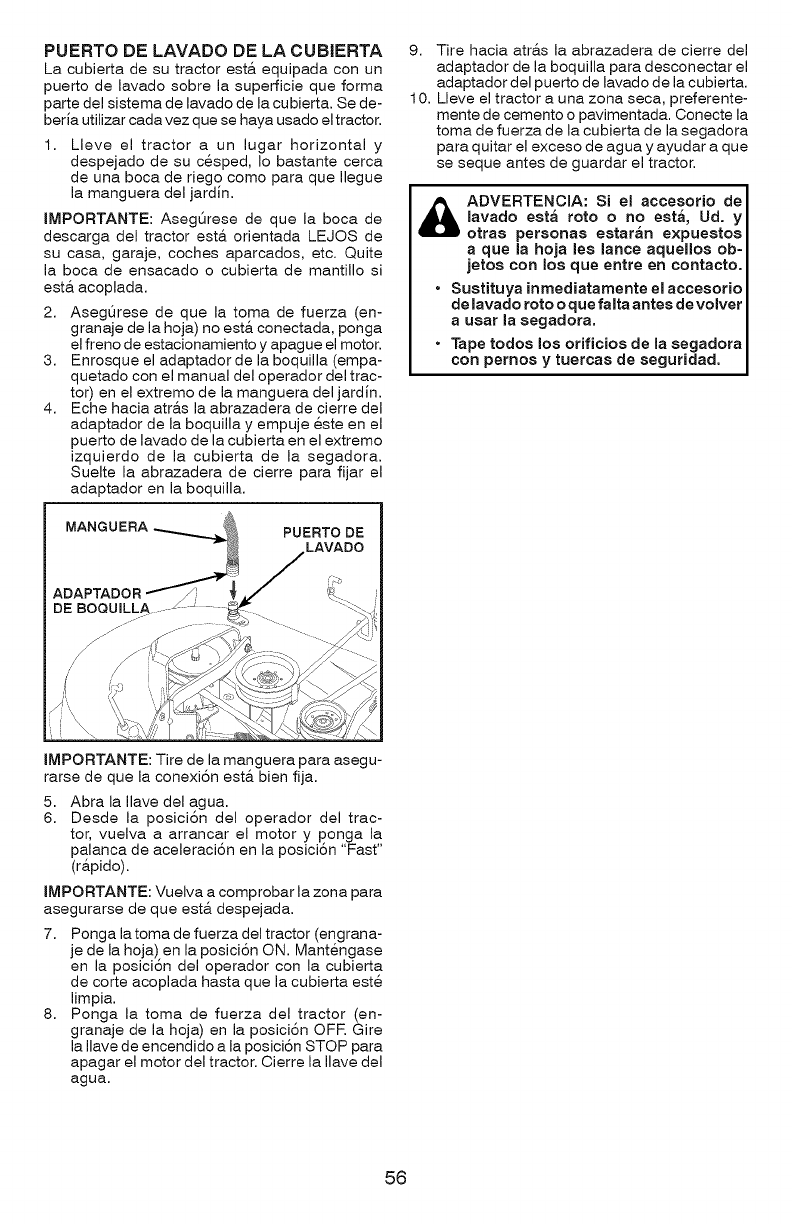
PUERTO DE LAVADO DE LA CUBIERTA
La cubierta de su tractor est& equipada con un
puerto de lavado sobre la superficie que forma
parte del sistema de lavado de la cubierta. Se de-
beria utilizar cada vez que se haya usado el tractor.
1. Lleve el tractor a un lugar horizontal y
despejado de su cesped, Io bastante cerca
de una boca de riego como para que Ilegue
la manguera del jardin.
IMPORTANTE: AsegQrese de que la boca de
descarga del tractor est& orientada LEJOS de
su casa, garaje, coches aparcados, etc. Quite
la boca de ensacado o cubierta de mantillo si
est& acoplada.
2. AsegSrese de que la toma de fuerza (en-
granaje de la hoja) no est& conectada, ponga
el freno de estacionamiento y apague el motor.
3. Enrosque el adaptadorde la boquilla (empa-
quetado con el manual del operador del trac-
tor) en el extremo de la manguera del jardin.
4. Eche hacia atr&s la abrazadera de cierre del
adaptador de la boquilla y empuje este en el
puerto de lavado de la cubierta en el extremo
izquierdo de la cubierta de la segadora.
Suelte la abrazadera de cierre para fijar el
adaptador en la boquilla.
PUERTO DE
9. Tire hacia atr@.s la abrazadera de cierre del
adaptador de la boquilla para desconectar el
adaptador del puerto de lavado de la cubierta.
10. Lleve el tractor a una zona seca, preferente-
mente de cemento o pavimentada. Conecte la
toma de fuerza de la cubierta de la segadora
para quitar el exceso de agua y ayudar a que
se seque antes de guardar el tractor.
ADVERTENCIA: Si el accesorio de
lavado esta roto o no esta, Ud. y
otras personas estaran e×puestos
a que la hoja les lance aquellos ob-
jetos con los que entre en contacto.
• Sustituya inmediatarnente el accesorio
de lavado roto o que falta antes de volver
a usar la segadora.
•Tape todos los orificios de la segadora
con pernos y tuercas de seguridad.
DE BOQUILLA
IMPORTANTE: Tire de la manguera para asegu-
rarse de que la conexiSn est& bien fija.
5. Abra la Ilave del agua.
6. Desde la posiciSn del operador del trac-
tor, vuelva a arrancar el motor y ponga la
palanca de aceleraciSn en la posiciSn "Fast"
(r&pido).
IMPORTANTE: Vuelva a comprobar la zona para
asegurarse de que est& despejada.
7. Ponga la toma de fuerza del tractor (engrana-
je de la hoja) en la posici6n ON. Mant@ngase
en la posici6n del operador con la cubierta
de corte acoplada hasta que la cubierta este
limpia.
8. Ponga la toma de fuerza del tractor (en-
granaje de la hoja) en la posici6n OFF. Gire
la Ilave de encendido a la posici6n STOP para
apagar el motor del tractor. Cierre la Ilave del
agua.
56
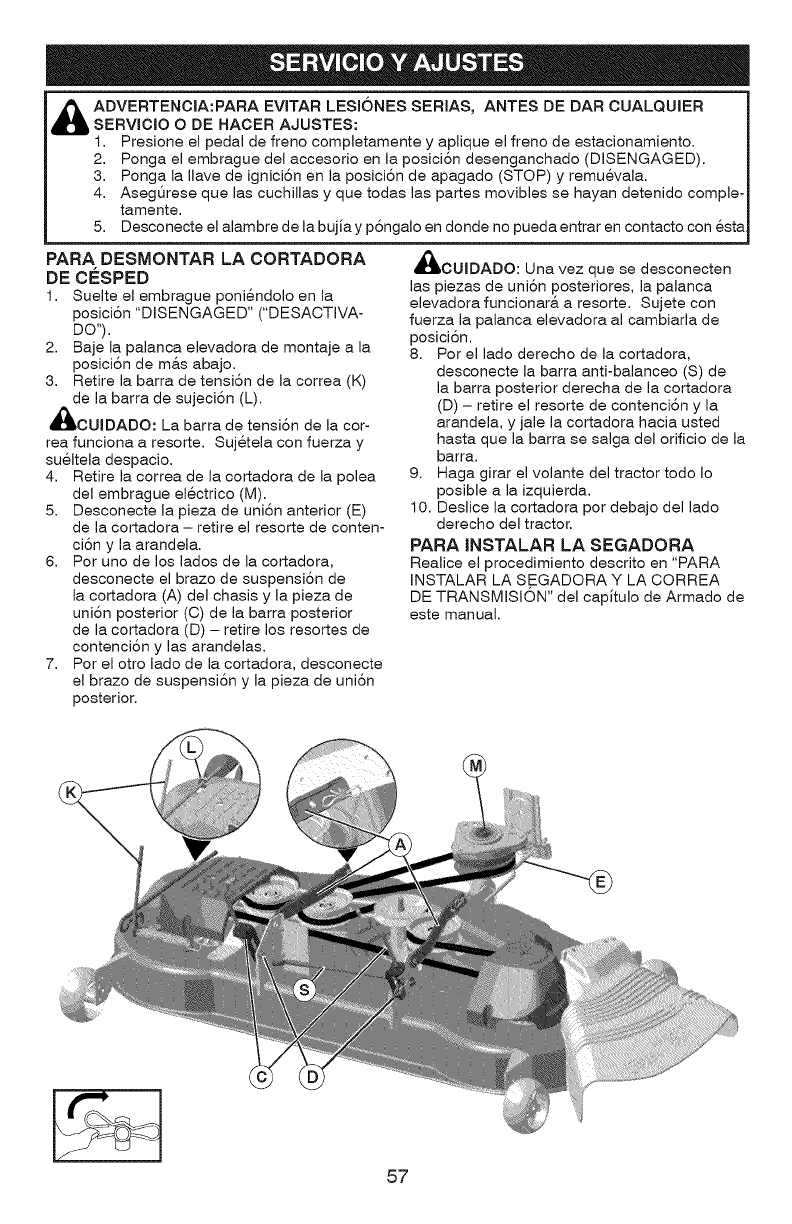
ADVERTENCIA:PARA EVITAR LESIONES SERIAS, ANTES DE DAR CUALQUIER
SERVICIO O DE HACER AJUSTES:
1. Presione el pedal de freno completamente y aplique el freno de estacionamiento.
2. Ponga el embrague del accesorio en la posici6n desenganchado (DISENGAGED).
3. Ponga la Ilave de ignici6n en la posici6n de apagado (STOP) y remuevala.
4. AsegQrese que las cuchillas y que todas las partes movibles se hayan detenido comple-
tamente.
5. Desconecte el alambre de la bujJa y p6ngalo en donde no pueda entrar en contacto con esta
PARA DESMONTAR LA CORTADORA
oE C_=SPED
1. Suelte el embrague poniendolo en la
posici6n "DISENGAGED" ("DESACTIVA-
DO").
2. Baje la palanca elevadora de montaje a la
posici6n de m&s abajo.
3. Retire la barra de tensi6n de la correa (K)
de la barra de sujeci6n (L).
,_CUlDADO: La barra de tensi6n de la cor-
rea funciona a resorte. Sujetela con fuerza y
sueltela despacio.
4. Retire la correa de la cortadora de la polea
del embrague electrico (M).
5. Desconecte la pieza de uni6n anterior (E)
de la cortadora - retire el resorte de conten-
ci6n y la arandela.
6. Por uno de los lados de la cortadora,
desconecte el brazo de suspensi6n de
la cortadora (A) del chasis y la pieza de
uni6n posterior (C) de la barra posterior
de la cortadora (D) - retire los resortes de
contenci6n y las arandelas.
7. Por el otro lado de la cortadora, desconecte
el brazo de suspensi6n y la pieza de uni6n
posterior.
_CUIDADO: Una vez que se desconecten
las piezas de uni6n posteriores, la palanca
elevadora funcionar& a resorte. Sujete con
fuerza la palanca elevadora al cambiarla de
posici6n.
8. Por el lado derecho de la cortadora,
desconecte la barra anti-balanceo (S) de
la barra posterior derecha de la cortadora
(D) - retire el resorte de contenci6n y la
arandela, y jale la cortadora hacia usted
hasta que la barra se salga del orificio de la
barra.
9. Haga girar el volante del tractor todo Io
posible a la izquierda.
10. Deslice la cortadora por debajo del lado
derecho del tractor.
PARA INSTALAR LA SEGADORA
Realice el procedimiento descrito en "PARA
INSTALAR LA S,EGADORA Y LA CORREA
DE TRANSMISION" del capJtulo de Armado de
este manual.
57
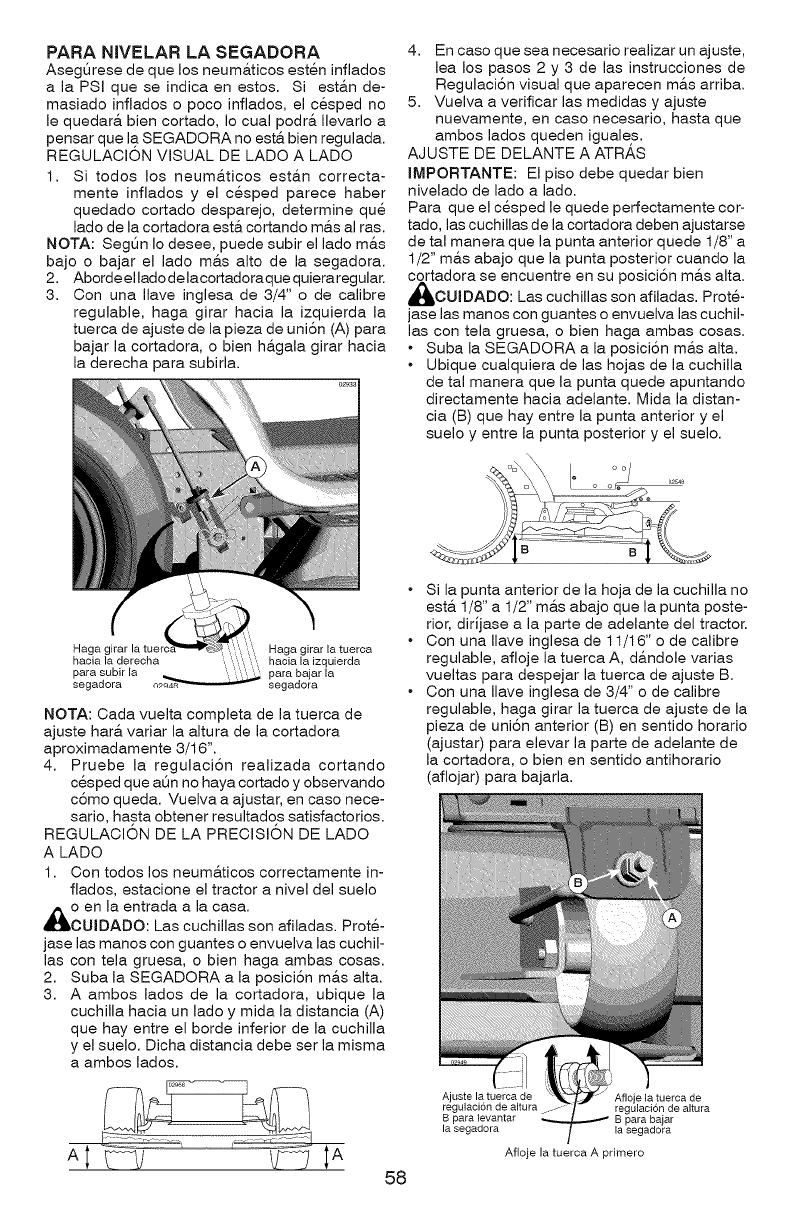
PARA NIVELAR LA SEGADORA
AsegQrese de que los neum&ticos esten inflados
a la PSI que se indica en estos. Si est&n de-
masiado inflados o poco inflados, el cesped no
le quedar& bien cortado, Io cual podr& Ilevarlo a
pensar que la,SEGADORA no esta. bien regulada.
REGULACION VISUAL DE LADO A LADO
1. Si todos los neum&ticos esta.n correcta-
mente inflados y el cesped parece haber
quedado cortado desparejo, determine que
lado de la cortadora est& cortando ma.sal ras.
NOTA: SegQn Io desee, puede subir el lado m&s
bajo o bajar el lado ma.s alto de la segadora.
2. Aborde ellado de lacortadoraque quiera regular.
3. Con una Ilave inglesa de 3/4" o de calibre
regulable, haga girar hacia la izquierda la
tuerca de ajuste de la pieza de uni6n (A) para
bajar la cortadora, o bien h&gala girar hacia
la derecha para subirla.
4. En caso que sea necesario realizar un ajuste,
lea los pasos 2 y 3 de las instrucciones de
Regulaci6n visual que aparecen m&s arriba.
5. Vuelva a verificar las medidas y ajuste
nuevamente, en caso necesario, hasta que
ambos lados queden iguales.
AJUSTE DE DELANTE A ATRAS
IMPORTANTE: El piso debe quedar bien
nivelado de lado a lado.
Para que el cesped le quede perfectamente cor-
tado, las cuchillas de la cortadora deben ajustarse
de tal manera que la punta anterior quede 1/8" a
1/2" m&s abajo que la punta posterior cuando la
cortadora se encuentre en su posici6n m&s alta.
CUIDADO: Las cuchillas son afiladas. Prot&
jase las manos con guantes o envuelva las cuchil-
las con tela gruesa, o bien haga ambas cosas.
•Suba la SEGADORA a la posici6n m&s alta.
• Ubique cualquiera de las hojas de la cuchilla
de tal manera que la punta quede apuntando
directamente hacia adelante. Mida la distan-
cia (B) que hay entre la punta anterior y el
suelo y entre la punta posterior y el suelo.
Haga gi Haga girar la tuerca
haciala derecha \ _, hacia la izquierda
para subir la _ _ para bajar la
segadora segadora
NOTA: Cada vuelta completa de la tuerca de
ajuste har& variar la altura de la cortadora
aproximadamente 3/16".
4. Pruebe la regulaci6n realizada cortando
cesped que aQnno haya cortado y observando
c6mo queda. Vuelva a ajustar, en caso nece-
sario, hasta obtener resultados satisfactorios.
REGULACI6N DE LA PRECISI6N DE LADO
A LADO
1. Con todos los neum&ticos correctamente in-
flados, estacione el tractor a nivel del suelo
o en la entrada a la casa.
CUIDADO: Las cuchillas son afiladas. Prot&
jase las manos con guantes o envuelva las cuchil-
las con tela gruesa, o bien haga ambas cosas.
2. Suba la SEGADORA a la posici6n m&s alta.
3. A ambos lados de la cortadora, ubique la
cuchilla hacia un lado y mida la distancia (A)
que hay entre el borde inferior de la cuchilla
yel suelo. Dicha distancia debe ser la misma
a ambos lados.
AI_- _::::::::' _--::- _ IA 58
• Si la punta anterior de la hoja de la cuchilla no
est& 1/8" a 1/2" m&s abajo que la punta poste-
rior, dirijase a la parte de adelante del tractor.
• Con una Ilave inglesa de 11/16" o de calibre
regulable, afloje la tuerca A, d&ndole varias
vueltas para despejar la tuerca de ajuste B.
• Con una Ilave inglesa de 3/4" o de calibre
regulable, haga girar la tuerca de ajuste de la
pieza de uni6n anterior (B) en sentido horario
(ajustar) para elevar la parte de adelante de
la cortadora, o bien en sentido antihorario
(aflojar) para bajarla.
Ajuste la tuerca de Afloje la tuerca de
regulaci6n de altura regulaci6n de altura
B para levantar B para bajar
la segadora la segadora
Afloje la tuerca A primero
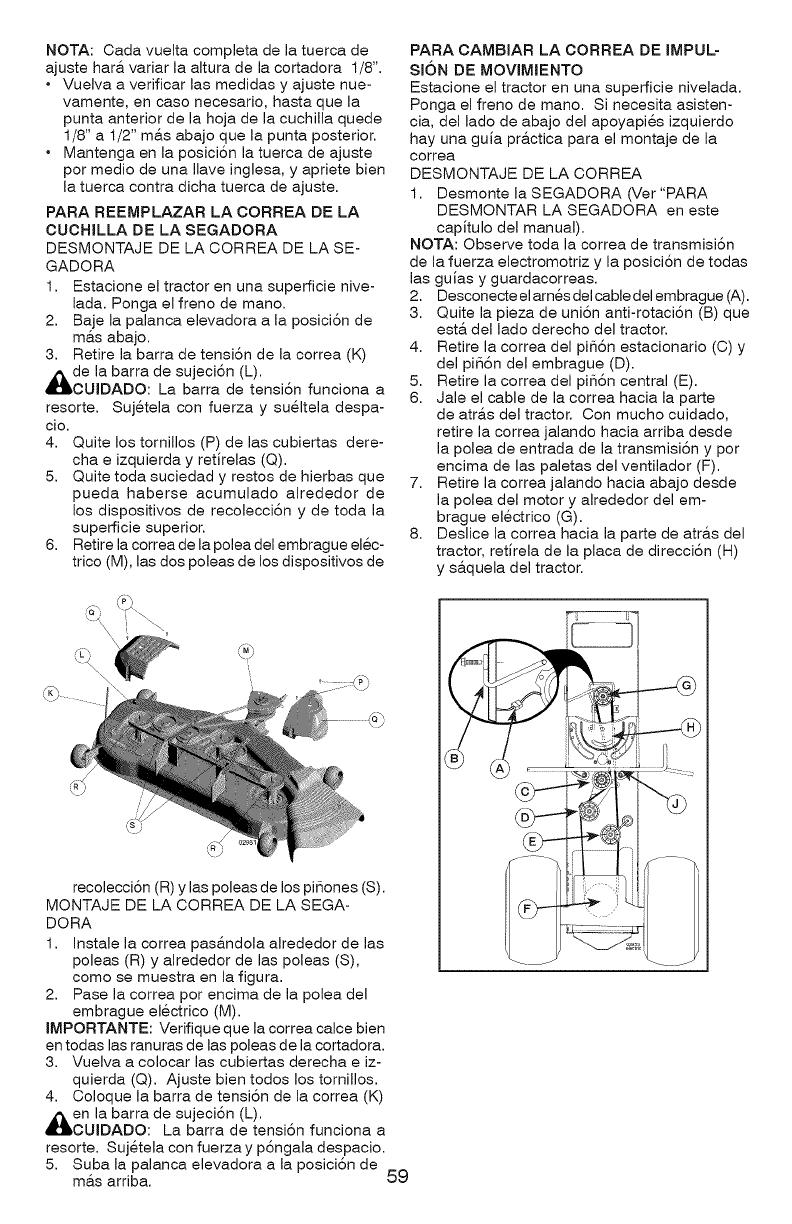
NOTA: Cada vuelta completa de la tuerca de
ajuste har& variar la altura de la cortadora 1/8".
• Vuelva a verificar las medidas y ajuste nue-
vamente, en caso necesario, hasta que la
punta anterior de la hoja de la cuchilla quede
1/8" a 1/2" m&s abajo que la punta posterior.
• Mantenga en la posici6n la tuerca de ajuste
por medic de una Ilave inglesa, y apriete bien
la tuerca contra dicha tuerca de ajuste.
PARA REEMPLAZAR LA CORREA DE LA
CUOHILLA DE LA SEGADORA
DESMONTAJE DE LA CORREA DE LA SE-
GADORA
1. Estacione el tractor en una superficie nive-
lada. Ponga el freno de mano.
2. Baje la palanca elevadora a la posici6n de
m&s abajo.
3. Retire la barra de tensi6n de la correa (K)
de la barra de sujeci6n (L).
CUiDADO: La barra de tensi6n funciona a
resorte. Sujetela con fuerza y sueltela despa-
cio.
4. Quite los tornillos (P) de las cubiertas dere-
cha eizquierda y retirelas (Q).
5. Quite toda suciedad y restos de hierbas que
pueda haberse acumulado alrededor de
los dispositivos de recolecci6n y de toda la
superficie superior.
6. Retire la correa de la polea del embrague elec-
trico (M), las dos poleas de los dispositivos de
PARA CAMBIAR LA CORREA DE IMPUL=
SI6N DE MOVIMIENTO
Estacione el tractor en una superficie nivelada.
Ponga el freno de mano. Si necesita asisten-
cia, del lado de abajo del apoyapies izquierdo
hay una guia pr&ctica para el montaje de la
correa
DESMONTAJE DE LA CORREA
1. Desmonte la SEGADORA (Ver"PARA
DESMONTAR LA SEGADORA en este
capitulo del manual).
NOTA: Observe toda la correa de transmisi6n
de la fuerza electromotriz y la posici6n de todas
las guias y guardacorreas.
2. Desconecte el ames del cable del embrague (A).
3. Quite la pieza de uni6n anti-rotaci6n (B) que
est& del lado derecho del tractor.
4. Retire la correa del pi56n estacionario (C) y
del pi56n del embrague (D).
5. Retire la correa del pi56n central (E).
6. Jale el cable de la correa hacia la parte
de atr&s del tractor. Con mucho cuidado,
retire la correa jalando hacia arriba desde
la polea de entrada de la transmisi6n y por
encima de las paletas del ventilador (F).
7. Retire la correa jalando hacia abajo desde
la polea del motor y alrededor del em-
brague electrico (G).
8. Deslice la correa hacia la parte de atr&s del
tractor, retirela de la placa de direcci6n (H)
y s&quela del tractor.
\
recolecci6n (R) y las poleas de los piSones (S).
MONTAJE DE LA CORREA DE LA SEGA-
DORA
1. Instale la correa pas&ndola alrededor de las
poleas (R) y alrededor de las poleas (S),
como se muestra en la figura.
2. Pase la correa por encima de la polea del
embrague electrico (M).
IMPORTANTE: Verifique que la correa calce bien
en todas las ranuras de las poleas de la cortadora.
3. Vuelva a colocar las cubiertas derecha e iz-
quierda (Q). Ajuste bien todos los tomillos.
4. Coloque la barra de tensi6n de la correa (K)
_lben la barra de sujeci6n (L).
CUIDADO: La barra de tensi6n funciona a
resorte. Sujetela con fuerza y p6ngala despacio.
5. Suba la palanca elevadora a la posici6n de
m&s arriba. 59
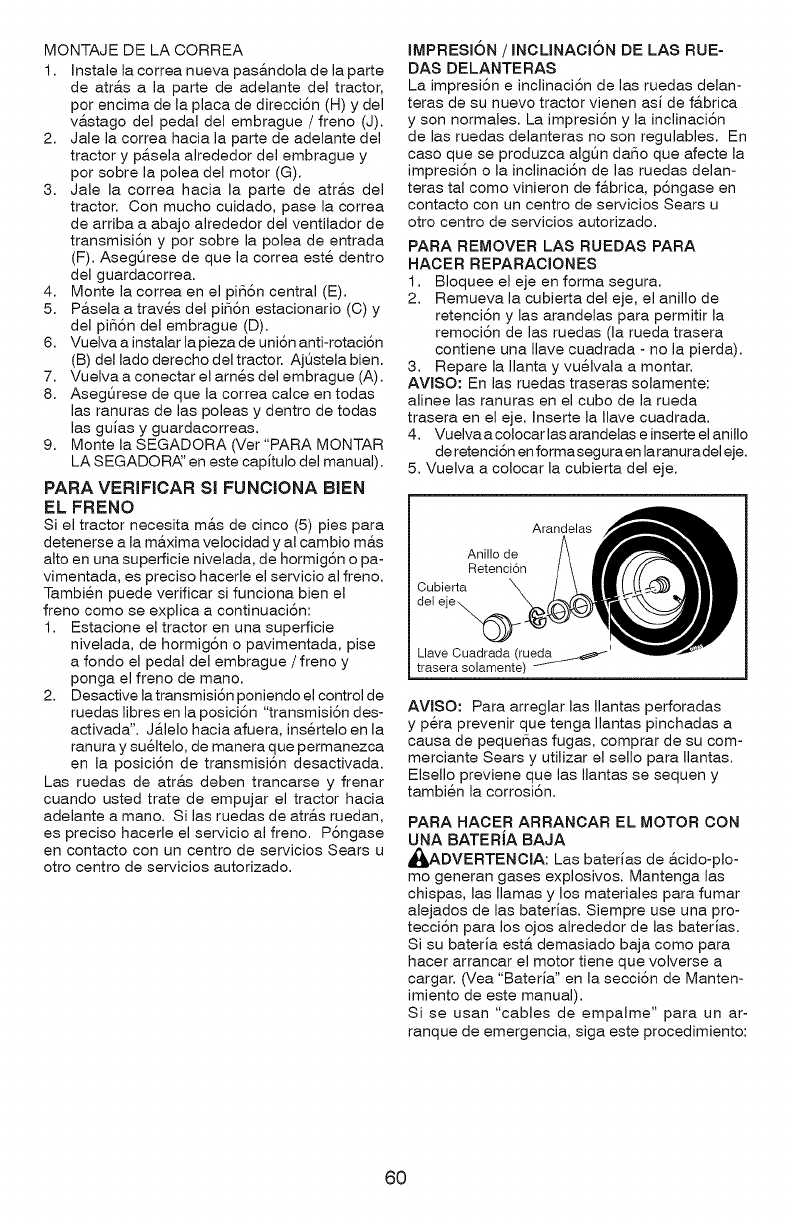
MONTAJEDELACORREA
1. Instalelacorreanuevapasandoladelaparte
deatra.salapartedeadelantedeltractor,
porencimadelaplacadedirecci6n(H)ydel
vastagodelpedaldelembrague/freno (J).
2. Jale la correa hacia la parte de adelante del
tractor y pa.sela alrededor del embrague y
por sobre la polea del motor (G).
3. Jale la correa hacia la parte de atras del
tractor. Con mucho cuidado, pase la correa
de arriba a abajo alrededor del ventilador de
transmisi6n y por sobre la polea de entrada
(F). Aseg0rese de que la correa este dentro
del guardacorrea.
4. Monte la correa en el pi_6n central (E).
5. P&sela a traves del pi_6n estacionario (C) y
del pi_6n del embrague (D).
6. Vuelva a instalar la pieza de uni6n anti-rotaci6n
(B) del lado derecho del tractor. Aj0stela bien.
7. Vuelva a conectar el arnes del embrague (A).
8. Asegt_rese de que la correa calce en todas
las ranuras de las poleas y dentro de todas
las guias y guardacorreas.
9. Monte la SEGADORA (Ver "PARA MONTAR
LA SEGADORA:' en este capitulo del manual).
PARA VERIFICAR SI FUNCIONA BIEN
EL FRENO
Si el tractor necesita mas de cinco (5) pies para
detenerse a la m&xima velocidad y al cambio ma.s
alto en una superficie nivelada, de hormig6n o pa-
vimentada, es preciso hacerle el servicio al freno.
Tambien puede verificar si funciona bien el
freno como se explica a continuaci6n:
1. Estacione el tractor en una superficie
nivelada, de hormig6n o pavimentada, pise
a fondo el pedal del embrague /freno y
ponga el freno de mano.
2. Desactive latransmisi6n poniendo el control de
ruedas libres en la posici6n "transmisi6n des-
activada". Ja.lelo hacia afuera, insertelo en la
ranura y sueltelo, de manera que permanezca
en la posici6n de transmisi6n desactivada.
Las ruedas de atr&s deben trancarse y frenar
cuando usted trate de empujar el tractor hacia
adelante a mano. Si las ruedas de atras ruedan,
es preciso hacerle el servicio al freno. P6ngase
en contacto con un centro de servicios Sears u
otro centro de servicios autorizado.
IMPRESION /INCLINACION DE LAS RUE=
DAS DELANTERAS
La impresi6n e inclinaci6n de las ruedas delan-
teras de su nuevo tractor vienen asi de fabrica
y son normales. La impresi6n y la inclinaci6n
de las ruedas delanteras no son regulables. En
caso que se produzca algt_n da_o que afecte la
impresi6n o la inclinaci6n de las ruedas delan-
teras tal como vinieron de fabrica, p6ngase en
contacto con un centro de servicios Sears u
otro centro de servicios autorizado.
PARA REMOVER LAS RUEDAS PARA
HACER REPARAOIONES
1. Bloquee el eje en forma segura.
2. Remueva la cubierta del eje, el anillo de
retenci6n y las arandelas para permitir la
remoci6n de las ruedas (la rueda trasera
contiene una Ilave cuadrada - no la pierda).
3. Repare la Ilanta y vuelvala a montar.
AVlSO: En las ruedas traseras solamente:
alinee las ranuras en el cubo de la rueda
trasera en el eje. Inserte la Ilave cuadrada.
4. Vuelva a colocar las arandelas e inserte el anillo
de retenci6n en formaseguraen la ranuradel eje.
5. Vuelva a colocar la cubierta del eje.
Arandelas
Anillo de
Retenci6n
Oubierta \
det "
Llave Cuadrada (rueda __/'
trasera solamente)
AVISO: Para arreglar las Ilantas perforadas
y pera prevenir que tenga Ilantas pinchadas a
causa de pequeSas fugas, comprar de su com-
merciante Sears y utilizar el sello para Ilantas.
Elsello previene que las Ilantas se sequen y
tambien la corrosi6n.
PARA HACER ARRANCAR EL MOTOR CON
UNA BATERiA BAJA
_DVERTENCIA: Las baterias de &cido-plo-
mo generan gases explosivos. Mantenga las
chispas, las llamas y los materiales para fumar
alejados de las baterias. Siempre use una pro-
tecci6n para los ojos alrededor de las baterias.
Si su bateria esta. demasiado baja como para
hacer arrancar el motor tiene que volverse a
cargar. (Yea "Bateria" en la secci6n de Manten-
imiento de este manual).
Si se usan "cables de empalme" para un ar-
ranque de emergencia, siga este procedimiento:
60
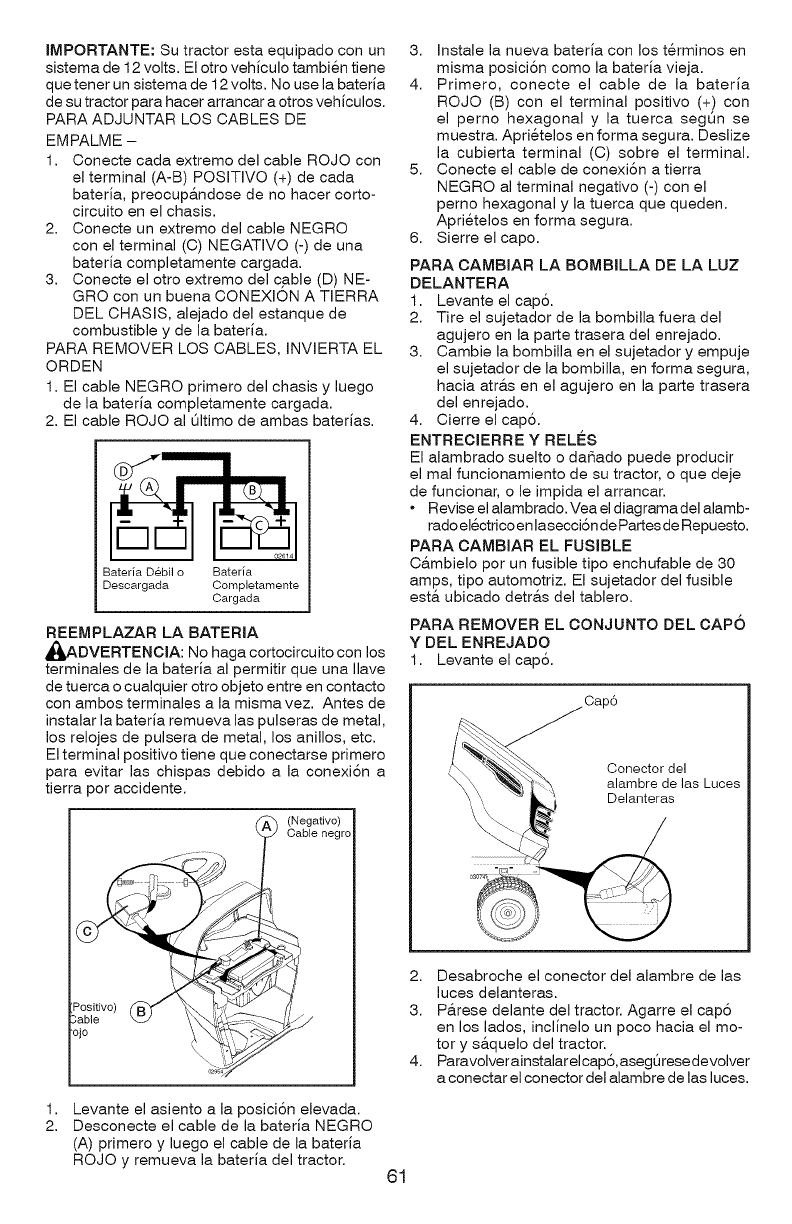
IMPORTANTE: Su tractor esta equipado con un
sistema de 12 volts. El otro vehiculo tambien tiene
que tener un sistema de 12 volts. No use la bateria
de su tractor para hacer arrancar a otros vehiculos.
PARA ADJUNTAR LOS CABLES DE
EMPALME -
1. Conecte cada extremo del cable ROJO con
el terminal (A-B) POSITJVO (+) de cada
bateria, preocup&ndose de no hacer corto-
circuito en el chasis.
2. Conecte un extremo del cable NEGRO
con el terminal (C) NEGATJVO (-) de una
bateria completamente cargada.
3. Conecte el otro extremo del cable (D) NE-
GRO con un buena CONEXION A TJERRA
DEL CHASIS, alejado del estanque de
combustible y de la bateria.
PARA REMOVER LOS CABLES, iNVIERTA EL
ORDEN
1. El cable NEGRO primero del chasis y luego
de la bateria completamente cargada.
2. El cable ROJO al Qltimo de ambas baterias.
Bateria Debil o Bateria
Descargada Completamente
Cargada
REEMPLAZAR LA BATERIA
_bADVERTENCIA: No haga cortocircuito con los
terminales de la bateria al permitir que una Ilave
de tuerca o cualquier otro objeto entre en contacto
con ambos terminales a la misma vez. Antes de
instalar la bateria remueva las pulseras de metal,
los relojes de pulsera de metal, los anillos, etc.
El terminal positivo tiene que conectarse primero
para evitar las chispas debido a la conexi6n a
tierra por accidente.
(Negativo)
Cable negro
Positivo)
}able
ojo
1,
2. Levante el asiento a la posici6n elevada.
Desconecte el cable de la bateria NEGRO
(A) primero y luego el cable de la bateria
ROJO y remueva la bateria del tractor. 61
3. Instale la nueva bateria con los t@minos en
misma posici6n como la bateria vieja.
4. Primero, conecte el cable de la bateria
ROJO (B) con el terminal positivo (+) con
el perno hexagonal y la tuerca segt_n se
muestra. Aprietelos en forma segura. Deslize
la cubierta terminal (C) sobre el terminal.
5. Conecte el cable de conexi6n a tierra
NEGRO al terminal negativo (-) con el
perno hexagonal y la tuerca que queden.
Aprietelos en forma segura.
6. Sierre el capo.
PARA CAMBIAR LA BOMBILLA DE LA LUZ
DELANTERA
1. Levante el cap6.
2. Tire el sujetador de la bombilla fuera del
agujero en la parte trasera del enrejado.
3. Cambie la bombilla en el sujetador y empuje
el sujetador de la bombilla, en forma segura,
hacia atra.s en el agujero en la parte trasera
del enrejado.
4. Cierre el cap6.
ENTREOIERRE Y RELES
El alambrado suelto o daSado puede producir
el mal funcionamiento de su tractor, o que deje
de funcionar, o le impida el arrancar.
• Revise el alambrado. Yea el diagramadel alamb-
rado electrico en lasecci6n de Partesde Repuesto.
PARA OAMBIAR EL FUSIBLE
C&mbielo por un fusible tipo enchufable de 30
amps, tipo automotriz. El sujetador del fusible
est& ubicado detr&s del tablero.
PARA REMOVER EL CONJUNTO DEL CAPO
YDEL ENREJADO
1. Levante el cap6.
Conector del
alambre de las Luces
Delanteras
2. Desabroche el conector del alambre de las
luces delanteras.
3. Pa.rese delante del tractor. Agarre el cap6
en los lados, inclinelo un poco hacia el mo-
tor y sa.quelo del tractor.
4. Paravolverainstalar elcap6, asegSresedevolver
a conectar el conector del alambre de las luces.
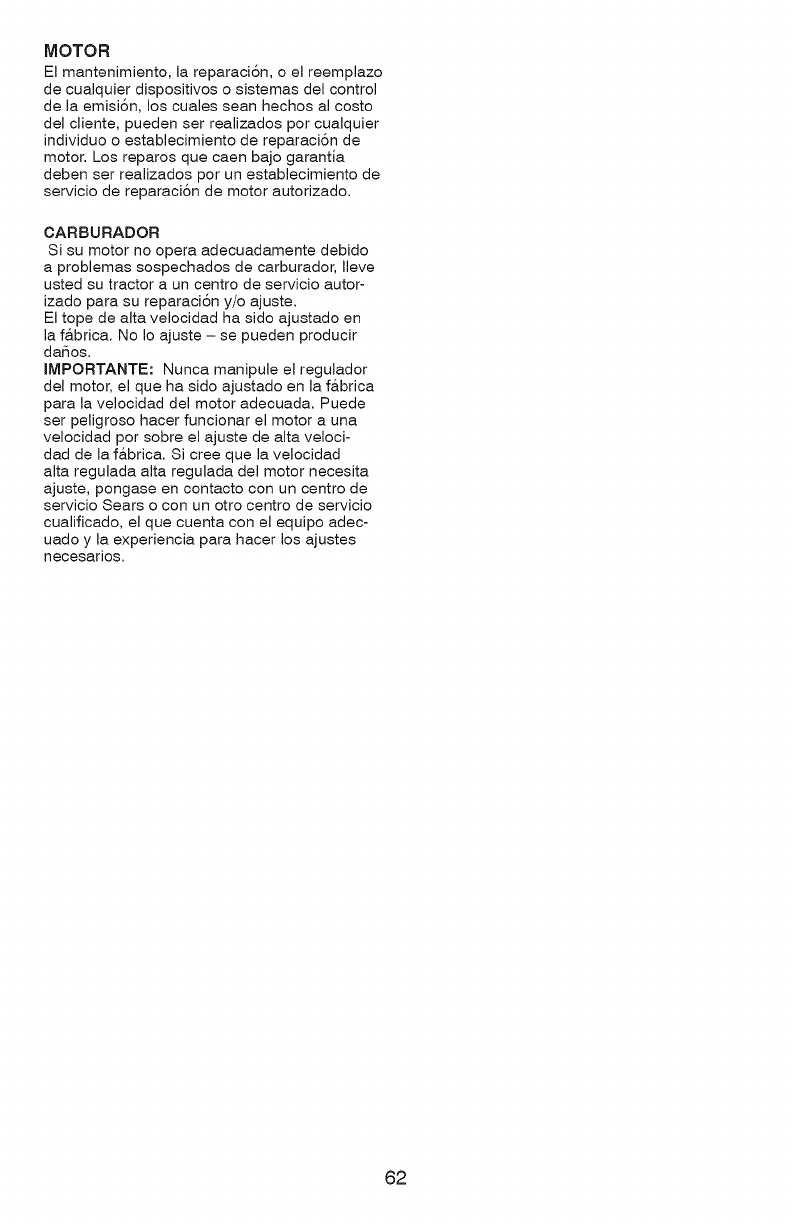
MOTOR
El mantenimiento, la reparaci6n, o el reemplazo
de cualquier dispositivos o sistemas del control
de la emisi6n, los cuales sean hechos al costo
del cliente, pueden ser realizados por cualquier
individuo o establecimiento de reparaci6n de
motor. Los reparos que caen bajo garantia
deben ser realizados por un establecimiento de
servicio de reparaci6n de motor autorizado.
CARBURADOR
Si su motor no opera adecuadamente debido
a problemas sospechados de carburador, Ileve
usted su tractor a un centro de servicio autor-
izado para su reparaci6n y/o ajuste.
El tope de alta velocidad ha sido ajustado en
la f&brica. No Io ajuste - se pueden producir
dafios.
IIVlPORTANTE: Nunca manipule el regulador
del motor, el que ha sido ajustado en la f&brica
para la velocidad del motor adecuada. Puede
ser peligroso hacer funcionar el motor a una
velocidad por sobre el ajuste de alta veloci-
dad de la f&brica. Si cree que la velocidad
alta regulada alta regulada del motor necesita
ajuste, pongase en contacto con un centro de
servicio Sears o con un otro centro de servicio
cualificado, el que cuenta con el equipo adec-
uado y la experiencia para hacer los ajustes
necesarios.
62
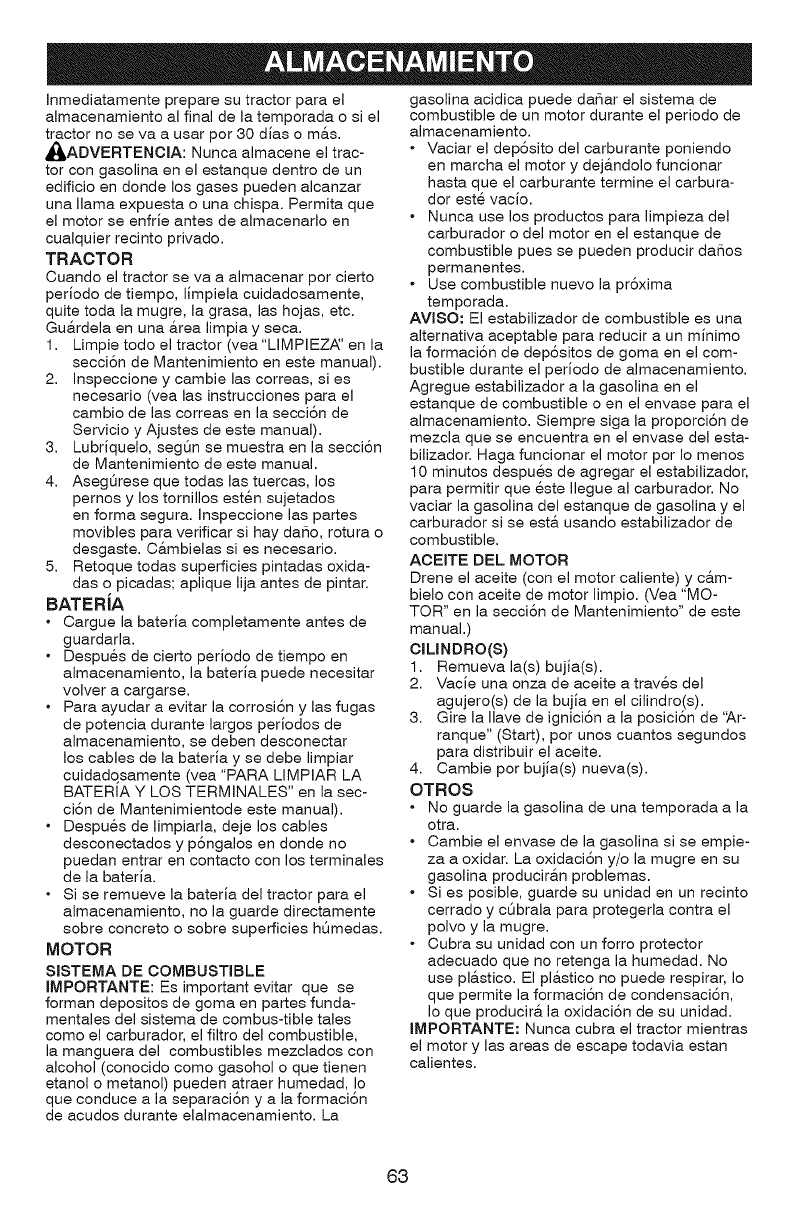
Inmediatamente prepare su tractor para el
almacenamiento al final de la temporada o si el
tractor no se va a usar por 30 dias o m&s.
_ADVERTENCIA: Nunca almacene el trac-
tor con gasolina en el estanque dentro de un
edificio en donde los gases pueden alcanzar
una llama expuesta o una chispa. Permita que
el motor se enfrie antes de almacenarlo en
cualquier recinto privado.
TRACTOR
Cuando el tractor se va a almacenar por cierto
periodo de tiempo, limpiela cuidadosamente,
quite toda la mugre, la grasa, las hojas, etc.
Gu&rdela en una &rea limpia y seca.
1. Limpie todo el tractor (yea "LIMPIEZ,_' en la
secci6n de Mantenimiento en este manual).
2. Inspeccione y cambie las correas, si es
necesario (yea las instrucciones para el
cambio de las correas en la secci6n de
Servicio y Ajustes de este manual).
3. Lubriquelo, segt_n se muestra en la secci6n
de Mantenimiento de este manual.
4. AsegQrese que todas las tuercas, los
pernos y los tornillos esten sujetados
en forma segura. Inspeccione las partes
movibles para verificar si hay daSo, rotura o
desgaste. C&mbielas si es necesario.
5. Retoque todas superficies pintadas oxida-
das o picadas; aplique lija antes de pintar.
BATERiA
• Cargue la bateria completamente antes de
guardarla.
• Despues de cierto periodo de tiempo en
almacenamiento, la bateria puede necesitar
volver a cargarse.
• Para ayudar a evitar la corrosi6n y las fugas
de potencia durante largos periodos de
almacenamiento, se deben desconectar
los cables de la baterJa y se debe limpiar
cuidadqsamente (yea "PARA LIMPIAR LA
BATERIA Y LOS TERMINALES" en la sec-
ci6n de Mantenimientode este manual).
• Despues de limpiarla, deje los cables
desconectados y p6ngalos en donde no
puedan entrar en contacto con los terminales
de la bateria.
• Si se remueve la bateria del tractor para el
almacenamiento, no la guarde directamente
sobre concreto o sobre superficies hQmedas.
MOTOR
SISTEMA DE COMBUSTIBLE
IMPORTANTE: Es important evitar que se
forman depositos de goma en partes funda-
mentales del sistema de combus-tible tales
como el carburador, el filtro del combustible,
la manguera del combustibles mezclados con
alcohol (conocido como gasohol o que tienen
etanol o metanol) pueden atraer humedad, Io
que conduce a la separaci6n y a la formaci6n
de acudos durante elalmacenamiento. La
gasolina acidica puede daSar el sistema de
combustible de un motor durante el periodo de
almacenamiento.
• Vaciar el dep6sito del carburante poniendo
en marcha el motor y dej&ndolo funcionar
hasta que el carburante termine el carbura-
dor este vacio.
• Nunca use los productos para limpieza del
carburador o del motor en el estanque de
combustible pues se pueden producir daSos
permanentes.
• Use combustible nuevo la pr6xima
temporada.
AVISO: El estabilizador de combustible es una
alternativa aceptable para reducir a un minimo
la formaci6n de dep6sitos de goma en el com-
bustible durante el periodo de almacenamiento.
Agregue estabilizador a la gasolina en el
estanque de combustible o en el envase para el
almacenamiento. Siempre siga la proporci6n de
mezcla que se encuentra en el envase del esta-
bilizador. Haga funcionar el motor por Io menos
10 minutos despues de agregar el estabilizador,
para permitir que este Ilegue al carburador. No
vaciar la gasolina del estanque de gasolina y el
carburador si se est& usando estabilizador de
combustible.
ACEITE DEL MOTOR
Drene el aceite (con el motor caliente) y c&m-
bielo con aceite de motor limpio. (Vea "MO-
TOR" en la secci6n de Mantenimiento" de este
manual.)
CILINDRO(S)
1. Remueva la(s) bujia(s).
2. Vacie una onza de aceite a traves del
agujero(s) de la bujia en el cilindro(s).
3. Gire la Ilave de ignici6n a la posici6n de 'Ar-
ranque" (Start), por unos cuantos segundos
para distribuir el aceite.
4. Cambie por bujia(s) nueva(s).
OTROS
• No guarde la gasolina de una temporada a la
otra.
• Cambie el envase de la gasolina si se empie-
za a oxidar. La oxidaci6n y/o la mugre en su
gasolina producir&n problemas.
• Si es posible, guarde su unidad en un recinto
cerrado y cQbrala para protegerla contra el
polvo y la mugre.
• Cubra su unidad con un forro protector
adecuado que no retenga la humedad. No
use pla.stico. El pl&stico no puede respirar, Io
que permite la formaci6n de condensaci6n,
Io que producir& la oxidaci6n de su unidad.
IMPORTANTE: Nunca cubra el tractor mientras
el motor y las areas de escape todavia estan
calientes.
63
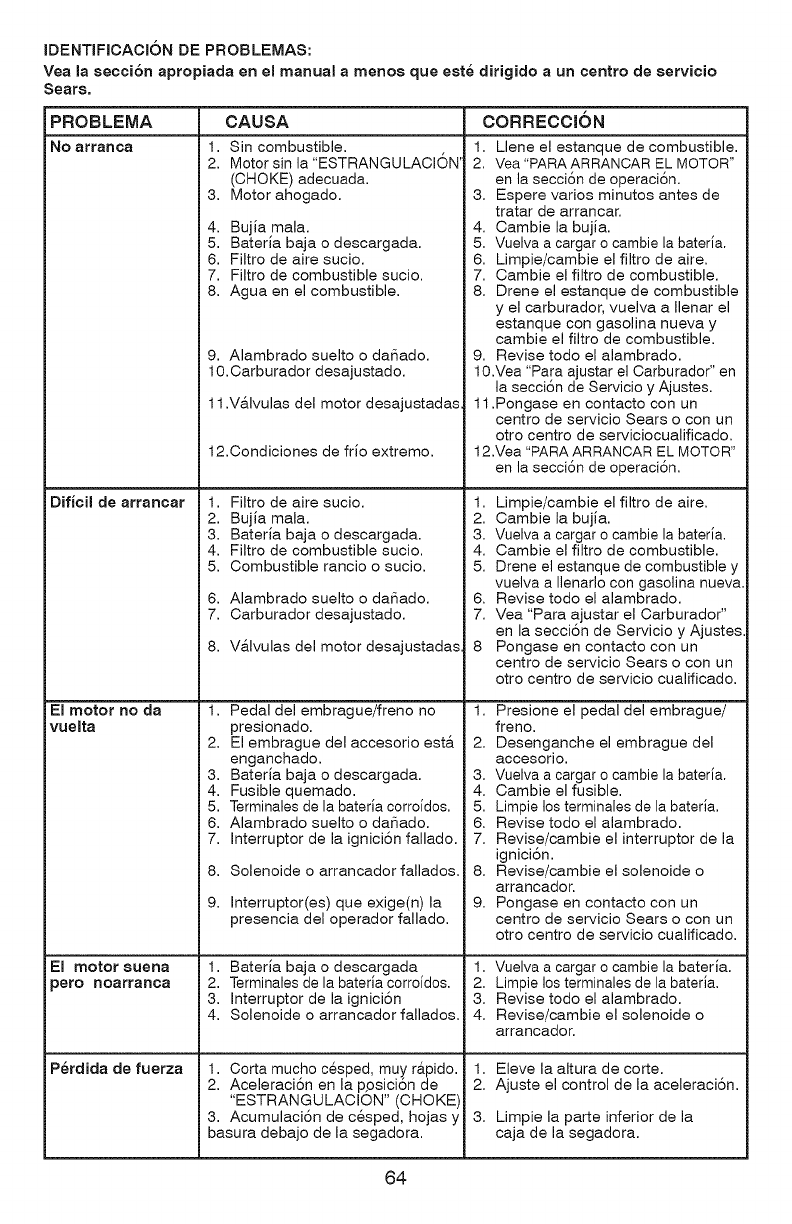
IDENTIFICACION DE PROBLEMAS:
Yea la secci6n apropiada en el manual a menos que este dirigido a un centro de servicio
Sears,
PROBLEMA CAUSA CORRECCION
NO arranca
Dificil de arrancar 1.
2.
3.
4.
5.
El motor no da
vuelta
El motor suena
pero noarranca
P_rdida de fuerza
1. Sin combustible.
2. Motor sin la "ESTRANGULACION'
(CHOKE) adecuada.
3. Motor ahogado.
4. Bujia male.
5. Bateria baja o descargada.
6. Filtro de aire sucio.
7. Filtro de combustible sucio.
8. Ague en el combustible.
9. Alambrado suelto o de,ado.
10.Carburador desajustado.
11 .V&lvulas del motor desajustadas
12.Condiciones de frio extremo.
Filtro de aire sucio.
Bujia male.
Bateria baja o descargada.
Filtro de combustible sucio.
Combustible rancio o sucio.
6. Alambrado suelto o daSado.
7. Carburador desajustado.
8. V&lvulas del motor desajustadas
1. Pedal del embrague/freno no
presionado.
2. El embrague del accesorio est&
enganchado.
3. Bateria baja o descargada.
4. Fusible quemado.
5. Terminales de la bateria corroidos.
6. Alambrado suelto o daSado.
7. Interruptor de la ignici6n fallado.
8. Solenoide o arrancador fallados.
Interruptor(es) que exige(n) la
presencia del operador fallado.
1. Bateria ba a o descargada
2. Terminales de la bater a corro dos.
3. Interruptor de la ignici6n
4. Solenoide o arrancador fallados.
1. Corta mucho cesped, muy r&.pido.
2. Aceleraci6n en la p,osici6n de
"ESTRANGULACION" (CHOKE)
3. Acumulaci6n de cesped, hojas y
basura debajo de la segadora.
1. Llene el estanque de combustible.
2. Vea "PARA ARRANCAR EL MOTOR"
en la secci6n de operaci6n.
3. Espere varios minutos antes de
tratar de arrancar.
4. Cambie la bujia.
5. Vuelva a cargar o cambie la bater[a.
6. Limpie/cambie el filtro de aire.
7. Cambie el filtro de combustible.
8. Drene el estanque de combustible
y el carburador, vuelva a Ilenar el
estanque con gasolina nueva y
cambie el filtro de combustible.
9. Revise todo el alambrado.
10.Vea "Para ejustar el Cerburedor" en
la secci6n de Servicio y Ajustes.
11 .Pongase en contacto con un
centro de servicio Sears o con un
otro centro de serviciocualificado.
12.Vea "PARA ARRANCAR EL MOTOR"
en la secci6n de operaci6n.
1. Limpie/cambie el filtro de aire.
2. Cambie la bujia.
3. Vuelva a cargar o cambie la hater[a,
4. Cambie el filtro de combustible.
5. Drene el estanque de combustible y
vuelve a IlenarJo con gasoline nueva.
6. Revise todo el alambrado.
7. Vea "Para ajustar el Carburador"
en la secci6n de Servicio y Ajustes.
8 Pongase en contacto con un
centro de servicio Sears o con un
otro centro de servicio cualificado.
1. Presione el pedal del embrague/
freno.
2. Desenganche el embrague del
accesorio.
3. Vuelva a cargar o cambie la bater[a.
4. Cambie el fusible.
5. Limpie los terminales de la bateria.
6. Revise todo el alambrado.
7. Revise/cambie el interruptor de la
ignlclon.
8. Revise/cambie el solenoide o
arrancador.
9. Pongase en contacto con un
centro de servicio Sears o con un
otro centro de servicio cualificado.
1. Vuelva a cargar o cambie la baterJa.
2. Limpie los terminales de la baterJa,
3. Revise todo el alambrado.
4. Revise/cambie el solenoide o
arrancador.
1. Eleve la altura de corte.
2. Ajuste el control de la aceleraci6n.
Limpie la parte inferior de la
caja de la segadora.
64
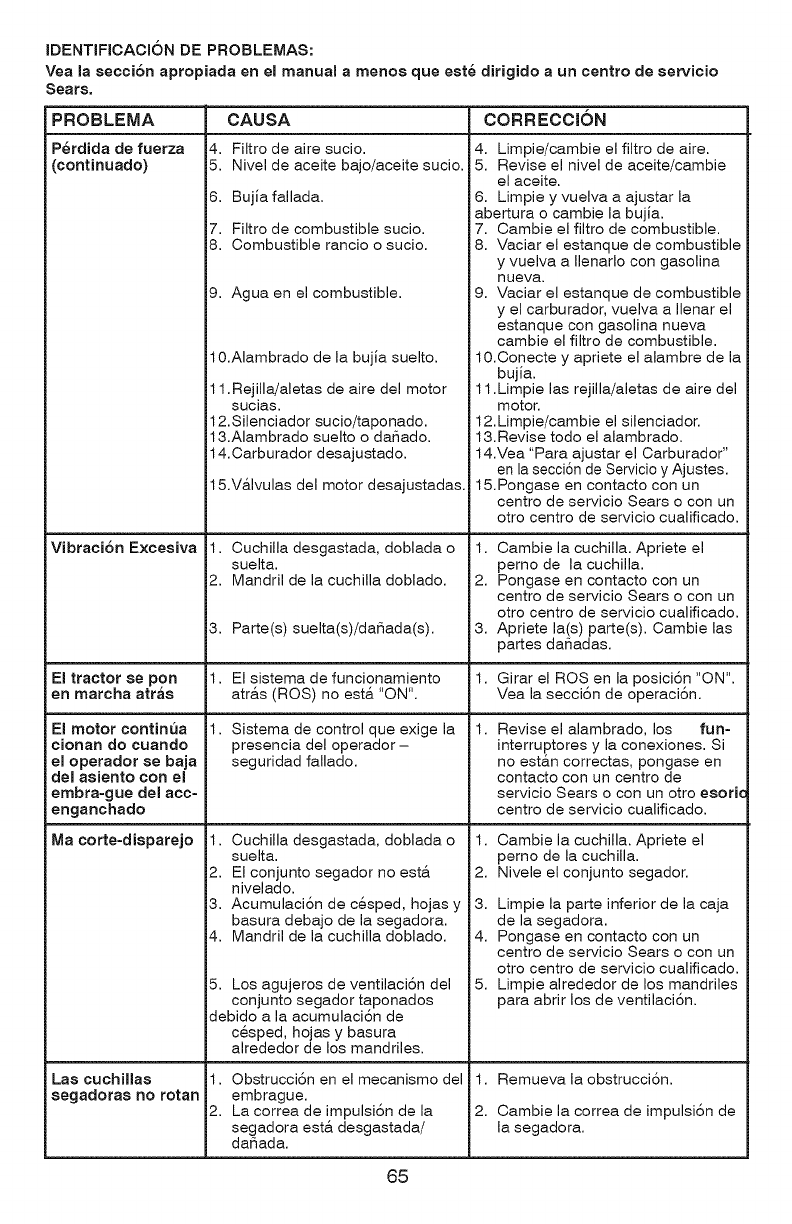
IDENTIFICACI6N DE PROBLEMAS:
Yea la seccJ6n apropJada en eJ manual a menos que este dirJgido a un centro de servJcJo
Sears,
PROBLEMA
Perdida de fuerza
(continuado)
Vibraci6n Excesiva
El tractor se port
en marcha atras
El motor continua
cionan do cuando
el operador se baja
del asiento con el
embra-gue del acc=
enganchado
Ma corte-dJsparejo
Las cuchillas
segadoras no rotan
CAUSA
4. Filtro de aire sucio.
5. Nivel de aceite bajo/aceite sucio.
6. BujJa fallada.
7. Filtro de combustible sucio.
8. Combustible rancio o sucio.
9. Agua en el combustible.
10.Alambrado de la bujJa suelto.
11 .Rejilla/aletas de aire del motor
sucias.
12.Silenciador sucio/taponado.
13.Alambrado suelto o daSado.
14.Carburador desajustado.
15.V&lvulas del motor desajustadas.
1. Cuchilla desgastada, doblada o
suelta.
2. Mandril de la cuchilla doblado.
3. Parte(s) suelta(s)/da_ada(s).
1. El sistema de funcionamiento
atr&s (ROS) no est& "ON".
1. Sistema de control que exige la
presencia del operador -
seguridad fallado.
1. Cuchilla desgastada, doblada o
suelta.
2. El conjunto segador no est&
nivelado.
3. Acumulaci6n de cesped, hojas y
basura debajo de la segadora.
4. Mandril de la cuchilla doblado.
5. Los agujeros de ventilaci6n del
conjunto segador taponados
debido a la acumulaci6n de
cesped, hojas y basura
alrededor de los mandriles.
1. Obstrucci6n en el mecanismo del
embrague.
2. La correa de impulsi6n de la
segadora est& desgastada/
da_ada.
CORRECCJON
4. Limpie/cambie el filtro de aire.
5. Revise el nivel de aceite/cambie
el aceite.
6. Limpie y vuelva a ajustar la
abertura o cambie la bujJa.
7. Cambie el filtro de combustible.
8. Vaciar el estanque de combustible
y vuelva a Ilenarlo con gasolina
nueva.
9. Vaciar el estanque de combustible
y el carburador, vuelva a Ilenar el
estanque con gasolina nueva
cambie el filtro de combustible.
10.Conecte y apriete el alambre de la
bujJa.
11 .Limpie las rejilla/aletas de aire del
motor.
12.Limpie/cambie el silenciador.
13. Revise todo el alambrado.
14.Vea "Para ajustar el Carburador"
en la secci6n de Servicio y Ajustes.
15.Pongase en contacto con un
centro de servicio Sears o con un
otro centro de servicio cualificado.
1. Cambie la cuchilla. Apriete el
perno de la cuchilla.
2. Pongase en contacto con un
centro de servicio Sears o con un
otro centro de servicio cualificado.
3. Apriete la(s) parte(s). Cambie las
partes da_adas.
1, Girar el ROSen la posici6n "ON".
Vea la secci6n de operaci6n.
1, Revise el alambrado, los fun-
interruptores y la conexiones. Si
no est&n correctas, pongase en
contacto con un centro de
servicio Sears o con un otro esorJG
centro de servicio cualificado.
1,
2.
3.
4.
5,
Cambie la cuchilla. Apriete el
perno de la cuchilla.
Nivele el conjunto segador.
Limpie la parte inferior de la caja
de la segadora.
Pongase en contacto con un
centro de servicio Sears o con un
otro centro de servicio cualificado.
Limpie alrededor de los mandriles
para abrir los de ventilaci6n.
1. Remueva la obstrucci6n.
2. Cambie la correa de impulsi6n de
la segadora.
65
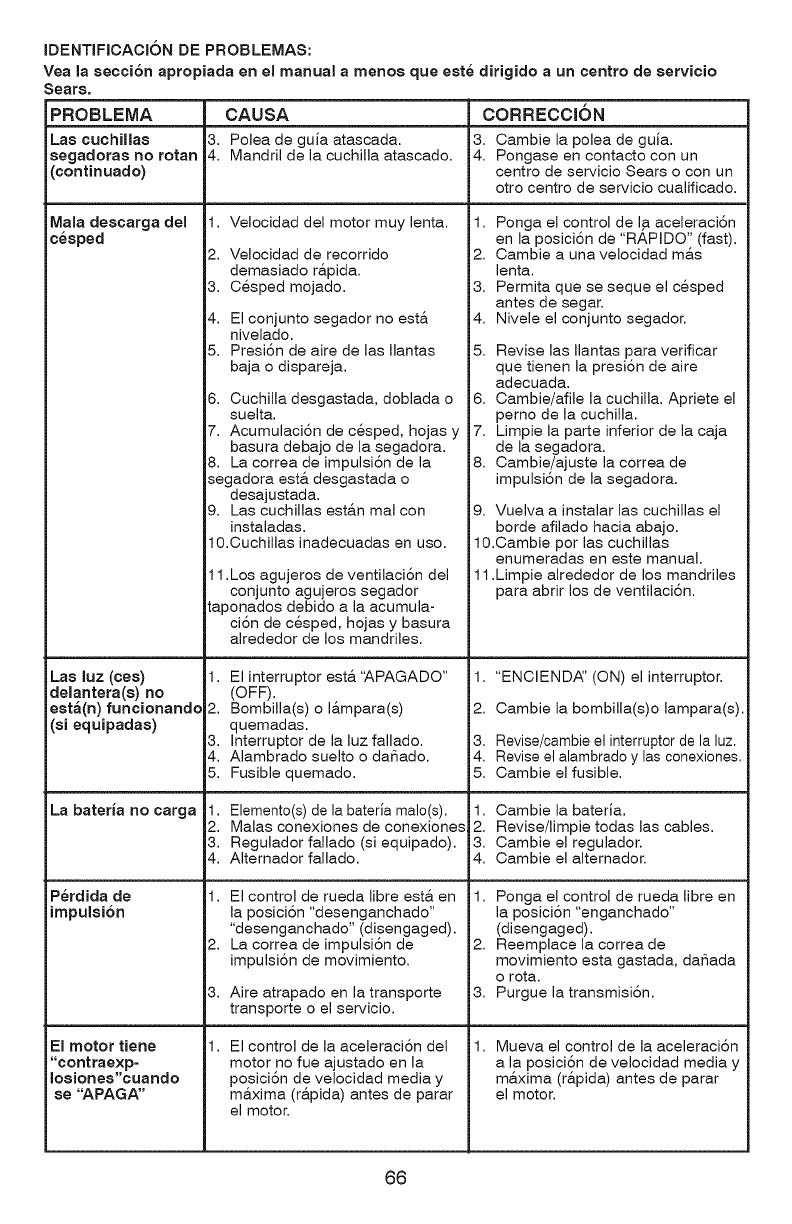
IDENTIFICACI6N DE PROBLEMAS:
Yea la seccJ6n apropJada en eJ manual a menos que este dJrJgido a un centro de servJcJo
Sears,
IPROBLEMA CAUSA CORRECCION
Las cuchillas 3. Polea de guia atascada. 13. Cambie la polea de guia.
segadoras no rotan 4. Mandril de la cuchilla atascado. 4. Pongase en contacto con un
(continuado) centro de servicio Soars o con un
otro centro de servicio cualificado.
1. Velocidad del motor muy lenta.Mala descarga deJ
cesped
Las luz (ces)
deJantera(s) no
esta(n) funcionand¢
(si equipadas)
ILa bateria no carga
Perdida de
jimpuisi6n
IEI motor tiene
i"contraexp-
IJosiones"cuando
se "APAGA"
2. Velocidad de recorrido
demasiado r&pida.
3. Cesped mojado.
4. El conjunto segador no est&
nivelado.
5. Presi6n de aire de las Ilantas
baja o dispareja.
6. Cuchilla desgastada, doblada o
suelta.
7. Acumulaci6n de cesped, hojas y
basura debajo de la segadora.
8. La correa de impulsi6n de la
segadora est& desgastada o
desajustada.
9. Las cuchillas est&n mal con
instaladas.
10.Cuchillas inadecuadas en uso.
11 .Los agujeros de ventilaci6n del
conjunto agujeros segador
taponados debido a la acumula-
ci6n de cesped, hojas y basura
alrededor de los mandriles.
1. El interruptor est& 'APAGADO"
(OFF).
2. Bombilla(s) o I&mpara(s)
quemadas.
3. Interruptor de la luz fallado.
4. Alambrado suelto o daSado.
5. Fusible quemado.
1. Elemento(s) de la bateria malo(s).
2. Malas conexiones de conexiones
3. Regulador fallado (si equipado).
4. Alternador fallado.
1,
2.
3.
El control de rueda libre est& en
la posici6n "desenganchado"
"desenganchado" (disengaged).
La correa de impulsi6n de
impulsi6n de movimiento.
Aire atrapado en la transporte
transporte o el servicio.
El control de la aceleraci6n del
motor no fue ajustado en la
posici6n de velocidad media y
m&xima (r&pida) antes de parar
el motor.
1. Ponga el control de I,a aceleraci6n
en la posici6n de "RAPIDO" (fast).
12. Oambie a una velocidad m&s
lenta.
13. Permita que se seque el cesped
antes de segar.
4. Nivele el conjunto segador.
15. Revise las Ilantas para verificar
que tienen la presi6n de aire
adecuada.
16. Cambie/afile la cuchilla. Apriete el
perno de la cuchilla.
7. Limpie la parte inferior de la caja
, de la segadora.
i8. Cambie/ajuste la correa de
impulsi6n de la segadora.
19. Vuelva a instalar las cuchillas el
borde afilado hacia abajo.
10.Cambie por las cuchillas
enumeradas en este manual.
111.Limpie alrededor de los mandriles
para abrir los de ventilaci6n.
1. "ENCIENDA:' (ON) el interruptor.
12.Cambie la bombilla(s)o lampara(s).
13. Revise/cambie el interruptor de la luz.
4. Revise el alambrado y las conexiones.
5. Cambie el fusible.
11. Cambie la bateria.
j2. Revise/limpie todas las cables.
13. Cambie el regulador.
14. Cambie el alternador.
11. Ponga el control de rueda libre en
la posici6n "enganchado"
I (disengaged).
12. Reemplace la correa de
movimiento esta gastada, da_ada
o rota.
13. Purgue la transmisi6n.
Mueva el control de la aceleraci6n
a I,a posici6n de velocidad media y
maxima (r&pida) antes de parar
el motor.
66
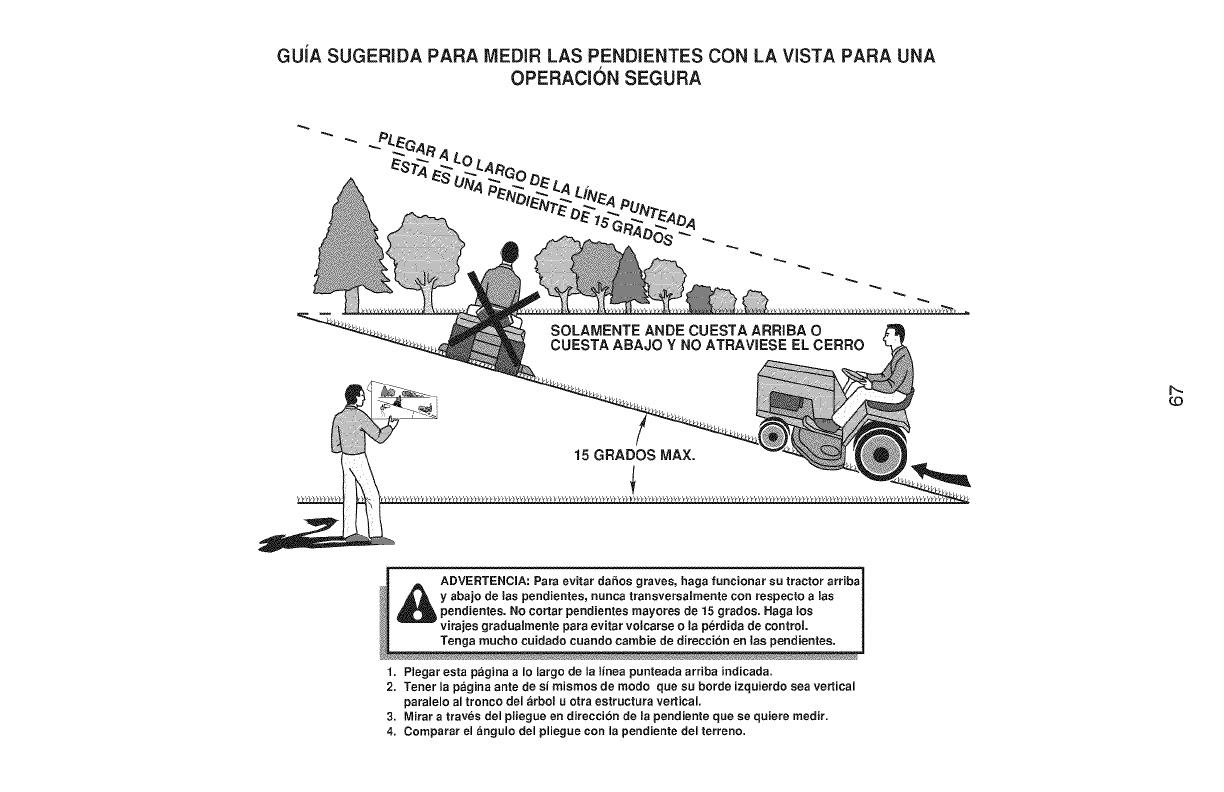
GUJASUGERiDAPARAMEDIR LAS PENDIENTES CON LA VISTA PARA UNA
OPERACION SEGURA
r_
J _ ADVERTENCIA: Para evitar dafios graves, haga funcionar su tractor arriba
_1 _ y abajo de las pendientes, nunca transversalmente con respecto alas
Bpendientes. No cortar pendientes mayores de 15 grados. Haga los
virajes gradualmente para evitar volcarse o la perdida de control.
Tenga mucho cuidado cuando cambie de direccion en las pendientes.
1. Plegar esta pagina a Io largo de la linea punteada arriba indicada.
2. Tenet la pagina ante de si mismos de modo que su borde izquierdo sea vertical
paralelo al tronco del arbol u otra estructura vertical.
3. Mirar a traves del pliegue en direccion de la pendiente que se quiere medir.
4. Comparar el angulo del pliegue con la pendiente del terreno.
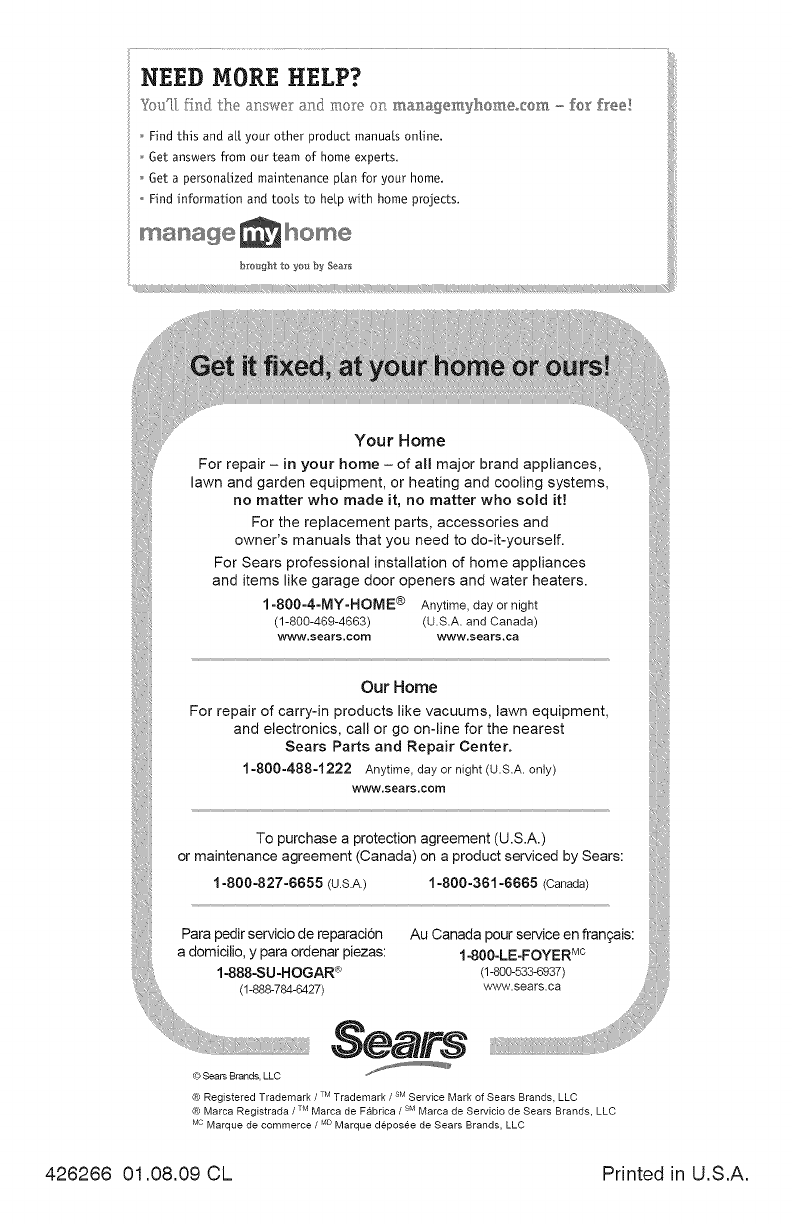
Your Home
For repair -in your home - of all major brand appliances,
lawn and garden equipment, or heating and cooling systems,
no matter who made it, no matter who sold it!
For the replacement parts, accessories and
owner's manuals that you need to do-it-yourself.
For Sears professional installation of home appliances
and items like garage door openers and water heaters.
1-800-4-MY-HOME e Anytime, day or night
(1-800-469-4663) (U.S.A. and Canada)
www.sears.com www.sears.ca
Our Home
For repair of carry-in products like vacuums, lawn equipment,
and electronics, call or go on-Nne for the nearest
Sears Parts and Repair Center.
1-800-488-1222 Anytime, day or night (U.S.A. only)
vczcw.sears.com
To purchase a protection agreement (U.S.A.)
or maintenance agreement (Canada) on a product serviced by Sears:
1-800-827-6655 (U.S.A.) 1-800-361-6665 (Canada)
Para pedirservicio de reparacion
a domicilio,y paraordenar piezas:
1-888_U-HOGAR _
(1"688-784"6427)
Se /rs
(oSearsBrands,LLC t_
® Registered Trademark /TMTrademark /SMService Mark of Sears Brands, LLC
® Marca Registrada /TMMarca de Fabrica /s_ Marca de Servicio de Sears Brands, LLC
MCMarque de commerce /_DMarque deposee de Sears Brands, LLC
Au Canada pour service en fran_,ais:
1-80O-LE-FOYER Mc
(1-800-533.6937)
www.sears.ca
426266 01.08.09 CL Printed in U.S.A.